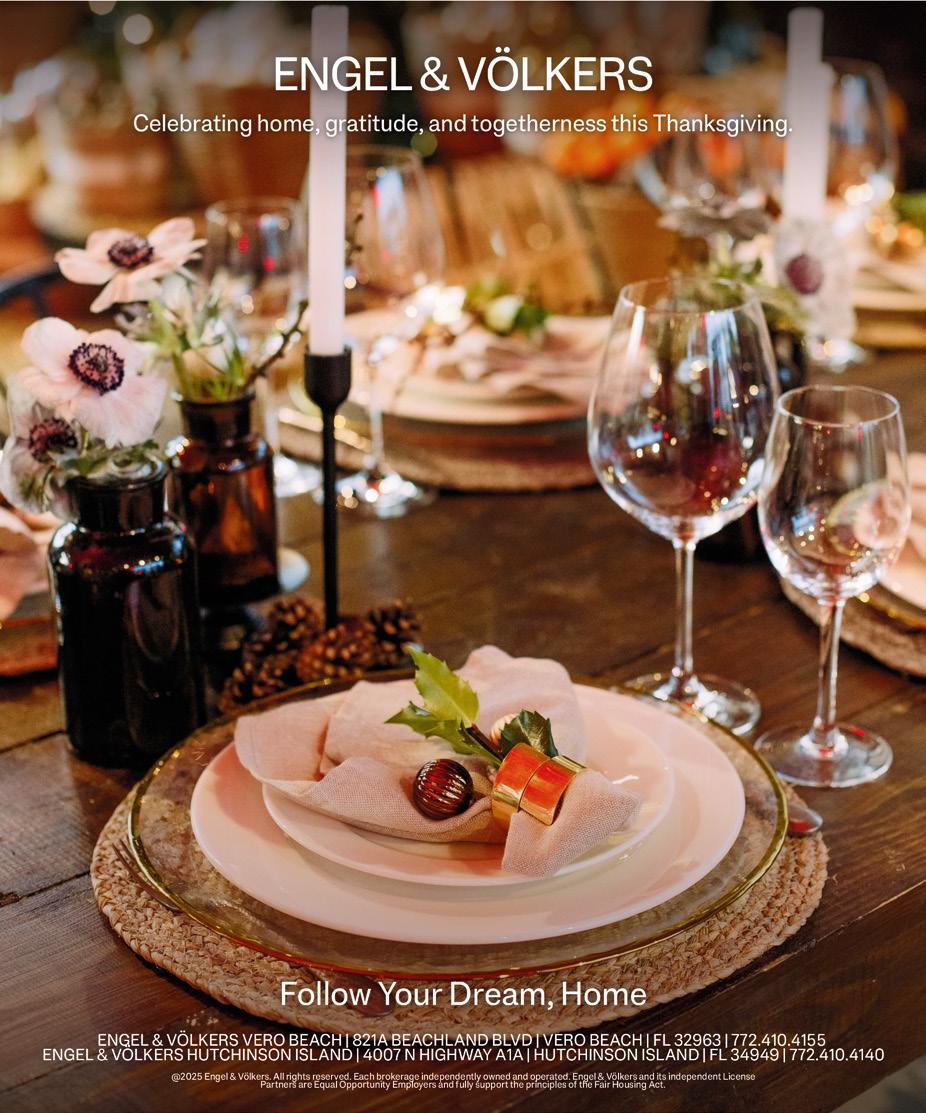
FALL
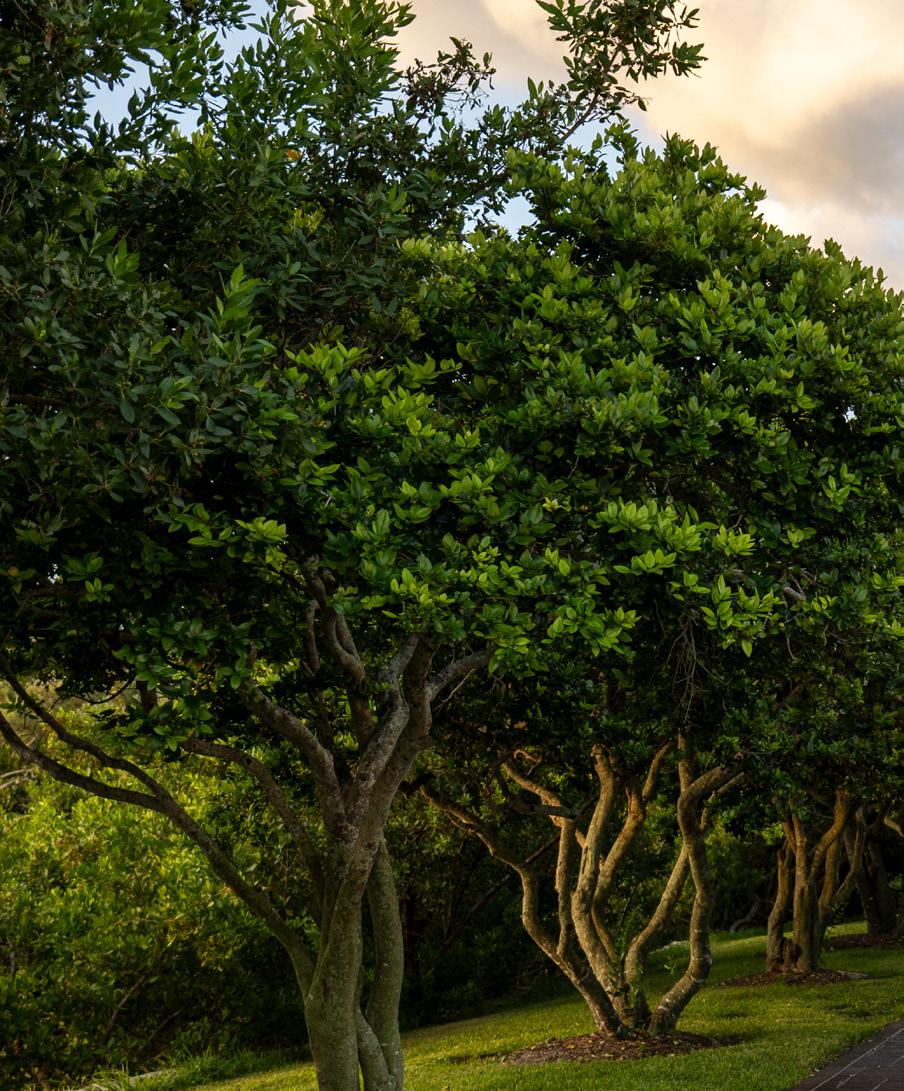


FALL

We hold these truths to be self-evident, that all men are created equal, that they are endowed by their Creator with certain unalienable Rights, that among these are Life, Liberty and the pursuit of Happiness.
The Declaration of Independence In Congress, July 4, 1776
I have a dream that my four little children will one day live in a nation where they will not be judged by the color of their skin but by the content of their character. I have a dream today . . . little black boys and black girls will be able to join hands with little white boys and white girls as sisters and brothers.
Dr. Martin Luther King Jr.
I Have a Dream Speech
Delivered August 28, 1963, Lincoln Memorial, Washington, D.C.
It is rather for us to be here dedicated to the great task remaining before us — that from these honored dead we take increased devotion to that cause for which they gave the last full measure of devotion — that we here highly resolve that these dead shall not have died in vain — that this nation, under God, shall have a new birth of freedom — and that government of the people, by the people, for the people, shall not perish from the earth.
President Abraham Lincoln
The Gettysburg Address
Delivered November 19, 1863, dedication of the Soldiers’ National Cemetery, Gettysburg, Pennsylvania

Veterans Memorial Island Sanctuary


For over 30 years, Caldwell Trust Company has provided personal, traditional, and independent trust services. Our team offers a full range of integrated services, tailored to your individual priorities, to help you enhance and protect your legacy for generations to come. With headquarters on the west coast in Venice and offices throughout Florida, we look forward to serving the area’s growing demand for expert, relationship-driven wealth management services.






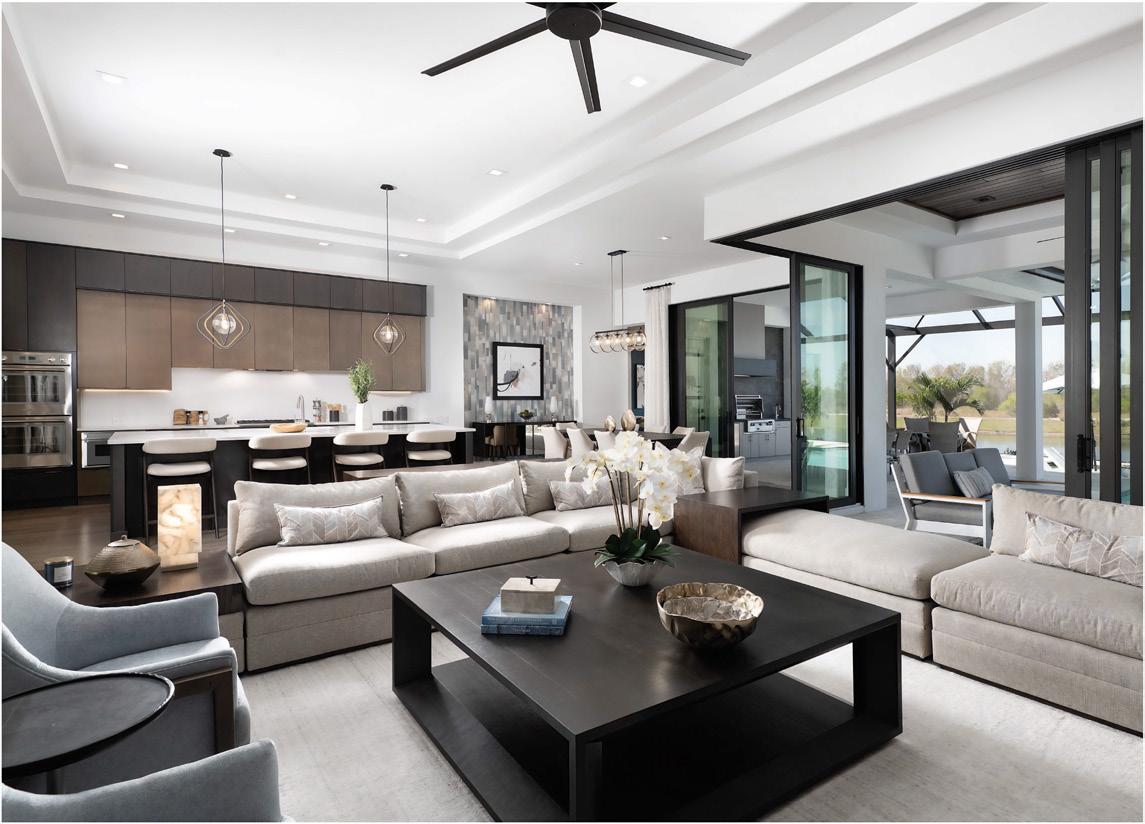

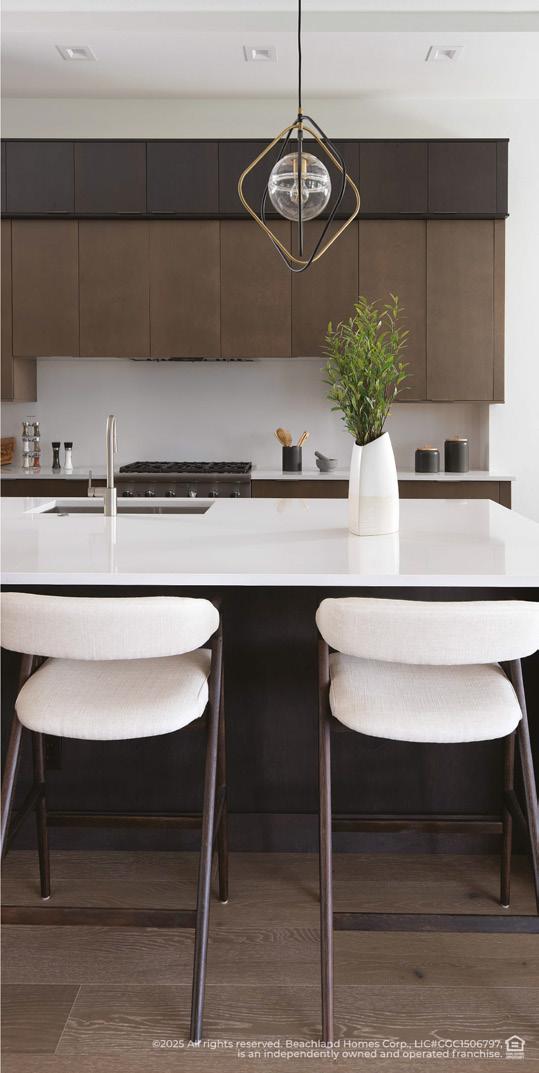

“ENTERTAINING WELL IS NOT ABOUT PERFECTION—IT’S ABOUT GENEROSITY OF SPIRIT.”
—Colin Cowie, South African–born lifestyle expert, event planner, designer.
12
Editors’ Letter
PIECES of the larger whole
20 Wireless LED sconces make installation a breeze, allowing every home to have these lighting enhancements.
HOME STYLES
24
Mid-Century Modern
Revered by most, a uniquely American adaptation of the high European International Style.
ENTERTAIN
30 The November Table
Coastal elegance in green and white.
ENTERTAIN
34 Wine Pairings from California
A selection of superb fall wines and food from the owners of Varietals and More.
ENTERTAIN
38 The Art of the Pause
Enjoy a glass before the glasses amidst the rush of entertaining.
ENTERTAIN
40 Tunes for the Table
Crafting the perfect dinner party playlist to set the mood, serve the meal, let the music linger.
ENTERTAIN
44 Finding Fall’s Boldest Blooms
A floral journey in NYC conducted by elite floral designer Stefan Handl.
ON THE TOWN
48 Atmosphere at Vero
Music, food, and family with a loving vibe—a celebration of the possible.
HOME
54 906 Seagrape Lane
Spanish Revival meets modern luxury in Riomar. Property presented by O’Dare Boga Dobson Group.

















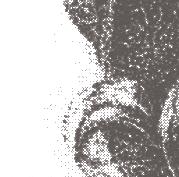



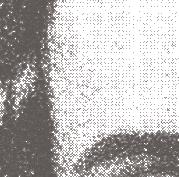
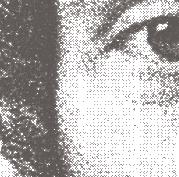



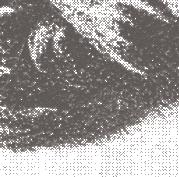






















Elevated interiors with timeless elegance and vibrant character. Full-service design for homes and condos — from Vero Beach to Nantucket and beyond.
4625 HIGHWAY A1A, STE 8
Vero Beach, FL 32963
Monday through Friday 9am – 5pm (772) 231-3746
Nantucket Interior Design Office – by appointment only –(508) 844-9350
www.alexandranuttall.com
Staging by Tiffani Buckley Home
Instagram: @tiffanibuckleyhome
Website: tiffanibuckleyhome.com
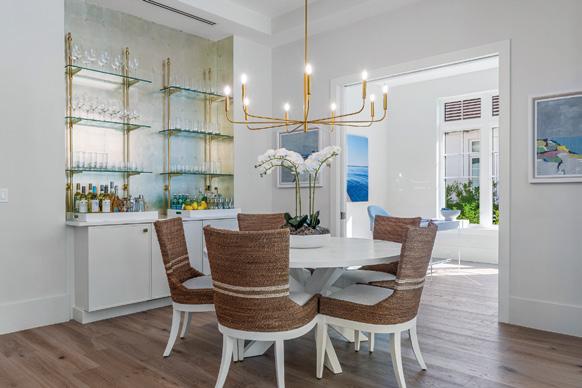







CABINETRY
62 Distinctive Cabinetry Designs
Christiana Lipscombe delivers craftsmanship and customer service for residential and commercial markets
KITCHEN
64 Cook Smarter
How induction cooking transforms your kitchen.
FASHION
68 Fall Fashion Intersects
Coastal Grace
Where global runway trends meet Vero Beach style.
ARTIST TO ARTIST
74 The Unseen Artist
René Guerin lets her art define her presence.
TRIBUTE TO MILITARY VETERANS
80 Personal Reflections
What the nation owes those who serve.
TRIBUTE TO MILITARY VETERANS
86 Images of War
Photojournalism that you never forget.
HEALTH AND WELLNESS
92 Primer on Concierge Medicine
A new and growing physician practice model.
HEALTH AND WELLNESS
94 Concierge Cardiology
Dr. Vikranth Gongidi charts a viable new approach to concierge medicine.
HEALTH AND WELLNESS
98 Lung Cancer
Awareness Month
Dr. Diego Maldonado speaks to the critical importance of screening to patient survival.
SPORT
104 Rebirth of Vero Club Tennis
Kaye Manly brings a storied tennis club into the modern era.
EDUCATION
112 Learning in the Spotlight
How one first grade teacher turns lessons into a musical celebration.
ART
114 LIV VERO Gallery 1
Artist René Guerin.
TR AVEL
118 Beneath the Calabrian Sun
Mark Wygonik returns to his ancestral home.
TRANSFORMATIVE FOOD
124 Treasure Coast Shellfish
Nicolette Mariano harvests her Eastern oysters, completing a cycle of artisanal farming.
130 Mark Your Calendar
136 Finito
Livvero.com @livveromagazine
Subscriptions at www.livvero.com 10 issues: $45.
Be heard: We want to know what you think and how we can serve you better.
Send comments to Jim Field at jim@livvero.com.


We have a lot of things to say at LIV VERO Magazine through our writing and photography. The page count of the magazine has expanded steadily to reach an ideal number. Similarly, we continue to broaden the subject matter we cover— recently health and wellness, travel, the surfing scene, and serious issues, such as commentary on our military veterans in this issue.
The printed magazine, however, isn’t our sole medium. We are equally committed to creating an intelligent, dynamic, and vibrant digital presence on social media to complement and enhance the printed page—recrafting the message, presenting new photographs—and importantly, bringing the subject matter and protagonists to life using video content, beautifully produced.
Social media—specifically, Instagram and Facebook—are a blessing and challenge. In the positive camp, they are brilliant visual communication channels reaching out to massive numbers of avid content
consumers. Conversely, they must be fed constantly (feed the beast!), which can be challenging for private individuals and small businesses alike.
Because of this, the amount, quality, and frequency of postings can often be inconsistent, as available time and interest levels vary. For businesses that choose to contract out this content creation—seeing it as a costly but easier way to establish a social media presence—oftentimes what gets produced is underwhelming.
Add to this that video is now all the rage— really becoming an expected requirement by viewers who want to see things move— especially people—they want “real life” brought to their screens, still photos no longer sufficing. Yet video is difficult and expensive to capture, produce, and get exactly right—far less forgiving than stills, which amateurs can excel at.
Against all this, LIV VERO Magazine is investing measurably in its digital channels, with the goal to be a leading presence. These are invaluable outlets
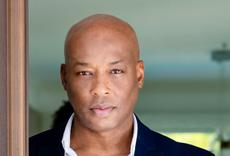
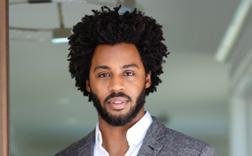
for the large amount of content we are creating—far overwhelming what we could possibly place in the magazine we seek to create. Furthermore, we want every printed article to have its digital companion—two halves of a story contributing to a large whole.
Please follow us on Instagram and Facebook. Track our progression. Enjoy the content. And soak in the videos which, for some, we want to elevate to an artistic level—doing the hard work and investment required.
We close, thanking readers for your interest in us, thanking our advertising partners for supporting us—making it all possible.




Exceptional Properties. Extraordinary Lifestyle.
Innovation and People have always been at the heart of the O’Dare Boga Dobson success story.






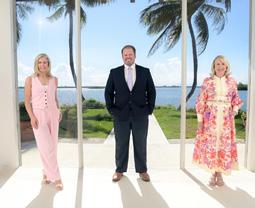

Magazines mailed to EVERY residence in Indian River County (all 8 zip codes) with incomes equal to or greater than $200,000.
Electronic Edition sent to curated, expanding list of over 3,200 email addresses.
Hand delivery of 1,500 copies to advertising partners, other businesses, organizations, individuals—including hotels, airport, restaurants, real estate offices, physician offices, country clubs, drop points.
Electronic Edition, in full, is accessible to all on our website livvero.com.
Building list of subscribers locally and across country to primary/secondary residences. Subscribe at livvero.com.
LIV VERO® Magazine is a registered trademark of Orchid Island Publishing Group LLC.
© 2025 Orchid Island Publishing Group LLC. All rights reserved. Reproduction or distribution of any content without express written consent is prohibited.
CO-PUBLISHER | CO-EDITOR
Jim Field jim@livvero.com
Diane Field diane@livvero.com
CREATIVE DIRECTOR
Chris Foster
ASSISTANT CREATIVE DIRECTOR
Joshua McMiller
EDITORIAL
CONTRIBUTING WRITERS
Renee Morad, Amanda Blumberg, Diane Field, Chris Foster, Joshua McMiller, Jim Field
ART
CONTRIBUTING PHOTOGRAPHERS
Yuri Semenyuk, New York Victoriya Knapp: realestatephotographybyvictoriya.com
ADVERTISING AND EVENTS
703-851-0703
DIGITAL
WEBSITE: livvero.com INSTAGRAM: @livveromagazine
ORCHID ISLAND PUBLISHING GROUP LLC Vero Beach, FL 32963 President | Jim Field
SUBSCRIPTIONS 10 issues: $45. Subscribe at www.livvero.com
POSTMASTER
SEND ADDRESS CHANGES TO: Orchid Island Publishing Group 3320 Cardinal Dr., Suite 648175 Vero Beach, FL 32963
LOCALLY OWNED & OPERATED
LIV VERO MAGAZINE: File No.: 440381.1 Serial No.: 98525418 (ISSN# pending) is published ten times per year by Orchid Island Publishing Group, 32963.
SUBSCRIPTIONS: Free of charge to qualified residents of Vero Beach. Publisher reserves the right to determine qualifications. Annual subscriptions: U.S. and possessions $45, all other countries $125 U.S. funds (via air mail). Single copies: U.S. and possessions $5. No part of this publication may be reproduced without the written consent of the publisher. The publisher does not warrant, either expressly or by implication, the factual accuracy of any advertisements, articles or descriptions here in, nor does the publisher warrant the validity of any views or opinions offered by the authors of said articles or descriptions. The opinions expressed are those of the individual authors, and do not necessarily represent the opinions of Orchid Island Publishing Group. Orchid Island Publishing Group makes no representation or warranties regarding the accuracy or appropriateness of the advice or any advertisements contained in this magazine.
SUBMISSIONS: We welcome submissions. Unless otherwise negotiated in writing by the editors, by sending us your submission, you grant Orchid Island Publishing Group permission by an irrevocable license (with the right to license to third parties) to edit, reproduce, distribute, publish, and adapt your submission in any medium on multiple occasions. Submissions will not be returned.

•
•
•
•
•
•
•





by Diane Field
Rooms look so much better with wall sconces. Dining rooms, living rooms, bedrooms, hallways—everywhere really. Wall sconces can be entirely decorative—dazzling the eye, creating a mood—functional—replacing the need for a bedside lamp—or both. They lend a sophisticated, stylish, finished look to a space.
However, the classic problem with wall sconces—indeed, the reason why most homes don’t have them—is that they had to be hardwired, meaning hiring an electrician, tearing up your walls, installing a dedicated light switch. Alternatively, there was an option to use a model featuring a cord—encased in a plastic tube—that dropped vertically to the floor, hopefully near an outlet. Yet these implied “too cheap to do it properly.”
How times have changed—for the better! Today, every homeowner can effortlessly install sconces throughout their home using simple tools—even no tools needed. The key breakthrough has been batterypowered sconces, utilizing energy-efficient LED lights, available in a variety of materials and styles.
Early civilizations (Rome, Greece, Egypt) used wall-mounted torches to illuminate corridors and rooms. Medieval castles and churches fashioned wrought iron sconces for torches and candles with rudimentary decorative designs. During the 15th through 17th centuries, sconces transcended mere light sources to become ornate decorative art, utilizing bronze, brass, gilded wood, painted motifs, and mirrors placed behind candles to amplify projected light. During the 18th and 19th centuries, sconces became common in European and American homes. Gaslight fixtures included glass shades for safety. With electrification, the use of sconces in homes proliferated, their designs corresponding to distinct architectural styles—e.g., Arts & Crafts, Art Deco, MidCentury Modern.
Sconces have largely disappeared from contemporary residences because of the requirement to hardwire the fixtures— in general, they were included in new construction or added during major renovation, but rarely introduced as a stand-alone—and costly—improvement. Today, battery-powered and rechargeable (similar to a smart phone) models
eliminate the need to hardwire. In addition, wall mounting is easily accomplished using adhesive tape or a simple bracket (two screws with wall anchors). Styles range from traditional candle reproductions to modernist designs— online sources offer hundreds of products.
Consistent with the evolution of lighting in general, sconces can be used specifically as decorative pieces in interior design, as functional lighting (task, reading), or combined. Each year more and more wireless models become available as consumer interest grows. Notably, with the advent of advanced LED light sources and smart technologies, many sconces come with remote controllers, offering dimming capabilities, timers, colored lights.

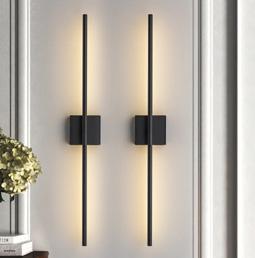
Wells Fargo Advisors Financial Network, LLC (WFAFN), Member SIPC, a registered broker-dealer and non-bank affiliate of Wells Fargo & Company. WFAFN uses the trade name Wells Fargo Advisors. Ad.
Contact Us
3387 Ocean Drive
Vero Beach, Florida
(772) 200-3973
jenna.suleman
razvan.ilie@wfa net.com






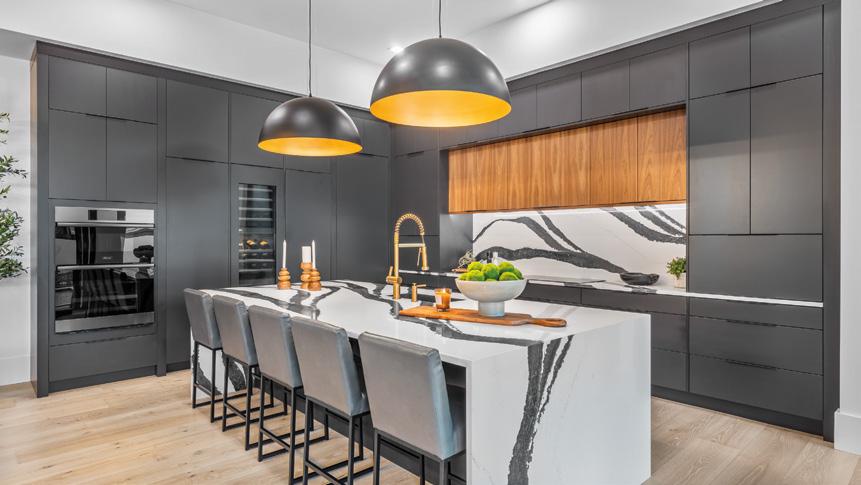



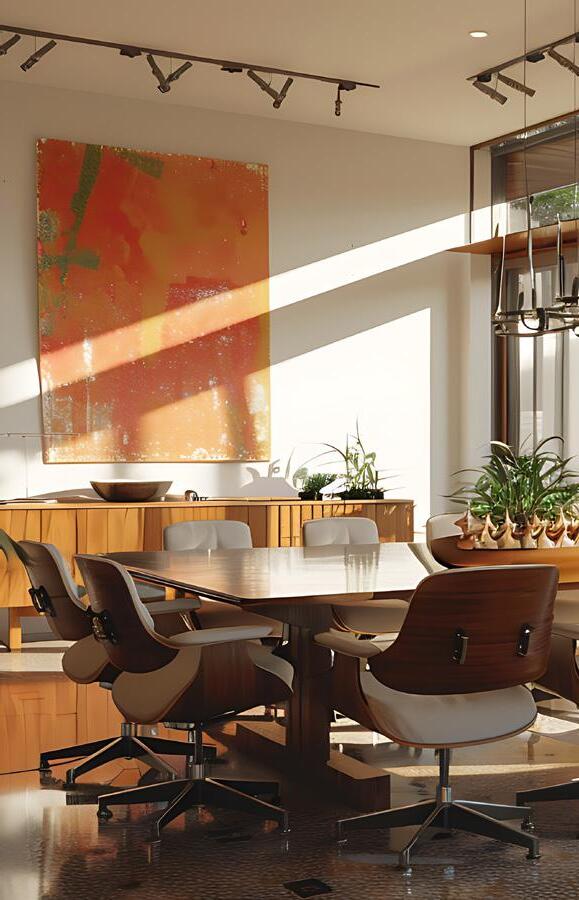
A
by Jim Field
Modern architecture is an evolutionary design philosophy. In our October issue, we profiled its origination with the International Style of Modern Architecture—a European invention germinating in the 1920s, introduced to the U.S. by MOMA’s 1932 groundbreaking event “Modern Architecture: International Exhibition.”
In September we looked at Tropical Modernism, a mid-century adaptation of the International Style by local architects—in South Asia, the Caribbean, Latin America and Africa—to tropical weather conditions, indigenous materials, folk building traditions, and cultural influences.
This article, in turn, introduces another major derivative of the International Style, termed Mid-Century Modern, which was principally a U.S.-centric adaption, becoming well known and beloved by generations of American homeowners.
Mid-Century Modern architecture developed after World War II between (roughly) 1945-1965, its most notable examples built in the U.S. Its cultural impetus was the post-war period of optimism, rapid economic growth, new suburban communities, and new (wartime developed) building technologies.
Importantly, Mid-Century Modernism took off in regions with warmer climates— California the perfect example—which facilitated the full realization of indoor/ outdoor living. Photographers of the era— most notably, Slim Aarons—showcased exemplary examples of Mid-Century Modern residences in the pages of popular publications of the time, such as Look and Life magazines.
Readers of this column should not be surprised by the core philosophy and design features undergirding Mid-Century Modernism—given their direct lineage from the International Style:
• Clean and simple lines. Rectilinear (i.e., uncurving) geometric shapes.
• Harmony with nature. Glass walls, sliding doors to overflow exterior patios.
• Open interiors. Few load-bearing walls, high ceilings, large spaces.
• Flat or low-sloped roofs. Accentuating horizontal, geometric look.
• Natural and industrial materials. Native wood and stone mixed with concrete and steel.
Consistent with the formative precepts of modern architecture, Mid-Century Modernism emphasizes functionality, openness, and harmony with the environment, wherein beauty follows from proportion, space, and materials, not ornamentation.
However, whereas the International Style projected an austere, industrial, rigid, minimalistic look, Mid-Century Modern’s aesthetic emphasized openness to nature, harsh lines softened by natural materials, and a warm feel emanating from organic colors and comfortable,

informal furnishings. Notably, the scale of Mid-Century Modern residences was generally modest in size—the structure was meant to embrace, not overwhelm, the inhabitants.
In sum, the International Style objectified The Machine, whereas Mid-Century Modern reflected the relaxed progressivism of a young, wartested generation seeking innovative, stimulating, fun, high-tech homes suitable for entertaining and family living.
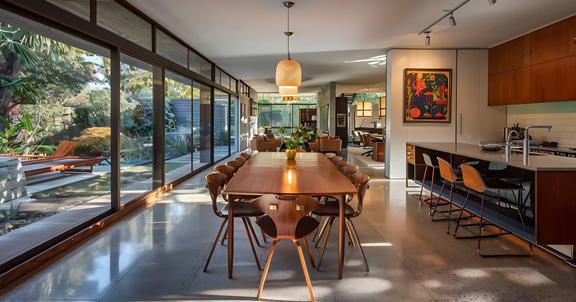
• Kaufmann Desert House by Richard Neutra, Palm Springs. 1946.
• Eames House (Case Study House #8) by Charles and Ray Eames, Pacific Palisades. 1949.
• Salzman House (Case Study House #16) by Craig Ellwood, Bel Air. 1953.
• Bailey House (Case Study House #21) by Pierre Koenig, Hollywood Hills. 1960.
Welcome to KMK Builders, where we combine refined craftsmanship with unparalleled dedication to transform your vision into a masterpiece. Located in Vero Beach, we specialize in bespoke home construction, renovation, and additions, delivering results that resonate with sophistication and excellence. With our meticulous approach, we turn dreams into stunning realities.

MICHAEL & KYLE KONDZIOLA
3201 Cardinal Drive, Vero Beach, FL 772-643-1353
kmkbuidersllc.com @kmkbuilders


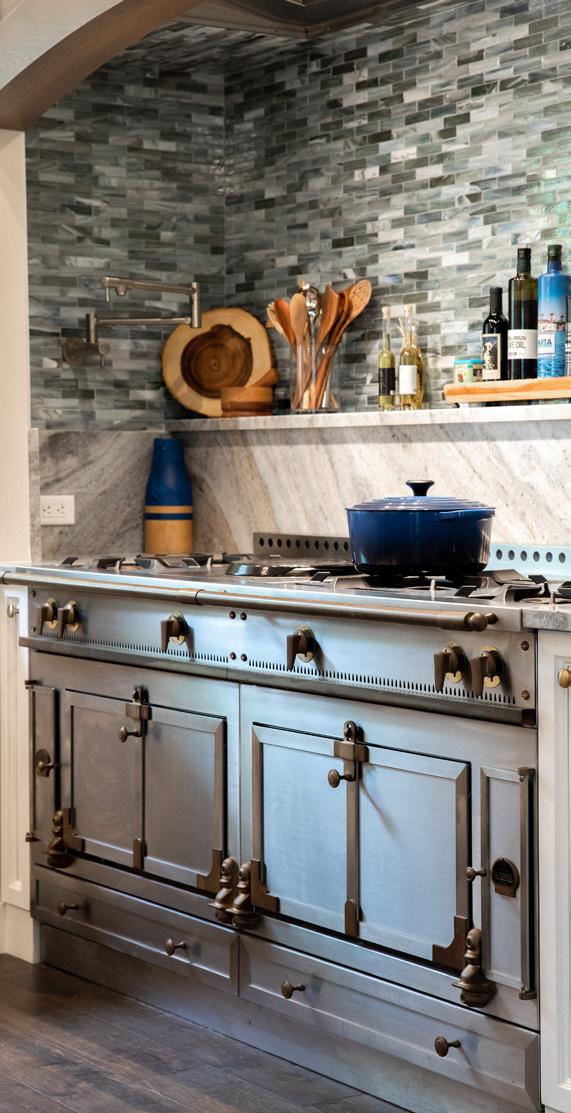

At KMK Builders, we believe the journey to your dream home should be as exceptional as the final result. Our process is built around a clientfocused approach that ensures each detail is carefully managed, from initial consultation to completion. Every step is designed to reflect your unique vision while upholding the highest standards of craftsmanship.



by Chris Foster photography by Yuri Semenyuk
Chris Foster redefines fall entertaining with sculptural white pumpkins, soft green hydrangeas, and the luminous glow of crystal and candlelight. This tablescape captures the elegance of the season with coastal sophistication.
As the season changes and the air cools, the heart of entertaining in Vero Beach shifts to the table—a space where stories unfold, glasses sparkle, and style blends with the art of gathering. This November, adopt a look that feels fresh, refined, and quietly luminous, combining white pumpkins, greenish-white hydrangeas, translucent green votive candles, and crystal for a setting that balances fall elegance with coastal serenity.
This season, let your table showcase a soft, tonal palette inspired by nature. Start with ivory linens as your base, then layer with Cabbage Beige (Branco) dinner plates by Bordallo Pinheiro— their sculpted shape adding texture and artistry without overshadowing the scene’s simplicity.
Accent the table with clear crystal glassware, which beautifully captures candlelight and enhances the setting’s elegant glow. The result is a table that feels luminous, layered, and perfectly suited to a coastal home.
White Pumpkins and Hydrangeas as the Centerpiece
For a centerpiece that feels organic and graceful, combine white pumpkins with greenish-white hydrangeas. Vary the size of your pumpkins, grouping them along the table’s center in soft clusters. Tuck hydrangea blooms between them—their lush texture and subtle tone adding a natural sense of abundance.
The harmony of smooth pumpkins, full hydrangeas, and shimmering crystal creates a visual rhythm that feels fresh and sculptural—a statement of elegance without excess.

Simplicity is Chic
In true coastal style, restraint is essential for elegance. Skip the chargers to spotlight the Bordallo Pinheiro plates. Their subtle beauty and organic details anchor the table, while the crystal accents add just the right touch of sparkle.
The overall feel is light, spacious, and balanced—proof that elegance can come from simplicity.
The Glow of Candlelight
To complete the setup, scatter translucent green votive candles throughout the centerpiece.

Their soft, diffused light complements the hydrangeas and adds warmth to the neutral palette. Include a few ivory or pale gold tapered candles in glass or brushedbrass holders for height and drama.
As the light hits the crystal and flickers across the pumpkins, it produces a peaceful, almost otherworldly glow—the signature of a beautifully arranged autumn table in Vero Beach.
At each place setting, place a miniature white pumpkin on a crisp linen napkin in ivory or pale wheat. This simple gesture ties the theme together and invites guests into the story of the table.
Every detail, from the shine of glass to the softness of candlelight, adds to a feeling of effortless grace—an invitation to stay, smile, and enjoy the evening.
Arrange your centerpiece the day before your gathering to allow the hydrangeas to settle naturally. A little preparation ensures that on the day of your event, you can focus on your guests—because the most memorable evenings are the ones that feel effortless.
This November, let your table tell a story of refined simplicity and coastal warmth: ivory linens, Bordallo Pinheiro dinnerware, white pumpkins, greenishwhite hydrangeas, translucent green votives, and crystal.
Together, they evoke an atmosphere that glows—timeless, serene, and perfectly suited for entertaining in Vero Beach. It’s a celebration of harmony, elegance, and the subtle craft of bringing people together well.
PEOPLE TOGETHER WELL.

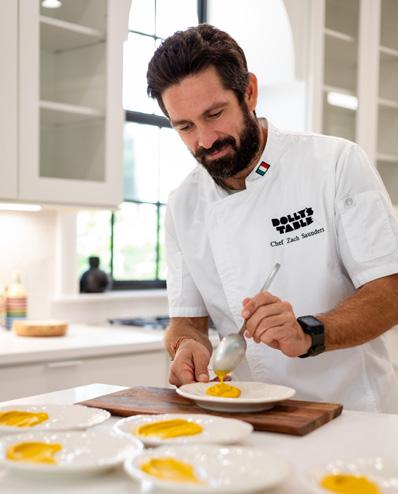
Roasted Delicata & Duck Rosette
Seared duck served over brown-butter–roasted delicata squash, finished with port reduction, pickled shallots, and a light crunch. An elegant expression of fall— refined, warm, and subtly bold.
Plating Tip from Chef Zach Saunders of Dolly’s Table
Serve each rosette on a small, warm plate to enhance the richness of the duck. Let the port reduction form a soft ribbon beneath the squash—not over it—so the textures stay prominent. Add a few pickled shallots and a carefully placed crisp garnish, almost like a piece of jewelry.
A composed plate with generous negative space feels luxurious—signaling to guests that this bite is meant to be savored.
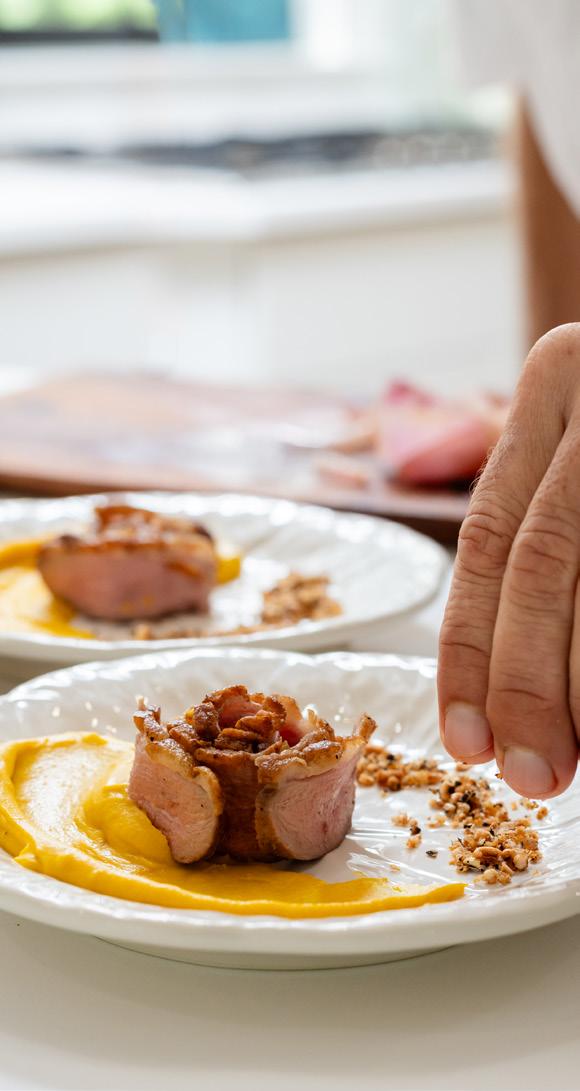

by Rob and Michele Wayne, owners of Varietals and More, photography by Yuri Semenyuk
As the weather cools and meals become more robust—roasts, whole poultry (turkey, duck, quail), squash, root vegetables, rich sauces—you will want to think about wine pairings, generally varietals and single-vineyard wines that have more body, more flavor, and more warmth to match. Pairing applies to both wine-to-wine, and wine-to-food.
Not to mention that fall brings cherished holidays focusing on family and friends, truly special entertaining occasions that always call for welcoming guests and priming conversations with a splash (or two) of bubbly—sparkling wine!
Schramsberg Blanc de Blancs

Schramsberg Vineyards, founded in 1862 in Napa Valley, is one of California’s most historic and celebrated sparkling wine producers. Best known for its Blanc de Blancs, made entirely from Chardonnay grapes using the traditional Champagne method, Schramsberg helped establish American sparkling wine on the world stage. With bright citrus
notes, crisp acidity, and elegant bubbles, Schramsberg Blanc de Blancs reflects both craftsmanship and California freshness. This sparkling wine brings an easy elegance to any occasion. Effervescent and full of life, it lifts the mood, turning ordinary moments into something worth remembering and every gathering into a quiet celebration.
Schramsberg Blanc de Blancs is made using the méthode traditionnelle, the same process used for Champagne. The wine is crafted entirely from Chardonnay grapes, hand harvested from coolclimate vineyards along California’s coast. After the first fermentation, the wine undergoes a second fermentation in the bottle, creating its fine bubbles naturally. It is then aged on the lees (spent yeast) for about two years, which adds depth, creaminess, and toasty brioche notes. Finally, the bottles are riddled and disgorged by hand, ensuring clarity and freshness before release.
It offers bright aromas of green apple and lemon zest with subtle notes of brioche. Crisp and lively on the palate, it balances
citrus and apple flavors with fine bubbles and a clean, refreshing finish.
Suggested Pairings
Brillat-Savarin is a decadent triple-cream cheese from Normandy, France, known for its soft rind and luscious, buttery texture. Elegant and indulgent. Serve with baguette.
Osetra Caviar is among the world’s finest, features firm, glistening pearls with a delicate, nutty richness. Sophisticated and luxurious, serve with blinis, kettle chips, or with a spoon!
Roasted Butternut Squash Crostini with Ricotta and Truffle Honey
• 1 small butternut squash, peeled and diced
• 2 tbsp olive oil
• 1 tsp fresh thyme leaves (plus extra for garnish)
• Salt and freshly ground black pepper, to taste
• 1 cup ricotta cheese
• 1 tbsp heavy cream
• 1 small baguette, sliced into ½-inch rounds
• 2 tbsp butter or olive oil (for brushing)
• Truffle honey, for drizzling
• A few crushed walnuts or pistachios for crunch

Preheat the oven to 400°F and toss diced butternut squash with olive oil, thyme, salt, and pepper. Roast for 20–25 minutes until tender and golden. Meanwhile, whip ricotta cheese with a splash of heavy cream until smooth and fluffy, seasoning lightly with salt. Slice a baguette into ½-inch rounds, brush with olive oil or butter, and toast at 375°F for about 8–10 minutes until crisp. To assemble, spread the whipped ricotta on each toast, top with roasted squash, and drizzle with truffle honey and nuts. Garnish with fresh thyme.

Kosta Browne is among the most celebrated producers of Pinot Noir in California, known for crafting wines that capture both the beauty and the drama of the Sonoma Coast. The region’s rugged terrain, cool Pacific breezes, and fog-laden mornings create ideal conditions for slow, even ripening—allowing the grapes to develop extraordinary depth and nuance while retaining their hallmark freshness.
This wine is a masterful blend sourced from a mosaic of coastal vineyards, each contributing its own personality. Some sites bring vibrant red fruit and floral aromatics, while others, grown closer to the ocean add savory earth tones and minerality.
Winemaking at Kosta Browne combines precision and patience. Grapes are hand harvested at night to preserve their delicate aromatics and fermented in small lots, often with a portion of whole clusters, as to build complexity and structure. After fermentation, the wine is aged in French oak barrels, roughly one-third new, for about 15 months, imparting gentle notes of vanilla, cedar, and spice without overshadowing the fruit.
The wine opens with a captivating nose of wild strawberry, crushed raspberry, and cherry compote layered with hints of rose petal, baking spice, and subtle forest notes. On the palate, it is graceful yet expressive—lush fruit framed by bright

acidity and silky tannins. The texture is supple and lingering, finishing with the kind of energy that defines cool climate Pinot at its best.
Suggested Pairings
Fromager d’Affinois with Truffle, RhôneAlps, France. A luscious double-cream French cheese layered with the earthy aroma of black truffle. Silky, buttery, and delicately nutty, it melts on the palate with a whisper of umami. Serve with toasted baguette, truffle honey, or roasted hazelnuts.
Wild Mushroom Crostini is fabulous:
Sautéed cremini and oyster mushrooms with garlic, shallot, and thyme on toasted baguette.
Walnut-Crusted Salmon
• 4 salmon fillets (about 6 oz each), skin removed
• ¾ cup finely chopped walnuts
• 2 tbsp panko breadcrumbs
• 1 tbsp fresh parsley, finely chopped
• 1 tsp Dijon mustard
• 1 tsp honey or maple syrup
• 1 tbsp olive oil or melted butter
• Salt and freshly ground black pepper, to taste
• Lemon wedges, for serving
Preheat oven to 400°F. Line a baking sheet with parchment. In a bowl, combine walnuts, panko, parsley, olive oil (or butter), Dijon, honey, salt, and pepper. Stir until the mixture holds together slightly. Pat fillets dry and season lightly with salt
and pepper. Spread the walnut mixture evenly over the top of each piece, pressing gently to help it adhere. Transfer to the oven and bake 10–14 minutes, depending on thickness, until the fish flakes easily and the crust is golden. Squeeze fresh lemon juice over the top before serving.
Leek Risotto
• 1 tbsp olive oil or butter
• 2 leeks, white and light green parts only, thinly sliced
• 1 cup Arborio rice
• ½ cup dry white wine
• 3½–4 cups chicken or vegetable broth (warm)
• ½ cup grated Parmesan Salt and pepper to taste
• A squeeze of lemon juice or sprinkle of zest
In a medium pot, heat olive oil or butter. Add leeks and cook 5–6 minutes until soft. Stir in Arborio rice and cook 1 minute to coat. Pour in wine and stir until absorbed. Stir in ½ cup of warm broth at a time, letting it absorb before adding more. Continue until the rice is creamy and tender, about 18–20 minutes. Stir in Parmesan, season with salt and pepper, and add lemon if desired.
Eberle Viognier

Eberle Winery stands as a true Paso Robles original—a place where passion, patience, and the California sun meet in every glass. Founded by pioneer winemaker Gary Eberle, it helped shape the region’s reputation for bold yet beautifully balanced wines. Beneath the rolling vineyards lie hand-dug limestone caves, where barrels rest in cool, quiet harmony until each vintage is ready to shine. From crisp Viognier to velvety Cabernet, Eberle wines tell the story of a winery built on heart, heritage, and an enduring love for the craft.
Eberle Viognier reflects the heart of Paso Robles—warm, expressive, and beautifully balanced. Aromatic and inviting, it embodies the sunshine and easy elegance of California’s Central Coast. With its smooth texture and graceful structure, this wine feels both vibrant and comforting, ideal for relaxed gatherings or quiet evenings. It is a reminder of how Eberle combines craftsmanship and character to create wines that are as genuine as the place they come from.
Tasting Notes
This beautiful wine opens with inviting aromas of honeysuckle, white peach, and apricot, accented by a touch of citrus and soft floral notes. The palate is rich yet balanced, with layers of ripe stone fruit and a smooth, lingering finish. Its bright freshness and round texture make it a wonderful match for roast turkey, as well as seafood, light pastas, and creamy cheeses.
Suggested Pairings
Aged Manchego with fig jam and Marcona almonds. The cheese’s nutty, slightly salty character contrasts beautifully with the wine’s soft, floral richness, while the fig jam adds a gentle sweetness that ties everything together.
Grilled Shrimp with lemon is a bright, simple pairing. The shrimp’s light char and citrus accent bring out the wine’s fresh, floral character, while its smooth texture complements the delicate sweetness of the seafood.


Brown Butter Citrus Turkey Breast
• 1 boneless turkey breast (about 2–3 pounds)
• 4 tbsp unsalted butter
• 1 tbsp olive oil
• Zest and juice of 1 orange
• Zest and juice of 1 lemon
• 1 garlic clove, minced
• 1 tbsp fresh thyme leaves
• Salt and freshly ground black pepper
• Garnish: orange slices, fresh thyme sprigs
Preheat oven to 375°F. Pat the turkey breast dry and season generously with salt and pepper. In a small saucepan, melt the butter over medium heat. Continue cooking until it turns golden brown and smells nutty, about 4–5 minutes. Remove from heat and stir in the olive oil, citrus juices and zest, garlic, and thyme. Place the turkey breast in a roasting pan or skillet and brush generously with the brown butter citrus mixture. Roast uncovered for about 45–60 minutes, basting every 15 minutes, until the internal temperature reaches 165°F. Let rest for 10–15 minutes before slicing. Spoon a little of the pan juices over the slices before serving.
Sweet Potato Dauphinois
• 2 lbs sweet potatoes, peeled and thinly sliced (about ⅛ inch thick)
• 1 cup heavy cream
• 1 cup whole milk
• 1 garlic clove, minced
• 2 tbsp unsalted butter, plus more for greasing
• ½ cup grated Gruyère
• Salt and freshly ground black pepper
• Nutmeg pinch on top
Preheat oven to 375°F. Butter a medium baking dish. In a saucepan, combine cream, milk, garlic, salt, and pepper. Heat gently until warm but not boiling. Arrange half of the sweet potato slices in the dish, slightly overlapping. Pour half the warm cream mixture over the top. Repeat with the remaining potatoes and cream. Dot with butter and sprinkle with cheese and nutmeg. Bake uncovered for 45–55 minutes, until the potatoes are tender and the top is golden and bubbling. Let rest 10 minutes before serving.
54 Royal Palm Pointe Vero Beach, FL 32960
772-217-2780
Instagram: @varietals Website: varietalsandmore.com

by Chris Foster photography by Yuri Semenyuk
In the rush of entertaining—setting the table, arranging flowers, lighting candles, and making sure every detail is just right— it is easy to forget to pause. That quiet moment before the doorbell rings, when everything is ready and the air remains calm.
Before the guests arrive, take a moment with the person you’re sharing the space with. Pour a glass of wine. Sit together. Exhale. It is not about ticking off one last item on the list; it is about reconnecting before the celebration starts.
This simple ritual—a glass before the glasses—reminds us that entertaining begins with love and intention. It is where warmth is created well before it is shared.
Because the art of a beautiful evening doesn’t start at the table—it starts in that quiet moment together, just before the night unfolds.
Male model wearing pieces provided by J.McLaughlin.
Female model wearing pieces provided by Sassy Boutique.


by Chris Foster
Set the mood. Serve the meal. Let the music linger.
Music is the invisible host of every gathering—it greets guests before the first glass is poured, lingers between courses, and sets the tone for a memorable evening. This November, as we gather around candlelit tables and embrace the season of entertaining, a curated playlist can turn dinner into a special experience.
Start with the Mood
The best dinner playlist flows like a wellplanned evening:
• Golden-Hour Arrival. Light jazz, acoustic bossa nova, or soulful instrumentals to warmly welcome guests.
• Dinner Conversation. Midtempo jazz vocals and modern classics to maintain the energy without overpowering the discussion.
• Dessert & Wind-Down. Smooth, soulful tracks that feel intimate— perfect for the last toast or latenight laughter.
This season, let Samara Joy set the mood. Her velvety jazz vocals feel timeless yet fresh, perfectly suited for candlelight and a glass of Pinot Noir. Tracks like “Can’t Get Out of This Mood” and “Guess Who I Saw Today” add warmth and sophistication that enhance any gathering.
A memorable playlist combines the familiar with the unexpected. Here are our favorite tracks to kick off the night:
• Samara Joy – “Can’t Get Out of This Mood”
• Norah Jones–“Come Away With Me”
• Leon Bridges – “Beyond”
• Ella Fitzgerald & Louis Armstrong – “Dream a Little Dream of Me”
• Gregory Porter – “Hey Laura”
• Melody Gardot – “Baby I’m a Fool”
• Michael Bublé – “L-O-V-E”
• Lake Street Dive – “Better Than”
• Diana Krall – “The Look of Love”
• Bill Withers – “Lovely Day”
Volume
Keep the volume low enough for conversation—think cozy café level— and plan for at least three hours of continuous music. Start with lighter tracks as guests arrive, transition to richer mid-tempo songs for dinner, and end with smooth, soulful pieces as the evening winds down.
Create
Certain songs enhance the mood of special moments:
• First Toast: “Lovely Day” –Bill Withers — upbeat and celebratory.
• During Dessert: “Guess Who I Saw Today” – Samara Joy — soulful, slow, and intimate.
• Late Evening: “The Look of Love” – Diana Krall — warm and elegant for lingering at the table.
A thoughtfully curated playlist is more than just background noise—it’s the rhythm of the evening. This November, blend the soulful voice of Samara Joy with timeless jazz and contemporary hits to create an atmosphere your guests will remember long after the last note fades.


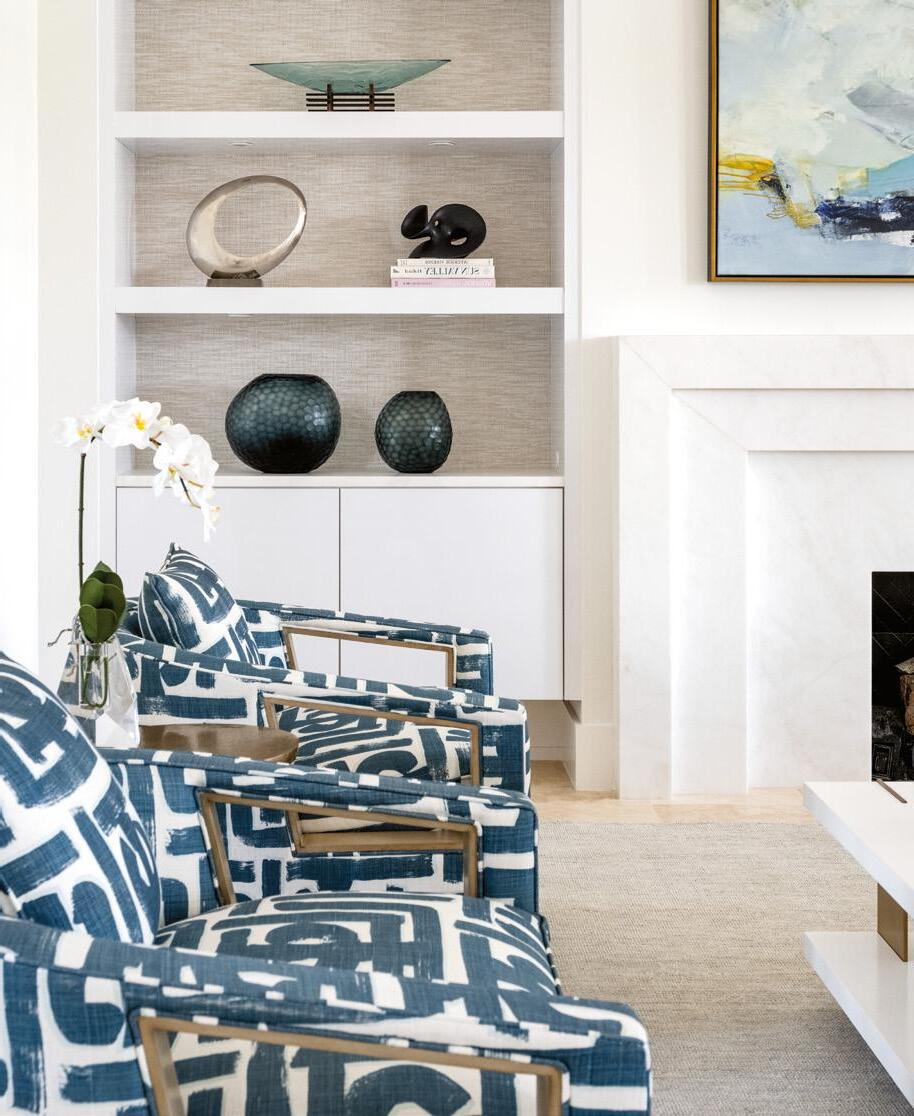

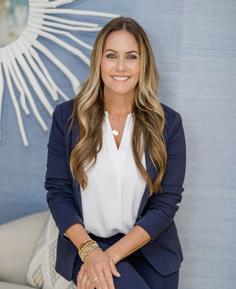






by Chris Foster photography by Yuri Semenyuk
Fall invites us to slow down and enjoy the last splash of color before winter. It’s the season when nature puts on a show—a final burst of vibrancy. And no one understands the art of capturing that fleeting brilliance quite like Stefan Handl.
Stefan isn’t your typical floral designer. Once a renowned New York artist rooted in a beloved Harlem flower shop—still cherished today—he has spent decades creating masterpieces for the city’s cultural influencers and elite tastemakers. His work is sophisticated, emotional, and highly sought after by those who see floral design as true sculpture.
To bring autumn entertaining to life for our November issue, I met Stefan in New York City’s iconic Flower District—a place where creativity blooms as wildly as the botanicals themselves. Even among the bustling carts and towers of fresh stems, Stefan’s presence stood out. He moves through the market with a sense of reverence—pausing to admire, inspecting with joy, and speaking of flowers as if each one has a story.
He took me to his trusted vendors, showing off an impressive selection of seasonal favorites—including velvety celosia cockscomb, prized for their rich texture and deep fall hues. At one point, a passerby walked by with armfuls of vibrant peonies.

Without missing a beat, Stefan leaned toward me and whispered, “Beautiful . . . but definitely not in season. They flew them in from Chile.”
His knowledge flows endlessly—from where each bloom is cultivated, to when it reaches its peak, and why it matters. His passion is contagious.
What I love most about Stefan’s artistry is his belief that flowers are more than mere decoration. They anchor a moment. They create a mood. They tell a story of who we are—and what we’re celebrating. This fall, that means embracing bold hues and intriguing textures that feel alive and full of movement.

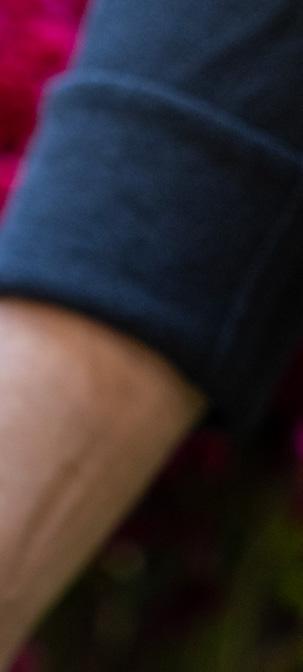
Flowers boost energy—the right arrangement can turn a table into a memory. Whether you’re hosting in a city loft or a coastal Florida home, don’t hesitate to be bold. Select arrangements that evoke joy and curiosity. Let seasonal stems—fiery oranges, deep burgundies, soft golds— become part of the conversation.
As Stefan reminded me, entertaining isn’t just about the food. It’s about the atmosphere we build, the warmth we share, and the beauty we decide to celebrate.
This fall, let your table thrive as if it belongs in a palace—because every gathering deserves a touch of magic.


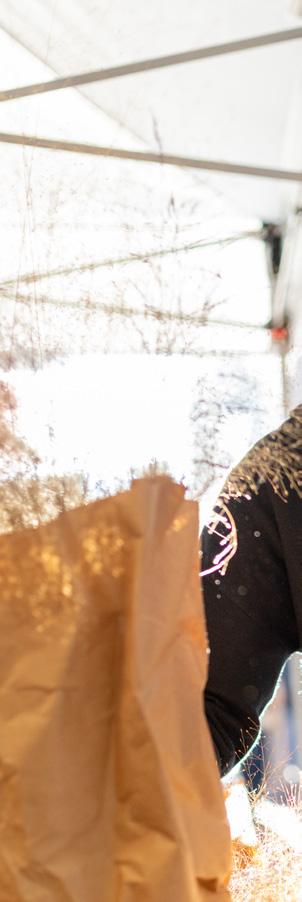
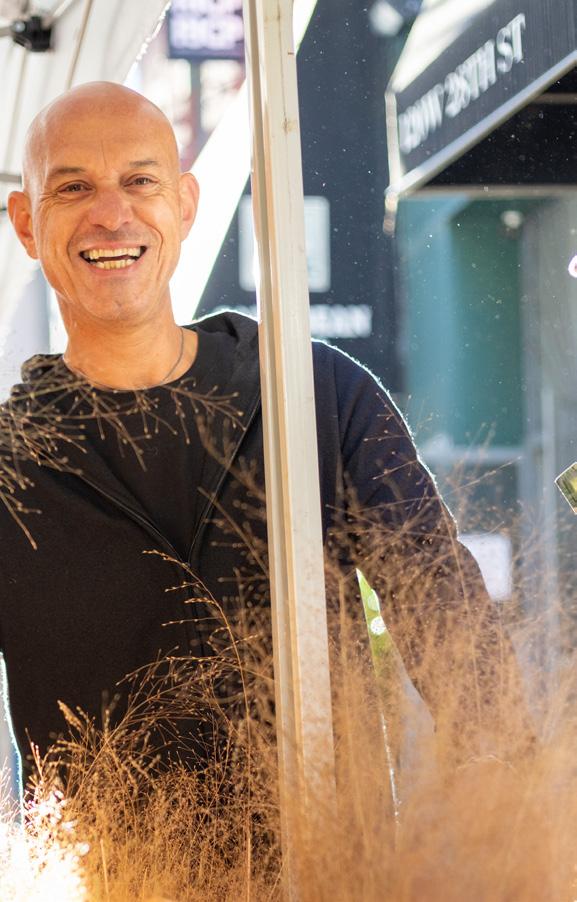
Quick Tips: How to Choose Fall Blooms (Stefan-style)
Start with seasonality. Reach first for what’s peaking now: celosia/ cockscomb, dahlias, mums, amaranthus, marigolds, eucalyptus, rose hips, smoke bush, grasses. They look better and last longer.
Build a palette, not a rainbow. Pick one hero color, a supporting tone, and a neutral (e.g., oxblood + persimmon + stone). Repeat for cohesion.
Layer texture and shape.
Combine velvet (celosia) + airy (grasses) + structural (branches) + glossy (camellia/ eucalyptus) for dimension.
Mind scale & conversation. Keep centerpieces below 12–14 inches tall or go tall with a narrow footprint; never block sightlines across the table.
Adjust the scent. Beautiful but subtle. Avoid overly perfumed flowers near dining areas, like lilies and some gardenias. Let the food be the focus.
Condition like a pro. Fresh diagonal cuts, strip submerged leaves, use lukewarm water for most fall stems, change water daily, and avoid heat, vents, or direct sun.
Choose the right vessel. Matte ceramic or aged metal with a narrow neck makes structuring easier and requires fewer stems for impact.
Sustainable sourcing. Ask for local or Florida-grown products when possible; they are fresher, support local growers, and help reduce waste.
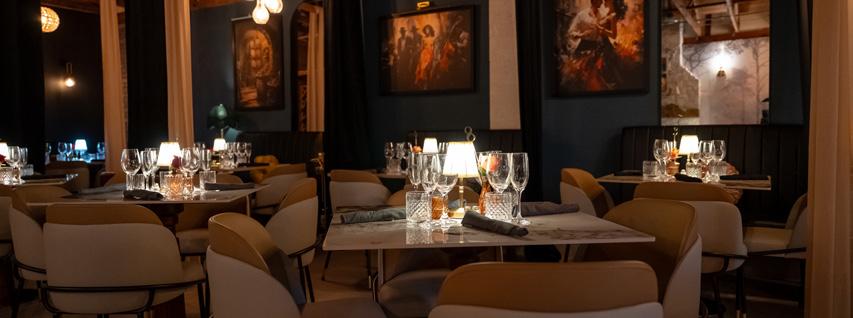
by Joshua McMiller photography by Anthony Castaldi (Perceived Media)
When you walk into Atmosphere at Vero, you feel something beyond décor, beyond lighting, and beyond the hum of conversation. There is warmth here, a sense of belonging that makes every table feel personal and every performance feel like it was chosen just for you.
The walls carry laughter and the scent of something good cooking, but underneath it all lives a story about family, faith, and the kind of love that refuses to fade with time.
This story originates in Miami nearly fifty years ago. Michael and Maria Mendez were just teenagers when their paths crossed one night at a local skating rink. It was a carefree night in the 1970s when roller rinks were temples of youth and romance, and fate seemed to spin right alongside the music.
Michael had just gotten his first car and his license, ready to enjoy the freedom of being sixteen. “I thought I had a long time to party,” he said, remembering it with a grin. “But then I met Maria that night, and that was it. I crashed and burned, and here we are 45 years later.”
Maria smiles when he says this, still charmed. “We were inseparable from that day on,” she said. “We dated for a year and a half and he was seventeen when we got married. I was eighteen. He needed his mother’s signature just to make it happen.”
They grew up together, learned life side by side, and raised three children named Melisa, Mailin, and Michael Jr. Their life in Miami was full of love, noise, and purpose. Dedicated to growing their family, Maria decided to go back to school. Michael would take her to school and pick her up daily.
From there they built an insurance business from the ground up, transforming it into a five-star agency that thrived for nearly two decades. When they sold the company, they made sure every employee was taken care of, even if it meant losing money. “We gave raises, we made sure everyone stayed employed,” Michael said. “That’s just who we are. People matter more than profit.”
Faith guided them through everything. The Mendez home was a place of prayer,
laughter, and unity. They didn’t drink or party; their joy came from one another, from their children, and from serving others. Maria often says their strength comes from putting God at the center of every choice. Michael calls it “the secret ingredient” and the one thing that makes love last through decades of work, sacrifice, and change.
Vero and New Direction
When COVID arrived, it gave them something they had never truly had before: stillness. After a lifetime in Miami, they found themselves drawn to Vero Beach, a place of beauty and calm that mirrored their new pace of life.
Since Maria and Michael had achieved her dream together with the insurance company, Maria wanted to extend that same gesture. “He always wanted to open a restaurant,” she said. “So I told him, you made my dream come true, now it’s my turn to make yours come true.”
That promise became Atmosphere at Vero. The building was a blank canvas when they found it. Once a flower shop and then a pub, it sat quietly in the heart of Vero
Beach, waiting to be reborn. Michael took on the renovations himself, pouring his heart into every corner. He installed new floors, painted walls, wallpapered, reimagined the kitchen, and rebuilt the space piece by piece. Maria handled the design with care and intention, sometimes waking up in the middle of the night with a vision. “The tables, the curtains, the lighting, everything had to feel right,” she said.
Friend and designer Lisa helped her bring it to life, but the soul of the place is unmistakably Maria’s detailed touch. The result is a space that feels cozy and familiar, with soft textures, warm tones, and lighting that flatters everything it touches. There are hints of Europe in the details, whispers of Cuban and Miami inspirations in the colors, plus comfortable seating.
Music and Food
Music was always meant to be at the center of the busy new restaurant. Maria’s father was an opera singer, and his voice once filled their home with songs of love and devotion. In Vero Beach, Maria longed for a place where she could hear live music with dinner, where conversation and
jazz could meet over a glass of wine. When she couldn’t find one, she and Michael decided to create it.
They started small, booking local talents like Larry Brown, the Hatfields, and Max Duhalde. The first major event was a Valentine’s supper with candlelit tables, roses on every surface, and a soft hum of jazz that seemed to float through the room. It was romantic, classic, and unforgettable.
That night, the dream was realized. Since then, it has grown into one of the most loved venues in Vero Beach. The restaurant hosts themed cultural nights—Spanish, Brazilian, Italian, French—and draws a beautifully diverse crowd of locals and visitors who come for the food, the music, and to be a part of something intimate.
Behind the scenes, the Mendez family works together with seamless rhythm. Their son, Michael Jr., known affectionately as Mikey, is the executive chef—trained at Johnson & Wales University in Miami. He runs the kitchen with precision and creativity, designing menus that are as thoughtful as they are delicious. “I try to make the menu exciting but also simple,” he said. “It’s just me and one other—Chef
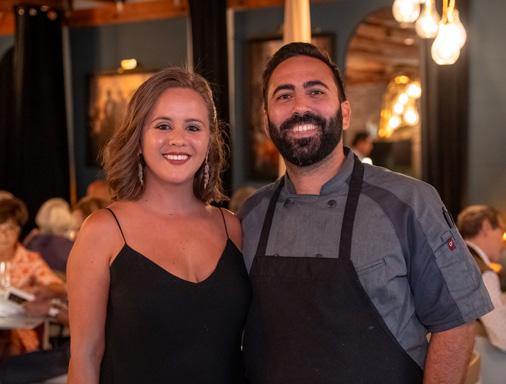
Nicholas Bradbury—in the back, so I want it to be special but manageable. Every dish needs to have a purpose.”
The food reflects that philosophy. Every plate carries a balance of flavor rooted in tradition but touched with originality. The menu shifts with the seasons and the music, sometimes echoing the cultural theme of the night, other times exploring new ingredients that surprise regulars and delight newcomers.
Mikey’s wife, Alyssa, works in front, greeting guests, hosting, running food, and ensuring that every person who enters feels like family. Though new to Vero Beach, she has already become part of the town’s heartbeat. “We just moved here from Fort Lauderdale,” she said.
“Working at the restaurant has been an amazing way to meet people and build relationships. I love seeing the community respond to what Mike and Maria created.”
Her warmth and natural hospitality mirror the heart of her in-laws. “Even though I’m not their biological daughter,” she said, “they’ve adopted me completely. They treat me like their own. Their love and work ethic are unreal and inspiring. They’re focused nonstop, and when they have a vision, nothing can stop them.”


At Atmosphere at Vero, that vision continues to evolve. It has become more than a restaurant. It is a place where faith, culture, and connection live side by side. Michael and Maria often talk about the restaurant as a gift they are simply managing for God because it’s a vessel to bring people together. They pray over the business, over their staff, and over every decision they make. “We are just the stewards,” Michael said. “This belongs to Him.”
They have carried that spirit of generosity into everything they do. From supporting their staff in buying homes to organizing charitable events for local children, the Mendez family lives by a simple principle: to give back as much as they receive.
There is a tenderness in the way the family speaks to one another, a respect that
comes from decades of shared work and belief. They are truly close. They communicate constantly, resolve disagreements with care, and make decisions as one. “We’re best friends,” Mikey said. “Even when we disagree, we stay on the same page. I’m extremely blessed to have them.”
The nights at Atmosphere at Vero reflect that same harmony. When the lights dim and the music begins, guests settle into a rhythm of laughter, movement, and joy. There is no pretense, only presence. It feels like stepping into a home that was waiting for you all along. And at the heart of it all are two people who once met at a skating rink and never looked back by still holding hands, still creating, still believing that love and faith can build anything.
By Mikey and Alyssa Mendez
To our parents,
We’ve watched you do something that most people would never dare to do by building a restaurant from the ground up without ever having owned one before. You dreamed it, and then you made it real.
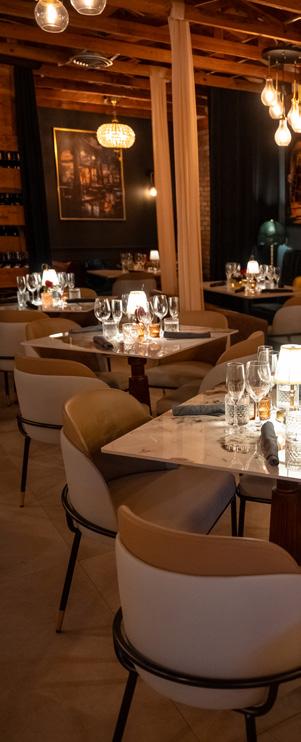
You didn’t come from much, but you’ve always been go-getters. Mom, you came from Cuba and built a life here with nothing but determination. Dad, you’ve worked hard your entire life, and together you’ve shown us what love, work, and faith look like when they’re all in balance.

Working in this restaurant every day, seeing how people respond to what you’ve created, has been one of the most rewarding things in our lives. We hear the laughter, see the smiles, and feel the energy of people who come here to connect, to eat, to listen to music, and to feel genuine care. That’s the legacy you’re building, not just a restaurant, but a place where people feel loved.

Mom and Dad, you’ve taught us resilience, creativity, and the importance of family. We’ve seen you face challenges that would make most people give up, but instead of stopping, you keep moving forward. You never let fear stop you from doing what God placed in your hearts.
We’re honored to be part of this dream with you. It’s humbling to serve guests, to host events, to hear people say they feel at home. Every plate that leaves the kitchen, every guest we greet, feels like a continuation of your love story. And though we joke about who’s the favorite or who calls you the most, the truth is we’re all your biggest fans. You’ve given us something more valuable than success—you’ve given us the example of what it means to love with purpose.
With love and gratitude, Mikey and Alyssa
As Atmosphere at Vero continues to grow, the Mendez family’s story feels far from complete. They are already planning to expand by offering new menus, music, and experiences that bring even more people together under one roof. But they are careful to move with intention, never losing sight of what made this place special in the first place.
Their journey is a reminder that success doesn’t always start with expertise or wealth. Sometimes, it starts with a promise made between two young people at a skating rink. It grows through faith, hard work, and the courage to try something new. And if you do it right, if you do it with love, it becomes something more than a business. It becomes the perfect atmosphere. As Maria put it softly, “When you keep faith at the center, everything falls into place. That’s what keeps the atmosphere alive.”
772-559-0238
1925 Old Dixie Highway Vero Beach, Florida 32960
Instagram: @atmosphereatvero Website: atmosphereatvero.com
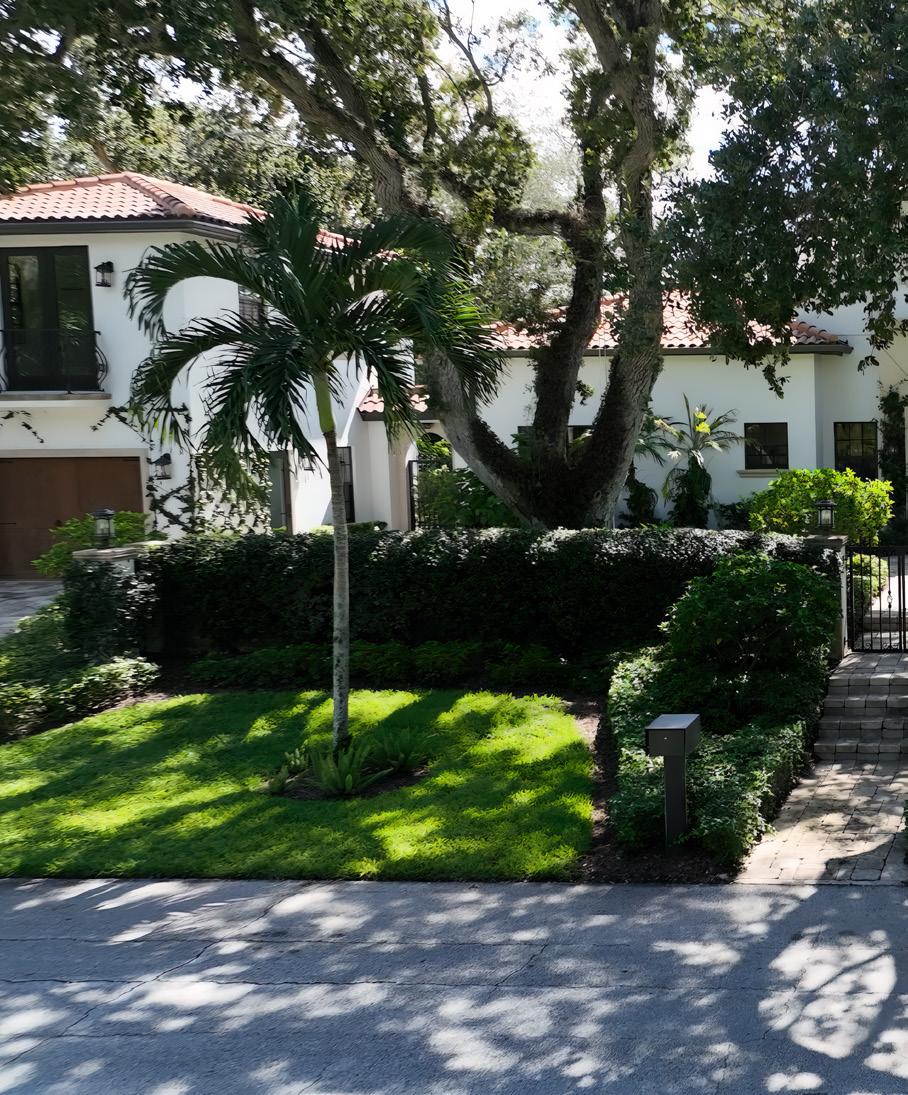
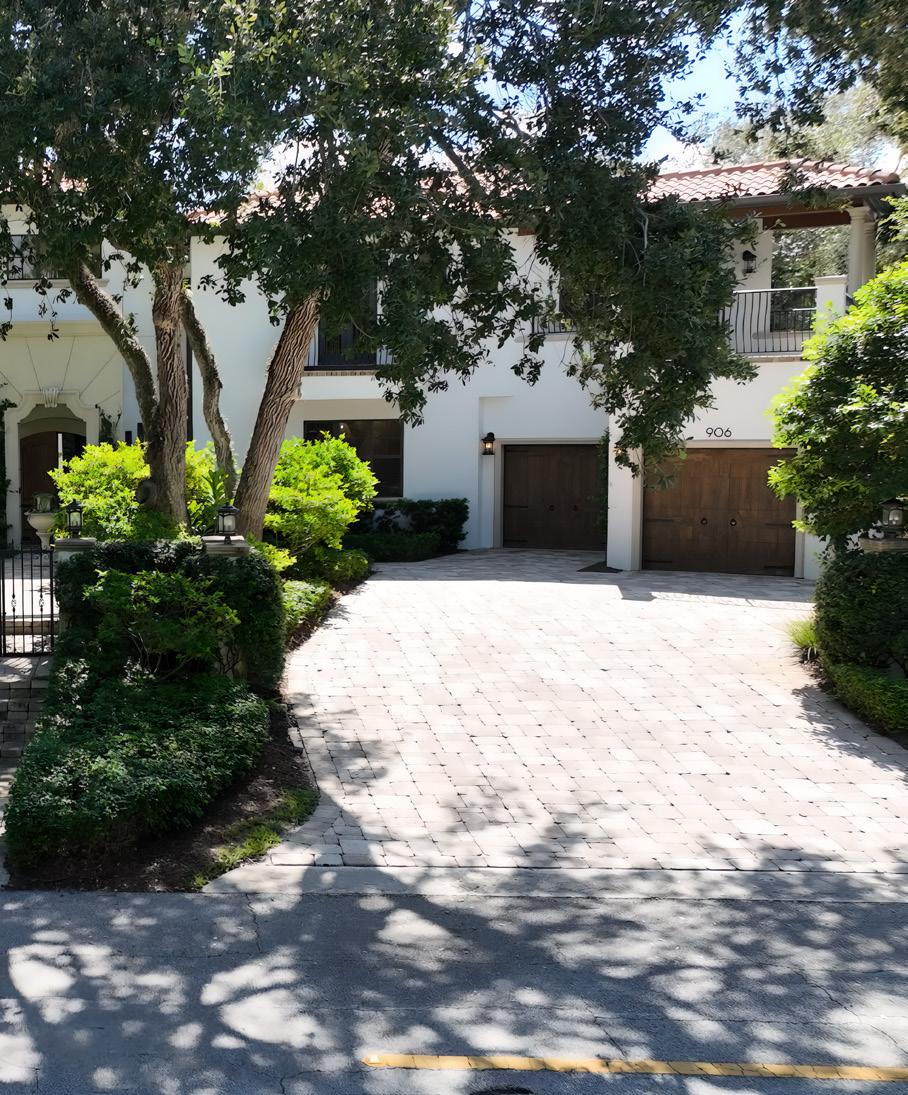
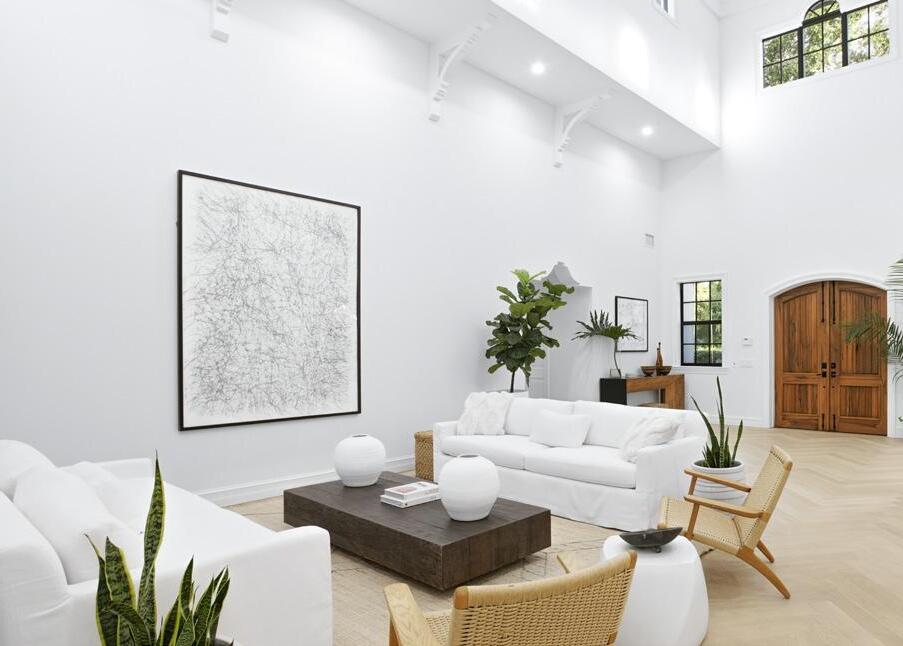
by Jim Field photography by Yuri Semenyuk
There are some homes you view from the curb and they fit your eye perfectly—as if you’ve known them all along. You attach to their contours, architectural style and detail, materials and colors. Equally so, they sit perfectly on the property, landscaped beautifully.
Entering such a home is like coming home—you’re immediately oriented and comfortable. You walk from room to room, not seeing for the first time, but confirming that everything you’re experiencing is exactly what you expected, precisely what you like. It’s all there to be enjoyed: generous dimensions, thoughtful floor plan, period and modern finishes, natural light and spillover to the outdoors.
906 Seagrape Lane is just such a residence. Technically, its style is Spanish Architecture, with all required structural and design elements. More accurately categorized, however, it is Spanish Revival, reflecting the reinterpretation of historical architectural and design elements using updated compositions, materials, and finishes to suit contemporary tastes and needs. Simultaneously, the home is historical and modern.
A wonderful example of this is the main staircase leading to the second floor. It is built of sturdy wood; its dimensions are neither minimalist nor grand; it is painted white entirely; the entrance overhead features a gently curving “bell arch” (portraying the outline of a bell), typical
of Spanish Revival. This bell arch pattern repeats, framing the main entranceway to the home (dramatically done) and hallway to the primary bedroom. This unadorned artistic flair sets the overall mood of the residence: simple Spanish elegance. Parenthetically, the staircase features, as a finishing touch, recessed lights to illuminate the treads.
Riomar Neighborhood
The home is located in the venerable Riomar neighborhood, on Vero Beach’s barrier island, a five-minute walk to the Atlantic Ocean heading east, and Indian River Lagoon proceeding west.

Riomar is one of Vero Beach’s first beachside residential neighborhoods. Historic homes date to the early 1900s, with more recent homes occupying scattered previously undeveloped lots. As a rule, properties are beautifully maintained or queued for renovation (or teardown). The landscape is tropical, indigenous, old-growth, and gorgeous: mature oak trees, large specimens, sand and shell lanes, spacious lots. Ocean breezes are the norm, the air salty and clean. Golf carts are preferred transport to beach access pathways.

The feel of Riomar is often described as “Old Florida charm”—meaning relaxed, elegant, historic yet comfortable. Privacy and quiet are highly valued, yet residents are friendly and welcoming. Overall, the neighborhood is a distinctive, extraordinary preserve along the sea.
The home was designed and built in 2008 by Twenty First Century Design/Build. The residence underwent a major renovation across 2024-2025. Air conditioned space comprises 4,884 square feet, total space 6,155 square feet. There are five bedrooms, five full baths, and one half bath. The home always conveys spaciousness, vertical height, natural light.
The first floor divides into thirds: foyer and living room with cathedral ceiling; kitchen, family room, dining room, butler’s pantry, laundry; and primary bedroom, primary bathroom, guest suite/office with full bath. Common features include white oak hardwood floors, shiplap paneling, clerestory windows, Palladian windows, French doors, crown molding, tray ceilings, custom cabinetry, fine bathroom fixtures. The dining room features raised panel wainscoting, the kitchen quartz countertops, curved island with breakfast bar and ample storage. The kitchen is a dream to work in.
On the second floor, the stairs climb to a large media room—the centerpiece around which three guest suites are situated. Shared amenities include ipe wood flooring (a.k.a Brazilian walnut), custom walk-in closets, crown molding, ensuite baths, French doors to Juliet balconies. The media room is designed for watching TV and playing games, outfitted with a kitchenette with half bath.
Finally, the first floor hosts a fitness center with cathedral ceiling, wall mirror, and wall-mounted air conditioner. The garage accommodates two vehicles and a golf cart.



Outdoor Wonderland
906 Seagrape is particularly successful in the way it seamlessly combines the indoor and outdoor environments. The view from the primary bedroom through French doors to the azure-hued pool with surrounding tropical plantings is stunning— tranquil, alluring—an oil on canvas.
The family and living rooms jointly open to an expansive lanai with electric screens, providing shelter from sun, rain, breeze. Nearby there is a large covered loggia with wood-paneled ceiling, travertine tile floor, fireplace, and half bath. Lastly, there is a glorious summer kitchen—gas grill with burners, sink, refrigerator. Florida is the place to live outdoors year round—this home makes this possible in style and comfort. On a beautiful day you are drawn outdoors—one simply cannot resist.
The home is not overdone: it is proportionate and tastefully appointed. It is both functional and decorative. Above all else— going back to where this article started— the home makes sense: you enjoy it when you first enter; you appreciate its historic lineage and vestiges; you meld with its modernism. It would be remiss to not point out one final feature—the Spanish Colonial front doors: honed rustic wood, iron hardware, appropriately weighty, in keeping with high Spanish Revival style.
906 Seagrape Lane
Vero Beach, Florida 32963
Offered by the O’Dare Boga Dobson Group

YOU WALK FROM ROOM TO ROOM, NOT SEEING FOR THE FIRST TIME, BUT CONFIRMING THAT EVERYTHING YOU’RE EXPERIENCING IS EXACTLY WHAT YOU EXPECTED, PRECISELY WHAT YOU LIKE.


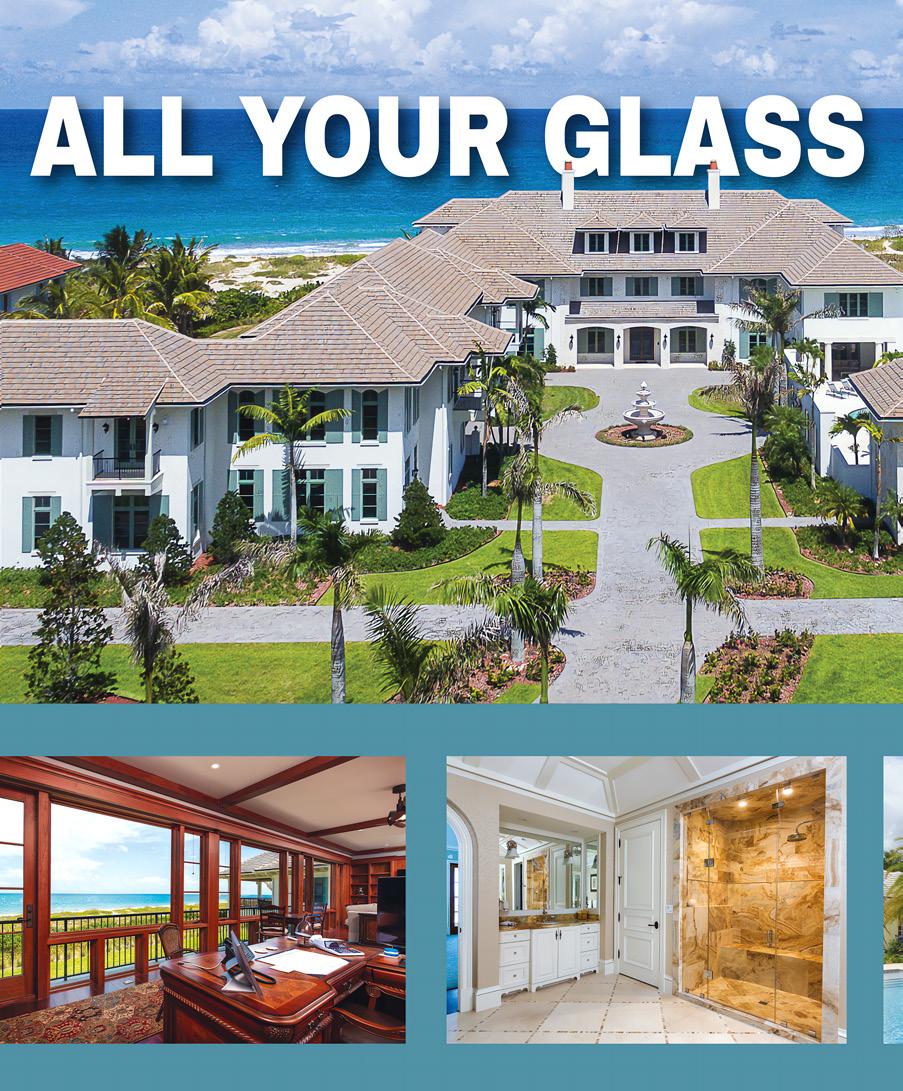


interview with Christiana Lipscombe conducted by Amanda Blumberg photography courtesy of Distinctive Cabinetry Designs
AB: Thank you for sitting down with me to tell our readers about yourself and your business. To prepare, I visited your website and Instagram page, and your work is so beautiful. Congratulations!
CL: Thank you so much! I’m thrilled to share my designs and connect with your readers about my range of cabinetry solutions, from custom to budget friendly.

AB: What does Distinctive Cabinetry Designs specialize in?
CL: I specialize in designing cabinetry for homes and businesses—kitchens, bathrooms, built-ins, offices, outdoor kitchens, you name it! I create everything from fully custom designs to budget-friendly options, ensuring the perfect fit for every space and wallet.
AB: How did you get into this work? Can you tell us about your background?
CL: My passion for designing spaces led me to cabinetry. From 2004 to 2007, I worked as a real estate agent for a construction company in Roanoke, Virginia, spending my days on-site before homes were built. I got a front-row seat watching the project manager oversee everything from pouring slabs and building basements to final details for the certificate of occupancy—it was an incredible education in design and construction. Around that time, I bought my first fixer-upper and got hooked, renovating and flipping over 100 properties while managing my real estate license. The 2008 housing crash gave me a chance to ramp up flipping, finding great deals to transform homes. But by 2016, as market values rose and profitable properties became harder to find, I pivoted to designing cabinetry, creating custom and budget-friendly solutions to bring clients’ visions to life.
AB: You were certainly prepared to do other things—that’s a lot of hands-on experience. What is your relationship with Vero Beach?
CL: Vero Beach feels like home—my parents moved here from Texas in 1993. I’ve lived here twice: first in 1996 after serving in the Air Force, then I returned in 2011 after a stint in Virginia. When I came back, I dove into renovating county foreclosure homes, bidding at daily auctions and starting projects the same day. That fast-paced experience shaped how I design cabinetry here, creating everything from high-end custom designs to affordable options for our community.
AB: When was the official launch date for Distinctive Cabinetry Designs?
CL: In spring 2016, I launched Affordable Quality Cabinets to offer great value for home investors. Soon after, I started Distinctive Cabinetry Designs to provide a full range of options, from high-end custom cabinetry designs to budgetfriendly solutions. Years of hands-on work had taught me the art of design, and I was excited to use my creativity to craft spaces that fit every client’s vision and budget.
AB: Tell me the typical ways that clients find their way to you. What are a few typical scenarios?
CL: Clients often reach out when they’re ready to refresh a space like a kitchen, bathroom, or laundry room. I visit their home to see the space, hear their ideas, and brainstorm together—covering measurements, colors, materials, and finishes. I design everything from luxurious custom cabinetry to affordable solutions, ensuring I match their style, needs, and budget. I then create drawings and a cost estimate, and it’s exciting to see clients light up as their vision takes shape. There’s plenty of back-and-forth to get every detail right—kitchens especially need precision to be functional and beautiful. About 75% of my work comes through general contractors, but whether direct or through a contractor, I build a close, personal relationship to make the design process smooth and fun for every client.
AB: What do you think makes you special in the market? What would you say are your key strengths?
CL: I stand out by designing cabinetry for every client, from stunning custom creations to budget-friendly options, paired with top-notch customer service to keep things on track, on time, and within budget. It’s all about listening closely, communicating clearly, and tackling any issues that pop up—because in construction, with so many trades and details, hiccups are inevitable. I’m there for my clients, offering solutions and following through to make things right. I’m also lucky to work with some of Vero Beach’s best interior designers, which improves my knowledge and elevates every project. That builds trust and gives clients confidence their investment is valued. Vero Beach is full of talented cabinetry professionals, and I’m grateful to be part of this community, focusing on my clients and their projects. There’s plenty of work for everyone, and we love contributing to beautiful spaces here.
AB: How do you ensure that each project reflects both the client’s needs and your own craftsmanship standards?
CL: With years of experience, I’ve learned how to design a space that works beautifully, but it’s all about ensuring the client loves the result, whether it’s a custom masterpiece or a budget-friendly solution. I’ll go through as many revisions as needed—on a large custom job this could be 15 or more—to nail their vision. My talented installers bring my designs to life with flawless installation, making great cabinetry shine. The job’s not done until the client is thrilled.
AB: What’s one thing that you would tell a prospective client to help them with a project they are envisioning? What is a common mistake, or misconception, that you encounter?
CL: Start with a realistic budget—it’s the foundation of any great project. Pinterest and Instagram are full of gorgeous cabinetry for inspiration, but knowing what you want to spend and your goals are key. Is this your forever home? Planning to sell soon? Want top-of-theline or something practical? I guide clients through these questions to uncover what matters most, which can take time and lots of decisions. It’s like a fun puzzle, and I love helping solve it.
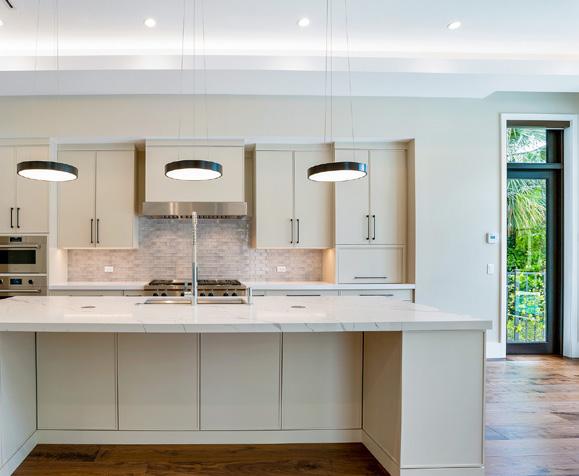
AB: I suppose I’ll close with a more personal question. Do you have a favorite client experience that you find special or memorable?
CL: I’ve been lucky to have so many memorable moments with clients, contractors and interior designers. One favorite is when clients, often away during a build, see their finished space and light up because my design, whether a custom kitchen or a budget-friendly upgrade, brings their dream to life. Some throw cocktail parties to celebrate with the team, and one client even cried tears of joy, which was so rewarding! My approach is simple: I want every client to feel I listened, was honest, and delivered a design they love, no matter their budget. I hope they recommend me to friends or family—that’s the goal! When I started 10 years ago, it was just me, my Yorkie, and my cell phone in a small warehouse office, designing a few jobs a month. Then it grew to a steady stream each month, and now we stay busy all year round. It’s been a wild, wonderful journey.


by Linette Capritta photographs courtesy of Capritta Appliance
Let’s talk about the typical dinner hour. You walk through the door after a long day, everyone’s hungry, and the pressure’s on.
You grab ingredients for pasta night: water for boiling, sauce to simmer, maybe garlic bread to toast. But instead of a smooth process, you’re stuck waiting for pots to heat, watching water crawl toward a boil, and constantly adjusting burners that never seem to land at the right temperature.
Meanwhile, something’s always too hot, too cold, or boiling over when you turn your back. Now let’s rewind and reimagine that same evening with induction cooking.
Picture this: you set a pan on your sleek glass cooktop, press a button, and in seconds your pan is hot—really hot. Not “kinda warm” hot, but “water-boils-insixty-seconds” hot.
That’s because induction doesn’t waste time heating the burner itself. Instead, it uses electromagnetic energy to directly heat the cookware, meaning every ounce of energy goes into cooking your food, not into warming up your kitchen. Essentially, your pan becomes the burner.

Induction cooktops are not only faster, they’re safer. The surface around your pan or pot stays cool to the touch, so curious kiddo fingers, wandering pets, or the inevitable splashes don’t turn into emergencies. And, when you lift a pan off the burner, the heat stops instantly. It’s precision, control, and peace of mind— all in one.
Cooking becomes, dare we say, enjoyable! Imagine searing salmon to perfection without smoke filling the house; simmering sauces that stay at exactly the right temperature; and boiling pasta water in record time. With fine-tuned controls, you can melt chocolate without scorching or bring a stockpot to a rolling boil without waiting half your life.
And, here’s the secret bonus: induction is incredibly efficient. Because less heat escapes into the air, your kitchen stays cooler (goodbye sweaty summer cooking), and your energy bills go down. Compare that to your gas or electric range, which is basically heating the air as much as it’s heating your food. With induction, it’s all about results . . . and savings.
When you buy your induction cooktop from Capritta Appliance & Air Conditioning, you’re not just buying a sleek new piece of technology. You’re gaining a partner. Our expert team will help you select the right induction system for your space, install it seamlessly, and provide long-term service and support, so your investment continues to pay off with every perfectly cooked dish.
So back to our story: the same busy evening rolls around. But instead of frustration, you’re calm. Dinner is cooking quickly, evenly, and safely while you sip a glass of wine. No scorched pans. No sweaty kitchen. Just flawless food, right on time.
It’s not just cooking. It’s a smarter way of living. And with induction—and Capritta— it’s a lifestyle that starts in your kitchen and makes every meal better.
In her role as Marketing and Design Project Manager, Linette Capritta blends brand building with business development, leveraging her expertise in digital marketing and interior design to influence both the company’s public image and its growth trajectory.
Capritta Appliance & Air Conditioning 2585 W New Haven Avenue West Melbourne, FL 32904
321-676-0111
Instagram: @caprittaappliance Website: caprittafinelines.com



Proud to be the only Renson Dealer along the Treasure Coast.
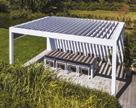
Optimal enjoyment of your indoor and outdoor spaces
How your ideal home looks is personal. But we all share one clear wish: we want a home in which we can recharge our batteries in comfort and that is a pleasant place to be all year round. Renson® helps you achieve that goal with sustainable solutions for a healthy, comfortable living environment. Inside and outside.
Ventilation • Solar Shading • Pergolas • Wall Cladding • Carports
OUTDOOR LIVING RE-IMAGINED
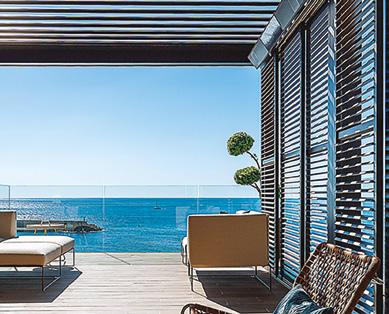

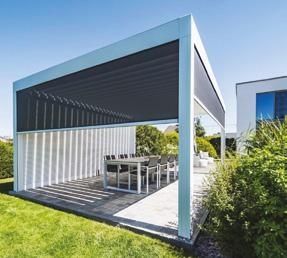
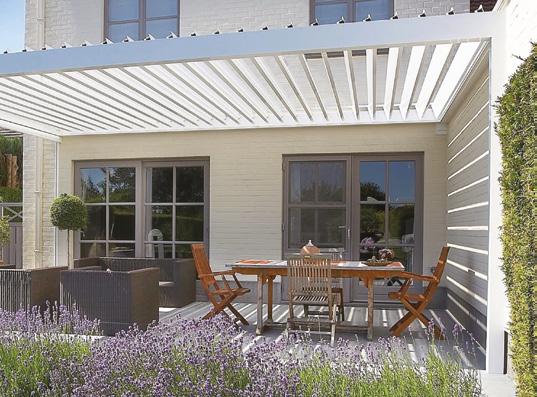




by
Chris Foster photography by Yuri Semenyuk featuring curated looks from Sassy Boutique
As the breeze cools and the season of parties and dinners begins, fashion takes center stage. This fall/winter, designers are embracing luxurious textures, clean silhouettes, and refined layers that feel both modern and timeless.
For the November issue, LIV VERO explores the season’s top trends—from global runways like COS Women, Dior, and Chanel to the curated finds at Sassy Boutique on Ocean Drive, bringing highfashion energy to our coastal community.
Fluid Silhouettes. Designers, including Dior and Chanel, are embracing graceful draping and romantic movement that work beautifully in transitional climates.
Sculptural Minimalism. COS Women leads with crisp tailoring, midi dresses, and sculpted separates—effortlessly elegant for day-to-evening dressing.
Rich Neutrals & Jewel Tones. Deep emeralds, burgundy, muted mauves, and rich chocolate browns blend with
creamy ivories and soft grays to create an understated yet sophisticated palette.
Statement Outerwear. Cape-style coats, shawl-collared wraps, and cropped tailored jackets are redefining outerwear this season, adding polish without bulk.
Heritage Textures. Tweed, cashmere, and silk blends return with a modern twist—structured blazers paired with slip dresses or textured knits, and sleek trousers.
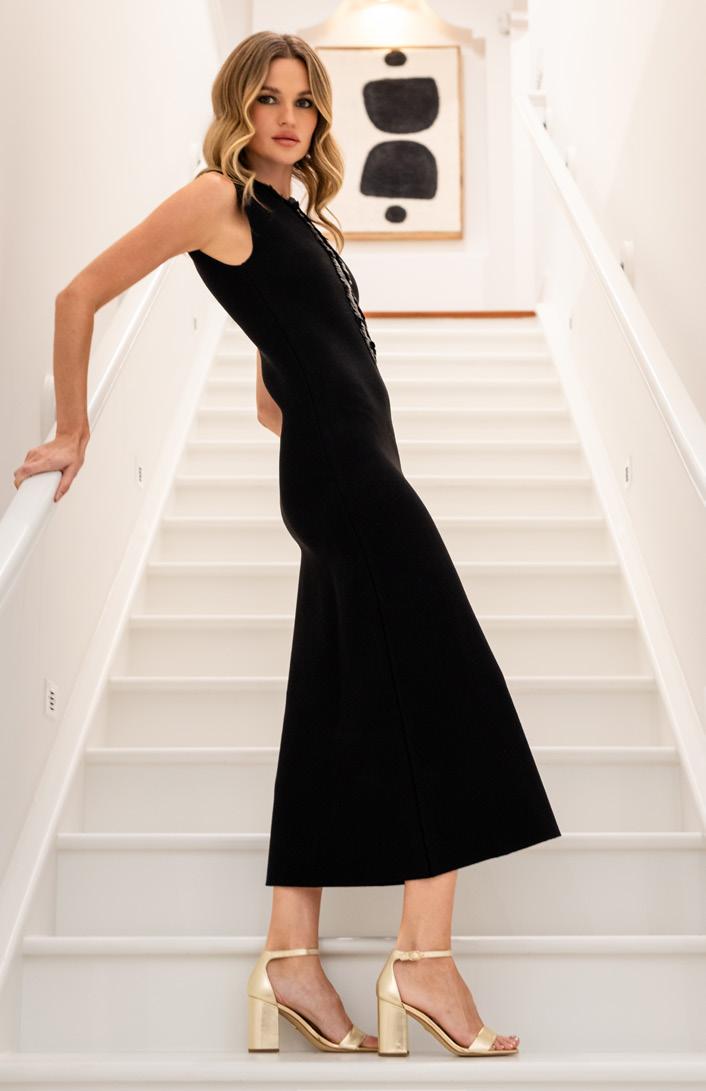
Elevated Accessories. Low-heeled booties, sculptural earrings, structured handbags, and slim gold belts provide the finishing touch to every ensemble.
Runway Meets Vero Beach
While the Paris and Milan runways showcased rich layers and dramatic outerwear, Vero Beach’s climate calls for lightweight fabrics, transitional layering, and pieces that adapt to breezy evenings.
Blending COS Women’s sculptural minimalism with the seasonal collections at Sassy Boutique allows women to capture the essence of fall/winter fashion in a way that’s wearable, versatile, and ideally suited for our coastal lifestyle.
• Transitional dresses in flattering cuts and modern hues—perfect for everything from alfresco lunches to holiday dinners.
• Lightweight knit layers in seasonal tones that provide just enough warmth for November evenings.
• Chic evening pieces in jewel-toned silks and satins for cocktails and holiday gatherings.
• Statement accessories—elegant handbags, slim belts, and gold-accented jewelry to elevate any look.
A curated capsule collection makes it easy to mix, match, and build chic seasonal looks:
1. The Base. A sleek COS Women’s midi dress in ivory or charcoal—the perfect foundation for layering.
2. The Layer. A lightweight blazer or cropped jacket in deep emerald or muted wine, found at Sassy Boutique.
3. The Knit. A soft cashmere or woolblend sweater in warm camel or cream for versatile day-to-night styling.
4. The Accessory. A structured handbag in black or chestnut and delicate gold jewelry to finish the look.
5. The Shoe. Low-heeled suede booties or elegant leather flats—chic, comfortable, and ideal for fall gatherings.
This capsule maintains a wardrobe that is sophisticated yet simple, making each piece versatile enough for dinners, holiday parties, or weekend shopping trips.
Closing Thought
This season is about effortless elegance— blending global trends with coastal sensibility.
From COS Women’s sculptural minimalism to the carefully curated collections at Sassy Boutique, Vero’s women can step into fall confidently, embracing luxury textures, warm seasonal hues, and versatile pieces that take them from daytime gatherings to candlelit evening events.
AS THE BREEZE COOLS AND THE SEASON OF PARTIES AND DINNERS BEGINS, FASHION TAKES CENTER STAGE. THIS FALL/WINTER, DESIGNERS ARE EMBRACING LUXURIOUS TEXTURES, CLEAN SILHOUETTES, AND REFINED LAYERS THAT FEEL BOTH MODERN AND TIMELESS.


Discover advanced facial aesthetics, injectables, laser therapies, and biohacking treatments designed to help you look better, feel stronger, and age smarter.
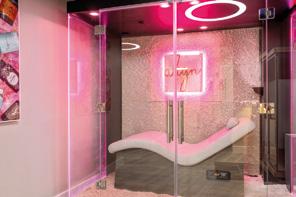

Services


• Botox, Fillers, Sculptra
• Luxury Facials & Advanced Microneedling
• Cryotherapy, Infrared Sauna, Red Light Therapy
• BBL Heroic & Sylfirm X Skin Rejuvenation
• Salt Room & IV Wellness Lounge
Tailored memberships available to support your beauty + wellness goals.


by Joshua McMiller photography by Joshua McMiller
René Guerin’s presence is peaceful, real, and full of jovial charm, but the world she creates vibrates loudly. There is something to be said about an artist giving an interview who does not want to be photographed.
At first, I will admit, I found myself thinking about my love for photojournalism and wondering whether we might capture a portrait at the end. But as I sat with her, I realized something far more important: to truly understand René, you must respect her pace, her process, and the abstraction of a true artist.
Her spaces breathe. They hum with life. Even the stillness of her home studio in Vero Beach feels electric. Tucked within a 1950s architect-designed Florida house, the space is a sanctuary of color, nature, and light.
Canvases lean against walls, brushes sit in clusters beside ceramic sculptures, and decades of experimentation seem to whisper from every corner. There is an on-site kiln, collections of found objects, and a thousand stories in progress.
Here, surrounded by her creations, René cultivates a universe that is quietly spectacular.
René’s childhood in Vero Beach is threaded through every brushstroke. She remembers the days when the town felt wild and untouched. “We could wait at an intersection as a turtle or an egret crossed the road,” she says, her voice soft but deliberate.
The family moved from California in 1952, drawn by the coastal warmth and her father’s need for healing from arthritis. Her father, a surgeon, and her mother, practical yet imaginative, carved a life amid dunes, riverbanks, and long stretches of unspoiled shoreline. Days were spent chasing mullet in the shallows, digging clams, and watching sea life with a reverence that bordered on ritual. “Even the smallest acts mattered,” René reflects. “Saving a tiny turtle seemed as serious as any adult task.”
Art entered René’s life early. Encouraged by her mother and nurtured by a local teacher, Mrs. Curzon, she began studying drawing and sculpture before she was even a teenager. By age ten or so, she was building bamboo structures, shaping

plaster, and painting what she saw in the world around her. Her formal education at Stetson University and Florida State University only deepened that instinct. But her truest learning came from the act of making, from testing materials, taking risks, and never letting curiosity rest.
There are many types of artists in the world, but few who apply creativity to everything they touch. René is one of them. She draws, paints, and sculpts with the same intensity she brings to observing a shadow fall across her studio floor. Her work ethic is relentless, yet never forced. Being resourceful and hard-working are qualities that have followed her through every phase of her life and career.
René is deliberate in her work. Each painting, each sculpture, is a meditation on perception, memory, and experience. “I just want to be the best I can be,” she admits. “I always did a lot of drawings, always worked, always wanted to see where I could go.”


Inspiration comes not only from her past or from the Vero landscape, but from art itself, from the endless dialogue between artists across the world. “Instagram has become a gallery without walls,” she says. “I can see what painters everywhere are creating. It keeps me curious.”
Despite a life steeped in creativity, René remains profoundly shy. She prefers her art to speak for her. Much of her recognition has come from exhibitions rather than interviews or appearances. Her paintings have appeared in Arts on Douglas, the Vero Beach Museum of Art, and even the Bowery Gallery in New York City.
Her collectors span the country, yet she remains private and humble. “I do not want to be seen,” she says, “but you see my work.” And indeed, through her art, one encounters her entire life, the childhood awe, the discipline, the solitude, and the joy of discovery.
Her career is a tapestry woven from decades of exploration: early recognition at local Vero Beach shops, solo exhibitions, invitations to prominent galleries, and continuous reinvention. She often speaks of her paintings as if they are separate beings. Letting them go is never easy. Even after years of showing and selling, she once wrote to a collector to ask if they
still wanted a piece she was not yet ready to part with. That attachment reveals the truth of her nature. Art for René is both personal and shared, both a release and a return.
Her relationship with nature remains central. She paints along the Indian River and the barrier islands, revisiting the same spots she knew as a girl. The way light bends across the water, the color of sand underfoot, the stillness between clouds that are not just scenes to her, but memories reawakened. Her home, filled with seashells, old maps, sketchbooks, and family relics, feels like an extension of her landscapes.
There is a quiet spirituality to her process. Her art lives in the tension between intuition and precision, chaos and control. It asks for patience from those who view it. In many ways, René Guerin is not only a painter and sculptor, she is a chronicler of what it means to see. To witness, to translate, to give form to the unseen. She is, in every sense, a shy artist with a loud, undeniable voice in pigment and form.
Q&A with René Guerin
JM: When did you first know you wanted to be an artist?
RG: I started really young. My mother gave me lessons, and from there I just kept going. I always loved it, always wanted to be the best I could be.
JM: What inspires you today?
RG: Art, other people’s art. I follow painters from all over the world on Instagram. I love seeing what they create. It reminds me of possibilities and keeps my imagination alive.
JM: Your work often feels deeply connected to Vero Beach. Why is that?
RG: Growing up here, I’ve had an intimate relationship with the land and water. The beaches, rivers, and wildlife shaped how I see light, color, and movement. It is impossible to separate the two.
JM: Do you find it difficult to let go of your art?
RG: Absolutely. Even now, after years of selling work, I still feel that attachment. Sometimes I have to wait before I can part with a piece. It is like saying goodbye to a part of myself.
JM: How can people see your work?
RG: They can find me online at reneguerinart.com and on Instagram @ reneguerinart. Visitors are welcome by appointment only to see my studio and the works in progress. They can reach me at reneguerin@me.com. Lastly, I will be having my annual Studio Open House where all of my works of art will be for sale February 28, 2026 from 2:00-5:00 p.m.
JM: If you could describe your work in one phrase, what would it be?
RG: Imagination freed with all the quiet intensity of a life observed.
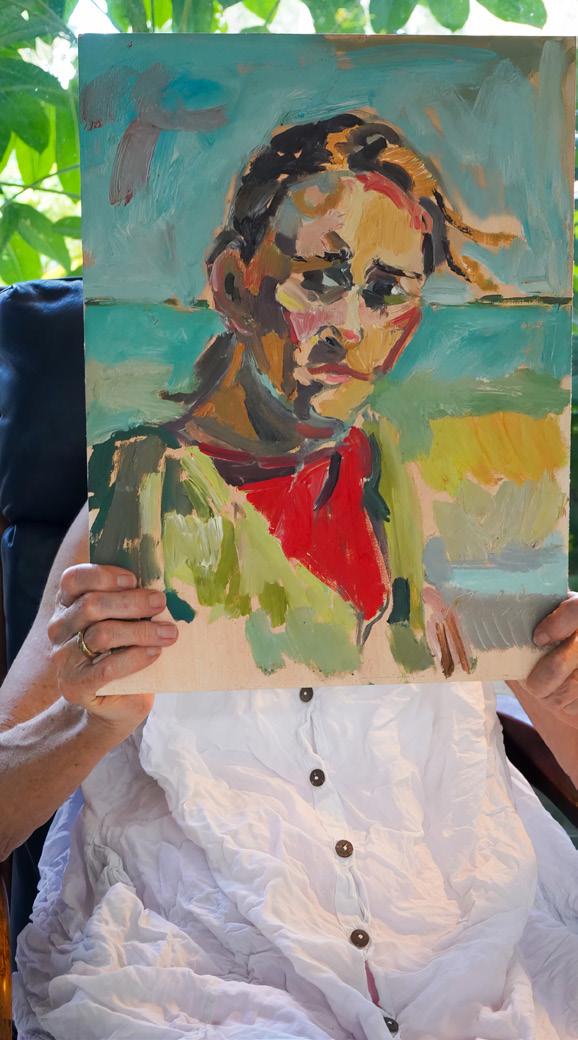


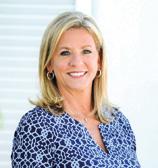

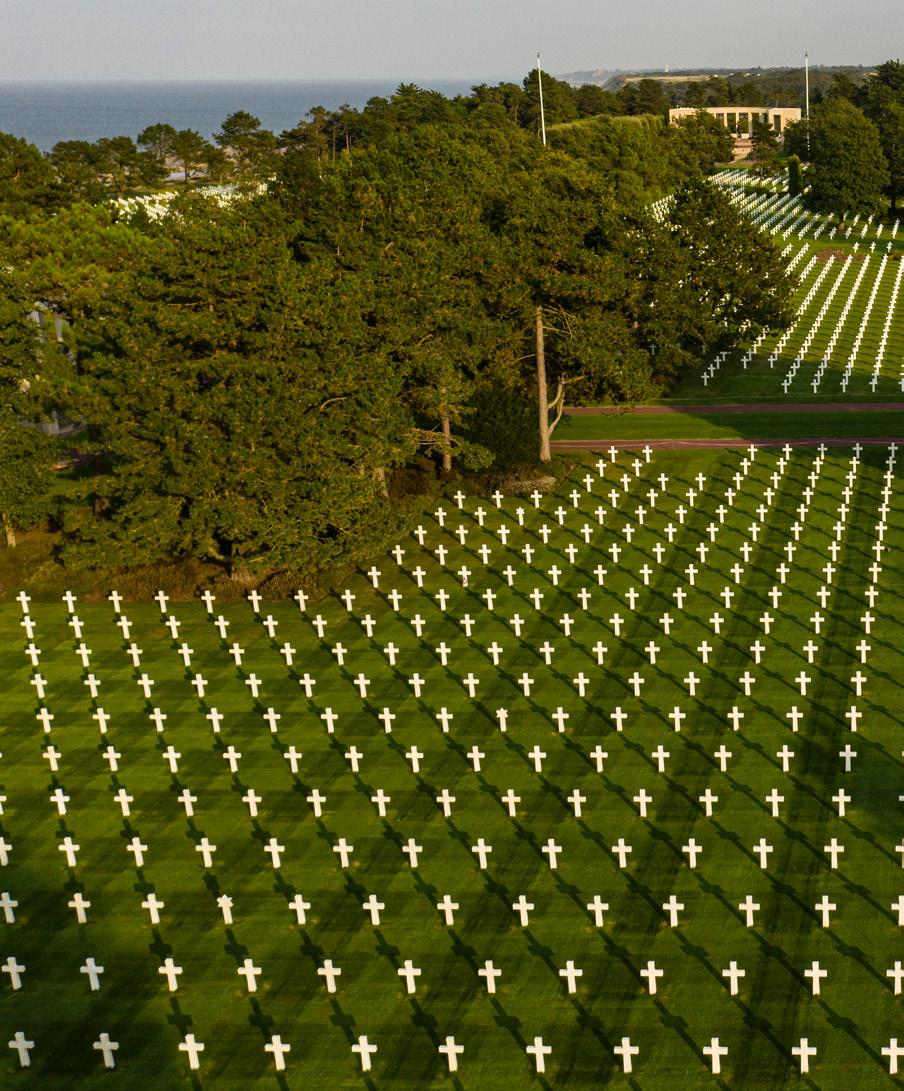
D-Day, June 6, 1944
Normandy American Cemetery and Memorial Colleville-sur-Mer, Normandy, France
Overlooks Omaha Beach and the English Channel Graves of over 9,300 American service members


by Jim Field
November 11th marks Veterans Day, a national holiday. The occasion honors all U.S. military veterans, living or deceased, who served in the armed forces since the founding of our country.
The holiday originated in 1919 as Armistice Day, commemorating the end of World War I the previous year, November 11, 1918. In 1954, the federal government renamed the day to recognize all veterans across our history, not just those who served in “the war to end all wars.” Importantly, Memorial Day in May specifically honors those who perished while on active duty.
I served for nine years in the U.S. Navy, from 1972 to 1981. I enlisted as a senior in high school, attending boot camp in San Diego, CA. I volunteered for submarine duty, graduated from Submarine School in New London, CT, and spent my entire career in the submarine fleet.
My first submarine was the USS Grayback (LPSS-574), homeported in Subic Bay, Philippines. The Grayback was a diesel-electric boat outfitted with two large lock-in/
lock-out diving chambers, from which we launched SDVs (Swimmer Delivery Vehicles) operated by SEAL Team 1 out of San Diego. Our homeport positioned the sub close to Vietnam. I spent four years on the Grayback as a Navigator and Navy Diver— my dual specialties. (Note: an SDV from my period, designated a Mark VII, can be seen at the National Navy UDT-SEAL Museum on North Hutchinson Island.)
My second submarine was the USS Blueback (SS-581), homeported in San Diego, a diesel-electric fast attack. During my two years onboard, I spent a year in Asia, six months in South and Central America.
My third submarine was the USS Darter (SS-576), also a diesel-electric fast attack, homeported in Sasebo, Japan. Following two years on her, I left the Navy and returned to the U.S. (Boston) to attend college.
My time in uniform was an exceptional period in my life. I was young and unencumbered. I loved my nine years on sea duty—traversing oceans inside a small, complicated machine. My shipmates meant everything to me. At that time, there was no global positioning system
(GPS) of satellites—I was lucky enough to navigate by ancient and rudimentary modern methods--sextant, Loran A and C, dead reckoning, land sightings, fathometer, intuition. The men I served with represented a true cross section of American society, weighted heavily towards those from families without money. They were smart, talented, clever, dedicated, fearless, men with an amazing sense of humor and mischievousness—the makings necessary for individual and group survival. It was a privilege to serve my country and be their shipmate.
I share this background for three reasons. First, to convey that those who join the military can wind up doing some very different and interesting things—an understatement for many. You volunteer, you get sorted and assigned, you perform your tasks, you do your very best, you make it work. There is an ethic underlying this orientation that is very, very special.
Two, those in uniform often exist in a world totally different from civilian life. You are physically and mentally removed— often for long periods. There is a different
language, different mindset, different way of behaving, different ethic, different everything. Civilians cannot claim to understand military culture. The culture, in turn, never leaves the individual.
Finally, I served my time, honorably. As such, I think I have a right to share my thoughts below, having, in my own way, been there and done that. In short, I’m not speaking entirely out of turn.
My purpose in writing this article is to share a number of “truths’ about the military itself, its role in our society, how our nation treats those who serve, and the biggest threats to the military today. Please know that these are my viewpoints and opinions only; take them for what they are. Should you disagree, be kind: we are all entitled to our own world view.
The foremost purpose of Veterans Day is to thank veterans for serving and celebrate their giving of self to protect and defend our nation—its people and our rights and freedom. The sacrifice made by some veterans is immense, including loss of physical and psychological health, and sometimes loss of life. Our cemeteries— across the globe—are full of dear souls who suffered terrible, terrible deaths. Many veterans among us—neighbors—have been through terrifying trials. The lesson here is that Veterans Day parades and picnics should be joyous, pride-filled affairs. But just beneath this surface there should be tangible, utter sadness for the human damage wrought by military readiness and conflicts. Rather than thank a veteran for their service, take their hand, look them lovingly in the eye, and hug them. They will know your gesture extends to them and those they served with.
Here’s a question for you: what percentage of citizens today serve on active duty in the military? Answer: less than 1 percent. Counting active duty and reserves, the number is still under 1%. Finally, if we factor in military families, then the number is around 1%.
What might be said about a democracy where 1% of its population bears responsibility for national defense? To be sure,
our all-volunteer military is the finest in the world—thank goodness for that—but to me it seems unbalanced and shameful to have 99% of the population benefit immeasurably from the blood, toil, tears, and sweat of so few. Worse still, it would seem damaging to our nation in the long-term when so many citizens are isolated from the terrible costs that often accompany protecting our way of life on a global scale.
I have always been an advocate of a draft with two optional pathways: the armed forces or a civil organization dedicated to public service (e.g., teaching, conservation). The principles at stake are many: attending to huge national needs, fulfilling a sacred duty inherent in citizenship, benefiting as individuals from actively participating in the American experiment. I can recall, decades ago, a Veterans Day occasion when the New York Times devoted both the op-ed and editorial pages to proponents versus detractors of a draft, and feeling enheartened by the simple fact that others felt like I did.
I am embarrassed to admit that I do not know a single family that lost a loved one throughout the entirety of the wars in Iraq and Afghanistan. What rarified air do I live in? At least I recognize it, a slightly lesser omission than being oblivious to the fact. The reality is that we, the overwhelming majority, subcontract out our national defense and its sacrifices to a handful of individuals and families. This fact must dictate that whatever gratitude we feel towards our veterans and their families, we need to double down on our indebtedness and do more for them, in tangible ways, that extract sacrifices on our part.
Very soon, veterans of World War II will have all passed away. Approximately 16.1 million U.S. citizens served in the military by the time World War II ended in 1945, representing 12% of the population. Around 39% were volunteers, 61% draftees. During the conflict—1941-1945—671,278 were wounded and 407,316 killed.
For the U.S. in the Korean War, 1950-1955: 1,789,000 military personnel served in theater, 103,284 wounded in action, 33,686 battle deaths, 7,586 missing.

For the U.S. in the Vietnam War, 19551975: 3,403,000 military personnel deployed to Southeast Asia, 55% conscripted by draft, 153,372 wounded in action, 58,220 killed, 2,646 missing in action (originally). The post-Vietnam era was unique in that it was the first time that PTSD (Post-Traumatic Stress Disorder) was given a formal, clinical definition. According to the VA, roughly 30% of Vietnam Veterans have suffered from PTSD at some point in their lives.
The U.S. in Iraq and Afghanistan: Afghanistan, Operation Enduring Freedom (OEF) 2001-2015; Afghanistan, Operation Freedom’s Sentinel (OFS) 2015-2021; Afghanistan, Operation Enduring Sentinel (OES) 2021-potentially ongoing; Iraq, Operation Iraqi Freedom (OIF) 2002-2010; Iraq, Operation New Dawn (OND) 20102011; Islamic State-Operation Inherent Resolve (OIR) 2014-potentially ongoing. Iraq statistics: 1,500,000 military personnel deployed, 4,492 killed, 32,222 wounded. Afghanistan statistics: 775,000 military personnel deployed, 2,218 killed, 20,093 wounded. Researchers estimate 16% of these veterans exhibit symptoms of PTSD.
Service men and women perish and are injured routinely while performing assignments, whether in hostile areas, undertaking training and readiness exercises, or performing day-to-day tasks. Indeed, this is to be expected given the types of machinery operated and duties accomplished. Aircraft operations are innately dangerous and risks elevated in poor weather conditions. My period in the submarine service was darkened by the loss of two fast attack nuclear submarines: USS Thresher (SSN-593) in 1963 off Cape Cod, 129 crew lost, and USS Scorpion (SSN-589) in 1968 off the Azores, 99 crew lost. What goes unreported is the vast number of

military-related near-accidents, or catastrophes narrowly avoided. Most veterans can tell you multiple harrowing personal stories. In sum, a meaningful number of military personnel go to work, or deploy overseas, and fail to return alive or return with serious injuries.
The overarching insight about peril in the military is that the individual can determine their starting probability. Many veterans choose a career path or duty station for which this probability is extremely low—e.g., an administrative desk job in Oklahoma. Others sign up and compete for elite positions and duty assignments where the starting probability is high, and escalates even higher when they find themselves on the sharp point of the spear—when an opposing force has something to say about overall probability. Some will directly face enemy elements; others will operate complex systems; others will operate in extreme environments; others will operate in the presence of all of these. Importantly, the starting point is sometimes dictated by the “system,” but overwhelmingly by individual choice. Patriots volunteer to put themselves in harm’s
way for their nation—they take a giant step forward from the group—knowing the potential cost. This is why we should revere their character and selflessness.
Following the U.S. withdrawal from Vietnam, the military services were in shambles—a state of complete disorder and disarray, lacking discipline, motivation, morale, confidence, and eventually budget—especially the Army and Marines. The recovery would be decades in the making—an extended period of introspection, self-criticism, and atonement necessary before rebuilding could take place.
The war was brutal for some troops. Of the roughly 2,600,000 U.S. personnel who served in Vietnam, only about 25% were assigned to combat units, while the rest were in support roles. A typical infantry soldier would depart California by commercial airliner and hop across the Pacific, landing in Saigon or a large military base (e.g., Danang). They would then be airlifted by helicopter to a front-line unit, taking the place of wounded and/or killed men. The clock would then start for a standard 12-month tour of duty. If you survived, on day 365, you would be airlifted out of the jungle by helicopter, flown across the Pa-
cific, and discharged at night—so as to go unnoticed—into a California location—all within a one to two week time span. Thus, jungle to San Francisco to home—all in the blink of an eye. How cruel.
Only years later would the American public awaken to the immense trauma inflicted on a generation of men and women. PTSD entered the national dialogue. Apologies were made for rejecting this newest class of veterans as a whole, for labeling them “baby killers.” A distinction was eventually made between those who served honorably and selflessly, and those in government who put them there, and the military leadership who chewed them up.
I distinctly remember in the 1980s that the American government and public swore a solemn oath that they would never again allow military veterans to be treated like this again. At the same time, the Veterans Administration (VA) did a mediocre job (at best) of managing benefits, and the Veterans Health Administration (VHA)—operator of hospitals and outpatient sites—was a mixed experience for needy veterans, ranging from grades of a solid C to F. The worst-off subset of veterans existed on society’s periphery. Still, the national pledge was that we would never do this again to our veterans.
And yet we have. We all know that the VHA remains a mediocre healthcare system. We have all heard about long wait times to see VA providers—especially for mental health services. We know there are too many homeless and marginalized veterans.
In Iraq and Afghanistan, 52-55% of all U.S. combat deaths were caused by improvised explosive devices (IEDs). However, because of the Army’s exemplary Field Hospital system—today’s modern equivalent of a MASH unit—about nine out of ten wounded soldiers survived, a dramatic improvement over previous wars. The upshot of this is that many battlefield injured veterans returned home to live with horrific disabilities and disfigurements requiring long-term physical and psychological therapies and supportive services.
And we know many are underserved. On one hand, charities have raised millions of dollars to build and gift specialized homes to severely disabled veterans and their families—we know this from TV appeals.
On the other hand, why are charities addressing this need—in small numbers, doing the best they can—and not the U.S. government? It takes an immense effort to keep injured veterans engaged with the VA; mental injuries are rarely “cured” but must be managed across a remaining lifetime—all of which is extremely costly.
Somehow the U.S. government can effortlessly spend and waste hundreds of billions of dollars on nonsense expenditures—the abuses we all know about are scandalous and absurd. But assist veterans like we pledged we would?—no way. Our government leaders and citizens have a short memory—based on, I hate to say it, purposeful indifference. Aren’t we lucky our service members don’t act the same way?
Diversity, Merit, and Inclusion
President Harry S. Truman ordered the desegregation of the U.S. military on July 26, 1948, by signing Executive Order 9981. “There shall be equality of treatment and opportunity for all persons in the armed services without regard to race, color, religion or national origin.”
In all my years in the Navy, I never experienced a single incidence of abject racial discrimination or animosity among my shipmates. On submarines, no one cared about a man’s race, religion, education, family background, pedigree—or more commonly, lack of one. This simply didn’t matter—we had real things to worry about. What mattered was if someone worked hard, attended to details, was reliable, could be trusted completely, learned from mistakes, would have your back. Those who didn’t fit in were reassigned; there was zero margin for error in our work. All the same, everyone had an assigned nickname (many not flattering), we razzed each other relentless, and cut no one any slack. But race, color, religion?—an individual who tried to introduce that crap would have been removed immediately from our crew.
On larger ships in the fleet, in the early 1970s, there were full-scale race riots. (One example, on October 12, 1972, while en route to its station in the Gulf of Tonkin off Vietnam, a race riot erupted onboard the carrier USS Kitty Hawk (CV-63), involving more than 100 sailors, with 46 injured.)


Still, it would be fair to say that since Truman’s desegregation in 1948, the U.S. military has stood as the singularly best example of a “progressive” (used in a positive way) institution in the U.S. government, a living example of how good things could be if success was based upon work ethic, teamwork, leadership, and merit— with everything else deemed irrelevant. The grandness of the military’s mission, its ethos of sacrifice and courage—enhanced by dangerous conditions—created the conditions where the character of an individual mattered most and determined that person’s career trajectory.
Contrast this with what has happened in the U.S. military with the introduction and mandatory consumption of DEI principles during the prior administration. This divisive framework proved highly corrosive to the high ideals, cohesiveness, and battle readiness of the military, carried out by people unworthy to serve. Every veteran I know is livid about this fouling of our military community. Is it any wonder that the military missed its recruiting goals by tens of thousands in each year of the prior administration? Who would want to serve in such an environment? Couple this with forced Covid-19 vaccination or face involuntary discharge.
Worthy veterans want the military cleansed of such divisive ideology. Restore the merit-based culture that has made our military the best in the world.
“General and flag officers” is the formal term applied to the military’s senior most leadership—those with a rank of general or admiral (of which there are multiple levels). Currently, this number stands at just over 800—which many consider too high by a quarter. These men and women perform important, difficult tasks. Some build capabilities. Some direct cold and hot conflicts. Some lead and represent their respective services in interactions with civilian officials in the Executive and Legislative branches of the federal government.

Arguably, the most difficult assignment is working effectively with civilian leadership. Admirals and generals in such positions must walk a fine line between duty to the uniformed men and women they represent, duty to the Constitution, and duty to the Commander in Chief, the President of the United States.
Our system of governance is purposefully designed to impose checks and balances on individuals holding positions of power. An implication of this is the frequent occurrence of tension and conflicting interests between the highest military ranks and civilian leadership.
There is a long-standing ethic in the military that the solemn duty of senior-most officers is to present the military’s position on major issues to civilian leadership fairly, honestly, and with conviction—to put it out there, fearlessly. Should civilian leadership disregard this advice, the officer has a choice: go along, or resign in protest should they feel strongly enough about the likely negative consequences of the decision(s) in question. Critically, if
they go along and remain in their position, their singular duty is to carry out whatever orders they are given. In brief, there is a time and place to critique and push back, but once a decision is made, it’s time to get onboard.
But what of the duty to resign in protest—short of death in combat, among the highest orders of self-sacrifice for one’s country? Well, truth be told, throughout our country’s history, senior military leaders have embraced this ethic unevenly. It takes amazing—stunning—courage of conviction to resign from one’s lifelong profession over matters of principle, even if crucial to the nation’s well-being. Still, this is what is expected of our highest ranking military leaders—all 800+ of them—it is fundamental to the job. If you don’t accept the possibility of this outcome, don’t take the promotion.
In recent years, it is my humble opinion that our senior-most military leaders have all but abandoned this ethic—with very few exceptions—and caved to civilian leadership. They have acted in their own self-in-
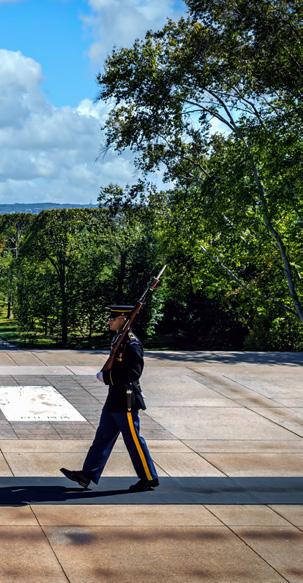

terest, to protect jobs, social standing, and pensions. As a result, they have exposed and subjected military personnel to the dire consequences of reckless, dangerous decisions made by civilian leaders—that is, our politicians. Indeed, many of these senior officers have seen fit to become politicians themselves, foregoing martial duty for palace gamesmanship, intrigue, and theatre. What is damaged most by this? Answer: a necessary check and balance to offset misguided political leadership, leading to catastrophes.
We fought a 20-year war in Afghanistan and Iraq with nothing to show for it. Can you recall a single resignation by a senior military officer of consequence? We suffered a staggering final defeat, surrender, and withdrawal in Afghanistan—remember Abby Gate at Hamid Karzai International Airport in Kabul, where a suicide bombing killed 13 U.S. service members and more than 170 Afghan civilians? Can you recall a single senior military officer who was held accountable for this, either sacked or court marshaled? Neither can I.
Worthy veterans want military leaders who will stand up to politicians with intelligence, honesty, and raw courage, putting themselves on the line, just as a soldier is expected to do in combat. To surrender one’s professional judgement for self-preservation is cowardice. To believe one can remain in seat and still be effective—after being marginalized and boycotted—is equally spineless. Politicians will always be politicians—meant pejoratively, prone to cavalierly commit—if the last 75 years is representative—your children and grandchildren—or rather, 1% of them—to fight and die in foreign wars of no real consequence to national security and our way of life. As such, our military leaders are supposed to be the last line of sanity— knowing the horrors of war all too well— against the needless spilling of American blood—by the best patriots among us.
I will close, remembering and thanking all those who have served. I will close, praying for those who have served and were injured or killed in service to our nation. I ask the common citizen to support our men and women in uniform. I pray for senior military leaders to demonstrate the moral strength to state and defend the convictions of the military chain of command, and fall on their sword if required. Most of all, against all odds, I pray for politicians who will not ask their fellow citizens—just starting their lives—to die for worthless causes.
by Jim Field
This image stands as one of the most iconic photographs from the Vietnam War. I first saw it in Life Magazine, which came to our home, bringing us current events from around the world in its big-picture format.
The cover of the March 8, 1968 issue showed U.S. Marines at war, it’s title reading “Hue/Citadel/Dong Ba Tower.” The main feature inside was a photo essay on the battle. The picture shown here was the largest photograph—a two-page spread.
I remember looking at it, stunned and shocked by what I saw. It scared the living daylights out of me. War, indeed, was repulsive, simply awful, I thought, admitting this for the first time. Up to this point, I had paged through dozens of books on World War II, fascinated by the action and drama. But this was different. I was 14 years old.
Most evenings I watched the CBS Evening News with my parents, Walter Cronkite anchor. I knew the names of every CBS correspondent in Vietnam. We listened to body count numbers: North Vietnam, South Vietnam, United States. The film footage we watched—rushed half-way across the globe in record time—showed ample violence. The difference was that I could study the photo closely, taking in every detail. And then there was the young soldier, lying flat, his face frozen, in permanent view. Was he alive or dead? I wanted to cry.
The raw emotion I felt was fed by a host of ugly realizations. I would never know what happened to him. He looked a lot like any number of boys I grew up with and knew well—this could happen to them. And this Marine could very well portend my brother’s fate—my brother could literally take his place—should circumstances change. At the time, my brother was half-way through his freshman year at Northwestern University in Evanston. He thus had a draft deferment. But what if they came for him? What if he went to Vietnam? What if he ended up being this boy? The possibility of this terrified me, like nothing I had ever thought of.
Context and Photographer John Olson wanted to be a world-class photojournalist since he was 12 years old. He was drafted in 1966 when he was 19 and got himself assigned to Vietnam as a photographer for Stars and Stripes, the official newspaper of the U.S. military.
On January 30, 1968, the enemy launched a surprise coordinated attack on over 100 military and civilian control centers across South Vietnam, encompassing 36 provincial capitals and committing 84,000 North Vietnamese Army (NVA) troops. That day marked the beginning of the Vietnamese Lunar New Year holiday— catching the U.S. and South Vietnamese commands off guard—and would be called the Tet Offensive. The next day saw the bloodiest day of the entire war for U.S. personnel: 246 dead.
Olson spent the first day of Tet in Saigon. A few weeks later he was dispatched north to Hue—an ancient imperial capital on the Perfume River—where brutal fighting ensued. Originally, Marines had been sent to Hue on a temporary basis only,
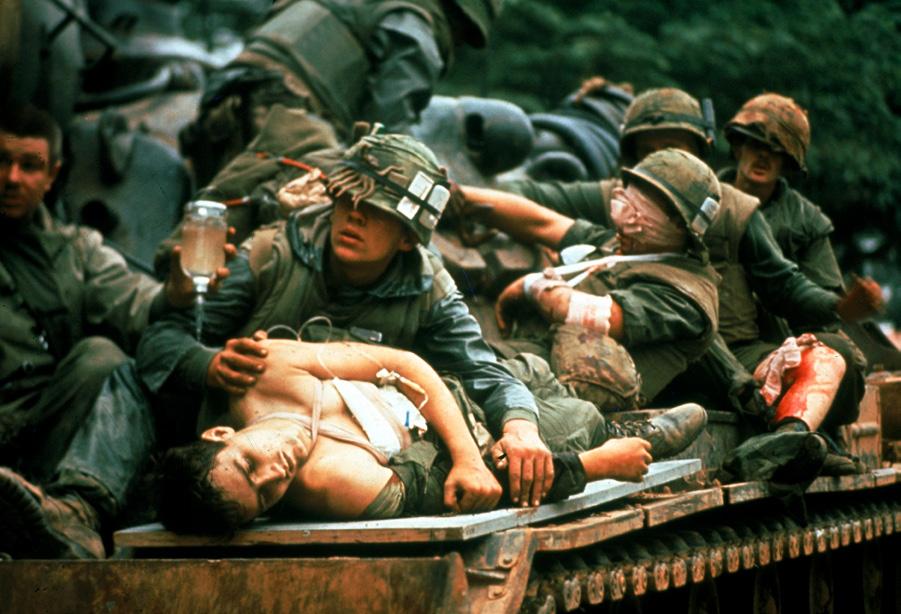
to “clean up” a couple of hundred enemy. Upon arrival, they discovered 10,000 heavily-armed and dug-in NVA and Viet Cong defenders waiting for them. Mayhem and carnage ensued. Used to fighting in jungle terrain, the Marines faced urban combat, house-to-house warfare.
Olson joined the 1st Battalion, 5th Marines. He took five cameras with him: shooting black-and-white for Stars and Stripes and color for film he might sell. The fighting was so intense he lost all sense of place and self. Tanks were being used to ferry wounded and dead away from the front line, only a few blocks away. A tank stopped in front of him—unknown to him, loading three soldiers who had been wounded by shrapnel from a mortar explosion. He shot pictures, not recalling any specifics, just pointing. He would later call it “missing time.” The scenes were so
horrific his mind blocked it out. (He later won the prestigious Robert Capa Medal for his work.)
The Young Soldier
His name is James Blaine, Private First Class (Pfc.) rifleman with Charlie Company’s Third Platoon. He was born on March 22, 1949 in Moscow, Idaho. (My brother was born in August 1949.) His father, Jim, was a veterinary doctor; his mother, Ann, had trained as a nurse. He was the second of nine children. The family was Catholic. Jimmy—the family called him—played high school basketball and pole-vaulted before enlisting in the Marines in May, 1967. His parents wanted him to join the Air Force or Navy; he wanted to go where the action was.
Jimmy was a hard worker. He moved water pipes at a fruit farm before school. He rode
bareback broncos in rodeos in Idaho and Montana. He was quiet and tough, but known to be a kind young man.
On February 15, 1968, Blaine’s platoon was heavily engaged. Communications were out. Runners were being used to leave the front lines and go back a block or two to update commanding officers and relay new orders. Blaine volunteered to go and in exposing himself was struck by a bullet in the chest. A Navy Corpsman treated his wound as best he could. Blaine was placed on a door (makeshift stretcher), carried away from where he was shot, and lifted atop a tank, for a ride outside the combat zone. He passed away later that day. He was a month and days shy of 20 years old.
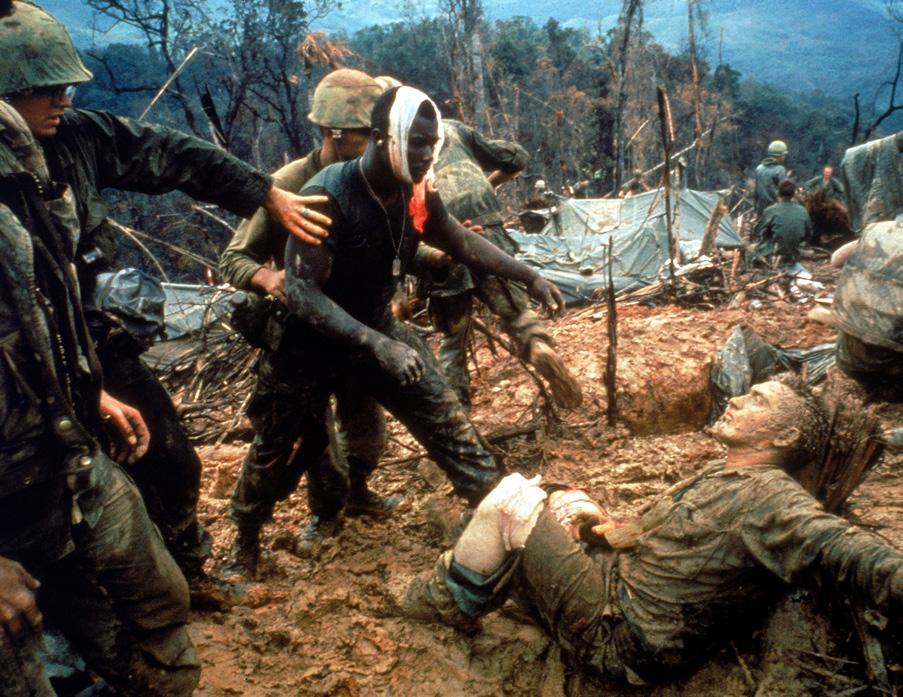
Reaching Out, October 5, 1966,
The Photograph
This was a second photograph I encountered, albeit later in life—originally appearing in Life Magazine before my attention span had matured—that has mesmerized and haunted me. In recent years, I have read extensively on the photographer, Larry Burrows, who is considered one of the greatest—perhaps the preeminent—photojournalist of the Vietnam war.
The setting is Hill 484 (denoting meters above sea level), located near the Demilitarized Zone (DMZ), Quang Tri Province, South Vietnam.
The Context Operation Prairie, U.S. Marines, 3rd Battalion, 4th Marines. Hill 484 was the site of a fierce and devastating battle between U.S. Marines and NVA forces. The terrain was mountainous, covered
in thick jungle and often clouds, making troop movement and air support difficult.
The NVA used Hill 484 and a series of other nearby hills to infiltrate into South Vietnam and set up artillery positions.
From early to mid-October 1966, Marines assaulted Hill 484, the NVA defending tenaciously from well-dug bunkers, employing booby traps, snipers, and interlocking fire. Tropical rains turned the battlefield into a muddy quagmire. Combatants wouldn’t see each other until yards away.
The Marines seized Hill 484 after several days; the NVA withdrew and regrouped elsewhere; the hill changed hands repeatedly in later months. The battle was one of dozens where ground was taken at great cost—considered a tactical victory by commanders—only to be abandoned soon thereafter.
The Photographer Larry Burrows (1926–1971) was a British photojournalist who became a legend for his powerful body of frontline battlefield work and many years spent covering conflicts across the globe. In the 1950s, he covered stories throughout Europe, the Middle East, and Asia. From 1962 to 1971, he covered the Vietnam war almost continuously, working for Life Magazine.
In February 1971, his helicopter was shot down while covering Operation Lam Son 719—the South Vietnamese Army’s incursion into Laos—with all onboard killed—the crew and two other renowned war photographers. Their remains were located and recovered in 2008.



A
by Jim Field
Concierge medicine is a relatively new physician practice model, tracing back to two Seattle physicians in the 1990s. Today, concierge medicine represents a small but growing segment of U.S. primary care services—involving an estimated 10,000 physicians.
Years ago, the quintessential family doctor provided the type of care that concierge physicians seek to provide: lots of time spent with your physician, when you want it; a single physician who knows you well and will plan and coordinate the care they believe will optimize your health; a physician with knowledge of other good physicians and healthcare organizations to whom they will refer you to, and help you understand and manage this relationship and the care you will receive.
The historic practice model for most physicians was small practices, perhaps practicing alone or with a few colleagues (to share expenses). Over the past two decades, the physician workforce underwent a historic transition towards “corporate medicine,” whereby individual practices were purchased by business entities, aggregated into large group practices, and systematized
and professionally managed to operate efficiently and profitably.
“Acquired” physicians became salaried employees, involving benefits and drawbacks. On the plus side, they would no longer be running small businesses, responsible for liability insurance and practice costs, leasing office space and hiring and managing office staff, providing call coverage on many weekends. In return, they would relinquish control over how they practiced medicine, both in terms of their personal schedules and how they would medically treat patients, deferring to standardized protocols.
The management of these practices could be equated to factories, emphasizing volume, throughput, cost per encounter, measuring and optimizing performance parameters, achieving standardization. Some physicians spoke about being cogs in a wheel. Currently, an estimated 77% of U.S. physicians are employed by hospitals, health systems, insurance companies, and other business entities.
In this context, concierge medicine is a movement to return to an earlier era, when medicine was based on a
close relationship between patient and physician that would last over time, and physicians worked for themselves, determining how they would spend their day, interact with patients, and prescribe care. Conversely, many patients have pushed back against the less attractive aspects of large group practices, looking for options to feel more closely tied to caregivers whom they can rely on and trust to keep them healthy and help navigate the larger healthcare system.
Physician practice economics place a limit on how many physicians can feasibly transform their practice into a concierge model. The key tradeoff is seeing far fewer patients during the work day—sacrificing income based upon volume seen—in exchange for higher payment per visit, netting the same total income. This is possible by charging patients an extra fee, commonly referred to as a retainer, often applied for a full year and cash-based (diagnostics, therapeutics, drugs, bring separate payments). Thus, the central ingredient necessary to run a successful concierge practice is the ability to attract a sufficient number of patients who will pay the established retainer. Every market will have a different profile for supporting a giving number of financially viable concierge practices.
CONCIERGE MEDICINE IS A MOVEMENT TO RETURN TO AN EARLIER ERA, WHEN MEDICINE WAS BASED ON A CLOSE RELATIONSHIP BETWEEN PATIENT AND PHYSICIAN THAT WOULD LAST OVER TIME.

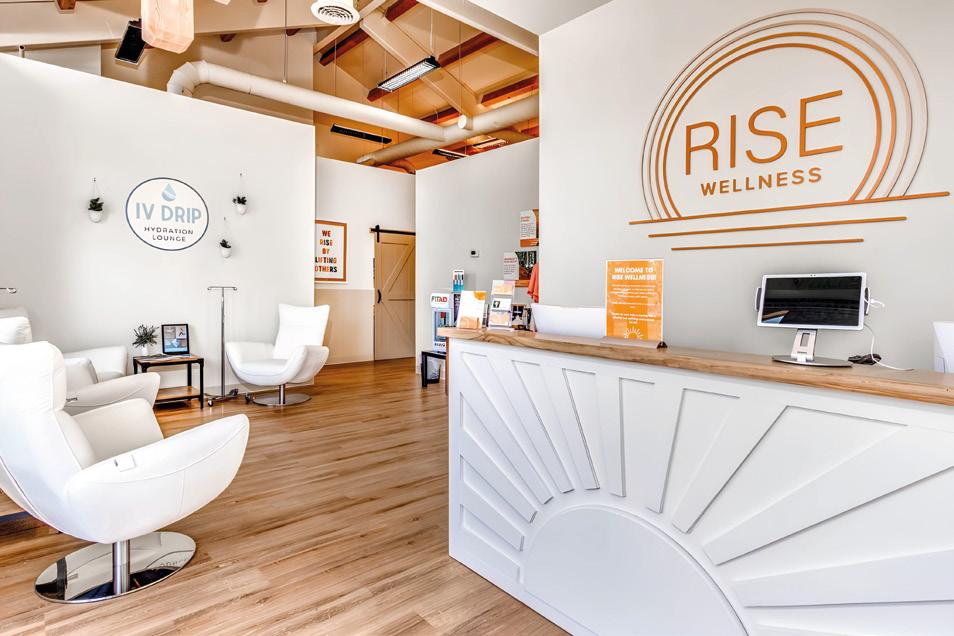

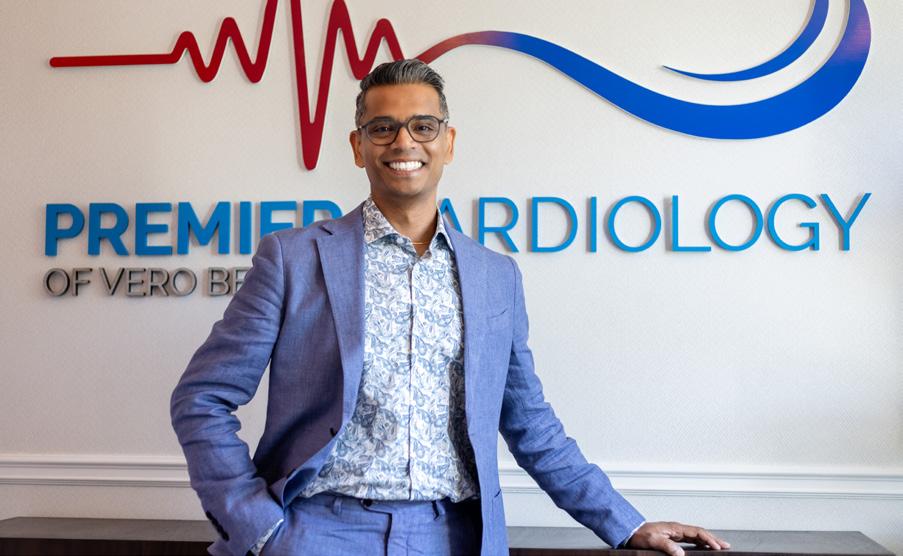
conducted by Jim Field photography by Yuri Semenyuk
Editor’s note: Concierge medicine is most commonly organized around providing primary care services—that is, front-line care focusing on disease prevention and maintaining overall good health.
Dr. Vikranth Gongidi’s concierge practice, in contrast, delivers a mix of primary care and specialty care services, encompassing diagnostics and therapies within the traditional scope of internal medicine and medical cardiology.
Having worked in cardiovascular services for most of my healthcare career, I was
intrigued by Dr. Vik’s practice model, eager to learn about his approach to patient care. What follows is our interview together, conducted in his office suite on 37th Street. I am indebted to Dr. Vik for spending time educating me about his work and passion.
JF: Why don’t we start with a brief background on yourself, and how you found your way to Vero Beach.
VG: Of course. I was born in India. My parents moved to North Carolina—the Research Triangle area—so that’s still home for me. I attended UNC Chapel Hill for undergrad. Then I spent a couple of
years doing research in neuroscience, which was a great precursor to medical school in California. Following graduation, I did my residency at Michigan State and cardiology fellowship in New Jersey. So I got to see a good cross section of healthcare across the country.
Completing my fellowship, I was finished with the hardships of cold weather—I just didn’t want to deal with ice and snow. One winter I went through three blizzards! I grew up in a small town in North Carolina, and I liked this. I also wanted to come back south. So those were the drivers that took me to Florida.
Initially I practiced cardiology in Melbourne, moving to Vero Beach in 2014 and joining the staff at Indian River Hospital as a private practitioner. We had a great heart team at the time. Then the medical center transitioned to the Cleveland Clinic, and I became an employed Cleveland Clinic physician. I served for three years as the Director of Cardiology. And finally, two years ago, in 2023, I left the Cleveland Clinic and opened my concierge practice. I have two young boys, and Vero Beach is an ideal place to raise them. So we’re very happy living here and with the way my career has evolved.
JF: Tell me about starting your concierge practice, what the impetus was and what you wanted to accomplish.
VG: Well, we all know that healthcare as a business has changed a lot in recent years, and continues to do so. It’s become very corporate for most doctors. What concerned me most was the short amount of time I’d have to spend with patients—as little as 10-15 minutes—which I didn’t feel was adequate to address all their issues and questions, especially with more complex cases.
In addition, I was finding that patients were often unable to secure appointments to see me quickly—sometimes waiting months—which can be problematic in situations requiring prompt attention and follow-up care. So I wanted to have better control over my schedule, enabling me to spend ample time with patients, and as a function of this, deliver a high level of personalized, coordinated, timely care that they understand and participate in. I am the sole physician in the practice, and I have an Advanced Practice RN (APRN) assisting me.
JF: Very nice. Can you describe your practice for me, your approach to patient management.
VG: So I have a limited number of patients in my practice, and I take very good care of them. I educate them about their current state of health, what personal behaviors will contribute to improving their health, what care I think they should receive to improve their health and quality of life. Patients have families as well, and I will involve all family members in the care of their loved one to the extent they want. It’s a partnership—patient, family, physician—
that’s how I look at medicine.
My appointment slots are usually an hour in length, giving us ample time to learn from each other, discuss details about their current situation and health status, discuss care options and identify solid next steps, which I set in motion and coordinate.
My goal is to see patients immediately if necessary, or within a day or two for a routine appointment. In addition, all patients in the practice have my phone number and email address—they can contact me at any time—and they also have the office practice phone number and email address. The office returns all phone calls before they leave at the end of the day. You can always call me after hours and on weekends. Sometimes patients who are snowbirds will call me because they’re having issues up north and can’t get in to see a physician. Finally, you can call me when you travel and get in a bind—I’m here to assist and expedite as needed. In short, we are accessible 24/7/365.
JF: Can you walk me through what it’s like to be a new patient in your practice? How does the process work? VG: For the first visit we will actually start with a 90-minute appointment. We’ll begin with establishing a thorough medical history and baseline of the patient’s current health status. Oftentimes I’ll have access their Electronic Medical Record, and I will review their charts to understand fully what they have experienced and how they have been managed prior to seeing me. During this initial visit I may decide to order diagnostic tests to gather important information that is missing or needs updating. We’ll work through everything together to build an accurate picture of their status that they understand and we can agree upon.
The next time we meet I’ll present the patient with a comprehensive assessment of their current state of health, leading to the development of a detailed plan of care for the future. In executing this plan, I am the quarterback of their care, coordinating every step to ensure everything gets done correctly, all follow-up takes place, and all new information is integrated into their clinical profile.
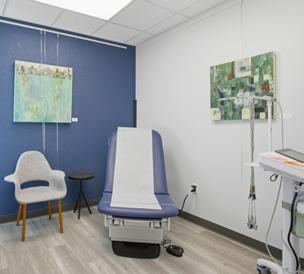
Importantly, this plan of care is customized to the individual. We establish what their goals are for their life ahead, which can take people down very different paths. But knowing these goals and tailoring care to achieve them is best-practice medicine—it’s what I do. For example, you might have a 70-year old patient who isn’t doing well—say, struggling with an advanced chronic disease—and all they want is to live long enough to see their daughter’s wedding or the birth of a grandchild. For a different individual, they may be 98 and largely independent, just requiring someone to coordinate their care and be available— immediately—should something go awry.
For convenience sake, the practice can perform a range of diagnostic tests— for example, blood analyses, EKGs, stress tests, echocardiograms, carotid ultrasound. This simplifies things tremendously for patients and shortens timelines. I interpret the test results and update their profile, refining their care plan as needed. For testing that we don’t perform in the office, we’ll send you to other providers in Vero, arranging everything and receiving the documented findings.
JF: And what if I need to see a specialist for a given procedure—say a cardiac catheterization with the possibility for a coronary stent?
VG: Well, I still have all my connections at Cleveland Clinic Indian River Hospital, and I know the interventional cardiologists, how they practice, their

technologies, their experience, how many cases they do, and so on. I can recommend and initiate a referral, and remain part of the team. Alternatively, you may need open heart bypass surgery, a valve procedure, a pacemaker, and so on, and I’ll set this in motion and remain involved. Certain unusual and particularly challenging conditions may even require a referral to an expert specialist in another city or state, and I’ll manage this—locating the specialist, reaching out to them, presenting your case, asking them in turn about their practice, technologies employed, their case volume and outcomes. I’ll do this preliminary screening and search using my professional contacts and expertise to locate excellent providers, relieving patients of this burden. Frankly, finding the ideal specialist for what you need is a huge contributor to a good outcome, and patients and families aren’t equipped to do this, whereas I am.
JF: I assume that patients in your practice will have histories of diseases beyond just cardiac. How does this work?
VG: Well, I’m board certified in internal medicine, and then cardiology as well. And I’m finding myself doing a fair amount of primary care as a natural extension of caring for my patients holistically. For example, perhaps their diabetes is out of control, or their thyroid isn’t well managed. So I’ll take the initiative and get these managed appropriately. There are patients who have had various cancers, and my plan of care will fully support their goals and needs from an oncology perspective. So my practice has evolved naturally to encompass primary care,
heart specialty care, and a wide range of coexisting conditions and diseases.
JF: Can you tell me more about the option to involve family members in the care you’re providing their loved one? This is so important, for so many people, for so many reasons, but rarely happens in a way we wish it could. I’m thinking about families with older loved ones in Vero Beach and children scattered geographically.
VG: Absolutely. It’s really not difficult to make this happen given everyday technologies like Zoom or FaceTime on our computers and smartphones. I will invite family members, based on the patient’s instructions, to participate in discussions, sorting out how much they want to be involved, when they should be notified of things, who will be making certain decisions, and so on. There are occasions when I’ll have five or six family members connected—and let me tell you, things can sometimes get a bit lively. But it’s very important to involve family members and assist the family to get themselves engaged and coordinated on their end. This can make all the difference in arriving at informed, smart decisions, whether in straightforward or complex cases.
JF. Another important aspect of patient care are those times when we have to go to the emergency department, and possibly be admitted to an inpatient unit. How do you support your patients in these situations?
VG: That’s a great question. The short answer is that I am here to support my patients every way that I can. I will, for example, call the attending ED physician to learn what is going on and participate in and co-manage your care as appropriate. I can fill in the attending ED physician on your medical history and other critical context and information that might otherwise be missing. On the inpatient side, the same applies. I will follow your progress and help arrange things to get done upon discharge, potentially shortening your length of stay. Sometimes patient management and communication in the hospital can slow down with changes in shifts and attending physicians, and I can be a point of continuity, consistency, and follow through. It’s extremely important for every patient to have an advocate by their
side to assist navigating the healthcare system, and I am the ideal person to assume this role.
JF: A final question pertains to fees for concierge access, your services, and various diagnostic testing. How does all this work?
VG: There is an annual retainer for joining the practice that the patient will cover independent of health insurance. This covers all of my services—those we’ve discussed today. The retainer can be paid in a single amount, or broken up across the year if desired. Payment for diagnostic testing is exactly as it would be in any other setting according to a patient’s insurance coverage. I write an order for testing and we process the correct paperwork for the patient to submit to their insurance company. If testing is performed elsewhere, then that testing facility provides the paperwork. In sum, the only difference in payment is the annual retainer.
JF: Dr. Vik, thank you for your time and interest in getting in front of our readers. The market for healthcare is fascinating, in that the market will typically respond with solutions when patient needs aren’t being meet. Concierge medicine is exactly this—a workaround, if you will, for delivering patient-centric and high-quality primary care—and in your case—medical cardiology— emphasizing the doctor-patient relationship and excellent customer service.
VG: Well put. It is an innovative way for patients and families to work closely with a doctor they know and trust in a true collaborative partnership. It’s receiving care the way all of us would want: personalized, a plan of care, organized follow-up. This is the way I envisioned practicing medicine—having this type of close relationship with my patients. I’m so happy I get to do this.
772-494-0794
787 37th St Suite 250
Vero Beach, FL 32960
Email: info@premiercardiologyvb.com
Website: premiercardiologyvb.com
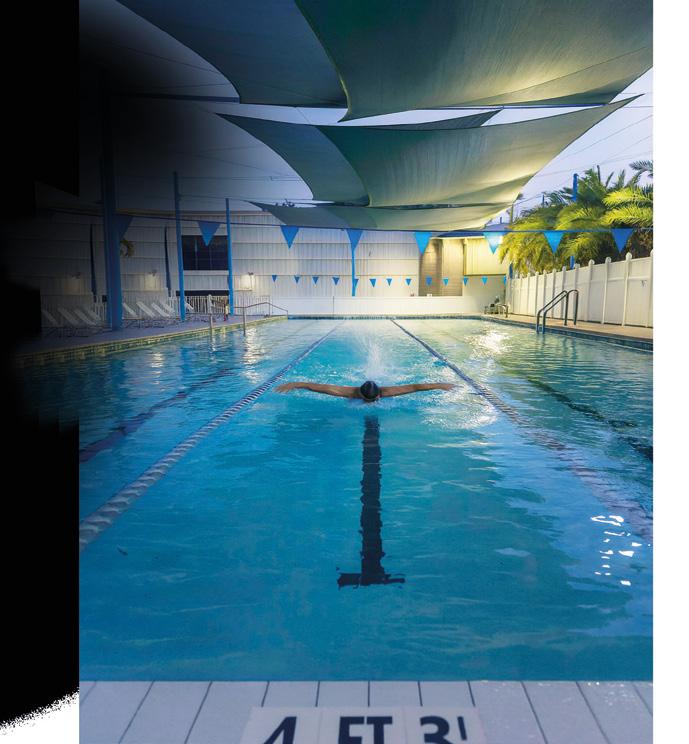
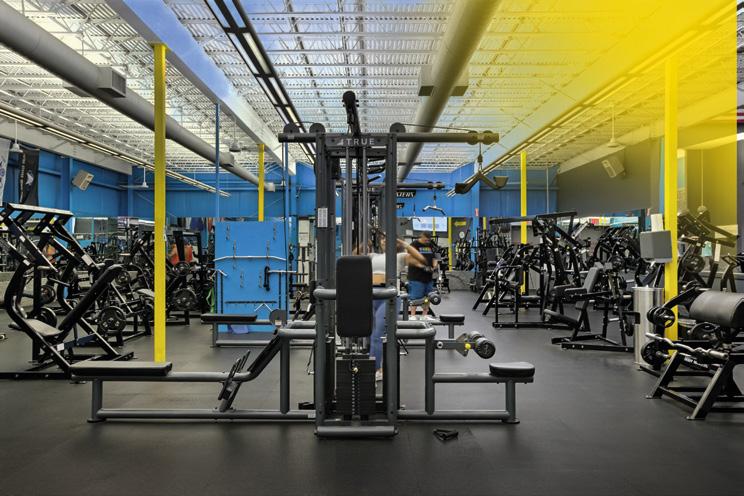


conducted by Jim Field photography by Joshua McMiller
Editors’ Note: November is Lung Cancer Awareness Month! It is observed to increase public awareness about lung cancer—the leading cause of cancer deaths worldwide— and to support prevention, early detection, research, and patients living with the disease.
Lung cancer is often diagnosed late, when symptoms suddenly appear and the cancer has already progressed to an advanced stage. Thus education is vitally important, empowering individuals who may be at elevated risk for lung cancer to take timely actions to protect themselves from the disease.
To this end, this article introduces Dr. Maldonado to our readership, offering a platform for him to speak directly to us about what we need to know about pulmonary medicine, lung cancer, and diagnostic and therapeutic resources offered at Cleveland Clinic Indian River Hospital.
Note: all photographs in this article show Dr. Maldonado and team utilizing RoboticAssisted Navigational Bronchoscopy.
JF: Dr. Maldonado, thank you for contacting us about Lung Cancer Awareness Month, and for sitting down with me. Tell me about yourself and how you came to practice medicine in Vero Beach.
DM: It is my pleasure. Lung cancer has been a passion of mine across my career and still remains a very challenging disease, so I appreciate every opportunity to share important information with our community.
I am originally from Ecuador, attending medical school at Central University of Ecuador. You could say that I was meant to practice medicine because of my family. My father was a gastroenterologist who trained in New York. My mother is a nurse. One sister is a dentist and another a psychologist. My dad took me at an early age to the hospital to make rounds with him.
I always planned to do my advanced training in the U.S., and I went to the University of Miami, Jackson Memorial Hospital, for my internal medicine residency, staying for my two fellowships, one in pulmonary medicine, and one in critical care medicine. Of course, these
specialties lead me directly to lung cancer, one of my areas of concentration and expertise. After completing my fellowships, I spent three years in Lexington, KY to launch my practice career. And then I decided to return to Florida, choosing Vero Beach and Indian River Hospital. I feel very blessed to have found this community, which has been our home for almost 15 years.
JF: Great background. And what is your current position at the hospital?
DM: I joined the Cleveland Clinic staff with the hospital’s transition to the Clinic. I am Section Chief of Pulmonary and Critical Care Medicine at Cleveland Clinic Indian River Hospital. I’m also Vice President of the hospital’s medical staff. Finally, I serve as Florida Regional Director for Interventional Bronchoscopy for Cleveland Clinic Florida.
JF: To start out, why don’t you share some key facts and concerns about lung cancer that every adult should know. For some cancers in recent decades, solid progress has been made in prevention and treatment leading to increased survival. But far less so in lung cancer. Can you please explain this to us?
DM: Let’s start with the big messages. Lung cancer is the leading cause of cancer-related death in adults in our country. Studies suggest that, for any level of smoking, females are at higher risk of developing lung cancer than males. The American Cancer Society estimates that over 227,000 new cases of lung cancer are diagnosed yearly, with over 125,000 lung cancer-associated deaths in 2025. So lesson #1: These numbers are high and very unfortunate.
Throughout the world, most lung cancer is attributed to smoking. As such, prevention through smoking succession, rather than screening, is the most effective strategy for reducing the burden of lung cancer in the long term. In fact, observed declines in lung cancer rates and mortality in U.S. males is due to reductions in smoking prevalence. Still, for past smokers, the risk of lung cancer does not decline for many years after quitting. Accordingly, screening for lung cancer can be very effective in detecting early disease.
Unfortunately, lung cancer screening has been poorly adopted. So lesson #2: Screening is important to early detection, but only about 15% of eligible candidates have been screened. This is unacceptable— we must do better.
Most importantly, clinical outcomes for lung cancer—we’re talking about survival—are directly related to the stage of the cancer at the time of diagnosis. For example, five-year survival rates range from 82% for Stage 1 (least cancer burden) to only 7% for Stage 4 (greatest cancer burden). However, 75% of patients with lung cancer show up for the first time with symptoms already—indicative of advanced local or metastatic (spreading) disease that is not amenable to cure. Thus lung cancer is often called the “silent killer” because it typically develops quietly and without obvious symptoms until it has reached an advanced stage. So lesion #3: Because of this profile, efforts to reduce smoking and increase screening have the most impact on reducing mortality.
JF: This is such good information—and rather frightening—the risk of not knowing you have lung cancer until it’s already too late.
DM: It’s the way this cancer behaves, its unique challenges that make it difficult to prevent and cure. If you look across all individuals found to have lung cancer,


five-year survival rates average only 18%. And this is despite steady advances in diagnostic and treatment modalities that are broadly available.
JF: Let’s talk more about screening, then, since it’s such a critical tool for impacting survival. I assume there are certain people who are ideal screening candidates.
DM: Correct. To begin, our main screening tool is low-dose radiation helical computed tomography (LDCT), or simply CT scanning. These machines generate high-resolution images of the lungs and chest with significantly less radiation than before. Various organizations publish CT screening guidelines for individual candidates. Here is a quick summary: a person in general good health; between the ages of 50 and 80 years old; those with at least a 20 pack-year smoking history who either smoke currently or have quit within the past 15 years; and a family history of lung cancer. Also a few more things: screening should be discontinued once the individual has not smoked for 15 years or has a limited life expectancy; because one-time screening is not optimal for early detection, and tracking suspicious findings over time is important to reduce false positive findings, annual screenings are recommended.
(Note: A “20 pack-year smoking history” is a way to measure how much a person has smoked over time, combining (1) how many packs per day they smoke and (2) for how many years they have smoked. It is calculated as: pack-years = (packs per day) x (years smoked). For example, smoking 1 pack per day for 20 years = 20 pack-years.)
JF: Also, I looked up these guidelines before our conversation, and there are a few other recommendations mentioned that sounded important. Perhaps you can speak to these? First, “screening is best conducted in the context of a centralized lung cancer screening program with dedicated coordinators and screening-specific electronic tools.” And second, it is optimal for patients to “have access to centers with radiologic, pathologic, surgical, and other treatment capabilities, so as to manage indeterminate lung lesions and eventually treat lung cancer.”
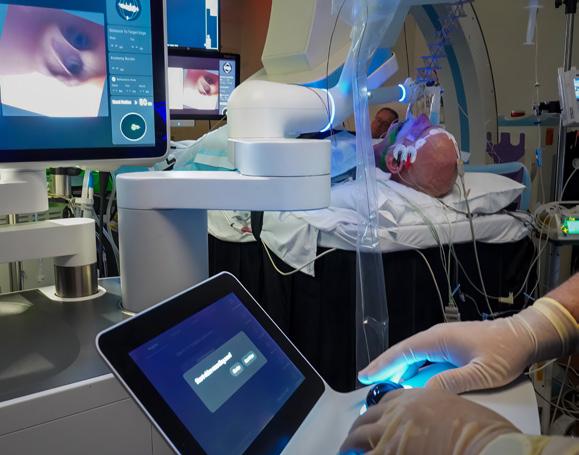
DM: Well, that’s a good transition to what we offer at Cleveland Clinic Indian River Hospital—the program we built and have in place currently. We have our formal lung cancer screening program with referral for low-dose CT scanning. Should a suspicious finding appear, we have full diagnostic capabilities (see below). And if lung cancer is confirmed and treatment indicated, then we have a multidisciplinary team composed of lung cancer nurse navigators, thoracic surgeons, medical oncologists, and radiation oncologists to expedite a treatment plan utilizing the latest science and technology, including robotic lung resection surgery and stereotactic beam radiation therapy. In sum, we have every component of a comprehensive lung cancer program.
JF: And what’s your leading diagnostic tool right now?
DM: I head up a team offering the latest technology for early detection of lung cancer utilizing artificial intelligence and robotic bronchoscopy—technically called Robotic-Assisted Navigational Bronchoscopy. This is a minimally invasive ambulatory procedure that allows the bronchoscopist to safely navigate through the lungs and to obtain tissue biopsies of even small size lung nodules.
The biopsy samples we take are immediately analyzed by pathology, giving us real-time feedback on the type and extent of cancer we are dealing with. For example, the pathologist places the biopsy under a microscope and tells me it looks malignant. At that point, I obtain a good amount of tissue for molecular testing—for analyzing the cancer in detail. So we make the diagnosis right there, and we stage the cancer as well.
JF: That’s amazing precision. I’d like to switch gears now, if I may, and ask about your larger programs and areas of responsibility—specifically, pulmonary medicine and critical care medicine. What do these look like at the hospital?
DM: Critical care medicine is the care of acutely ill patients. We have 15 ICU (Intensive Care Unit) beds for managing such patients, many of whom will require respiratory life support or cardiovascular life support due to the severity of their illness. The ICU is managed by critical care specialists—sometimes called intensivists—physicians specializing in delivering complex care. I’m one of these. The success of the program ties back to a multi-disciplinary team approach, intensivists working closely with critical
care nurses, respiratory therapists, nutritionists, physical therapists, social workers, all doing multidisciplinary rounds together every morning, at the bedside, reviewing each patient, surfacing every detail and potential complication, crafting and executing a plan of care. And we involve other specialties such as neurosurgery, interventional neurology, cardiovascular, and so on. The team manages the ICU 24/7/365.
JF: That’s impressive. And then pulmonology?
DM: When I arrived here 15 years ago, I was the only pulmonologist at the hospital. There were a few others in the community, but in the hospital it was just me. So the program started from scratch,. Eventually I had one partner join me, and today there are eight of us. So it’s been a great journey and we’re very proud of what we have achieved in this specialty. Hospital leadership has been very supportive. We receive a lot of referrals into our program from surrounding counties.
Pulmonary medicine manages emphysema, asthma, chronic obstructive pulmonary disease (COPD), respiratory infections, pneumonia, and the like. This keeps us very busy, given the age of our population. And we do have a good amount of smoking in our community, past and current.
JF: In closing, I want to thank you again for sharing this important information about lung cancer, as well as the program capabilities we can expect to find at the Cleveland Clinic Indian River Hospital. Do you have a closing word of advice for patients on lung cancer?
DM: Sure. Don’t wait, If you think you’re at elevated risk for lung cancer, come see us. We use evidence-based medicine to determine an appropriate screening regimen, which could save your life.

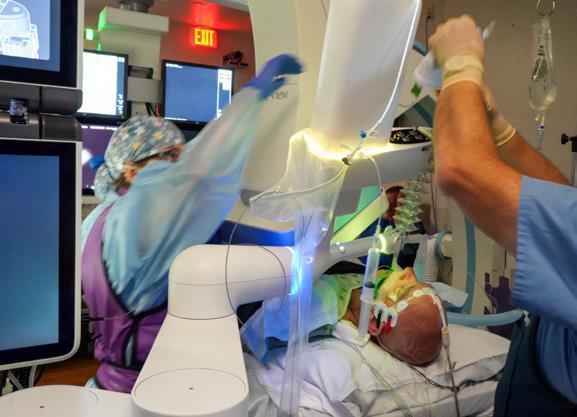
“SCREENING IS IMPORTANT TO EARLY DETECTION, BUT ONLY ABOUT 15% OF ELIGIBLE CANDIDATES HAVE BEEN SCREENED. THIS IS UNACCEPTABLE—WE MUST DO BETTER.”
When curiosity hits all the high notes. Our students rock out and dive deeper into vocabulary, history and culture!








by Jim Field and Renee Morad photography by Yuri Semenyuk and Joshua McMiller
When Kaye Manly first drove through the property of Vero Club Tennis—which was long known as Twin Oaks Tennis Club, a fixture in Vero Beach for decades—she was intrigued. The club’s landscaping was overgrown. The courts were in poor shape. The clubhouse was similarly challenged.
“What a shame,” she thought to herself, “this could be such a special place.” The two-acre property nestled in trees was in an ideal location, radiating charm and potential. The seven tennis courts made it feel like a quintessential small town private club: intimate, accessible, personable, connected.
She had visited that day to hit balls with the club professional, Yohann Prinsen. Over a period of returning to the club to play, she began to secretly entertain the notion of purchasing the club to realize its potential. It was something to contemplate, more fanciful than real. Admittedly, owning such a club hadn’t been on her short list of things to do. Still,
it would be right up her alley.
The original facility had been built many decades ago, and eventually closed for an indefinite period. Then in 1991, Alain Mignolet, a former tennis pro, acquired the property with an eye to bringing it back to life. At the time, he was running a 16-court club in Miami, commuting to Vero Beach with a friend to work on weekends. They camped out upstairs in what remained of the clubhouse.
Everything had to be overhauled; years of work awaited. Still, over time, Alain and family resurrected the facility—Twin Oaks Tennis Club—turning it into a gem in the Vero Beach community. Accomplished amateur players and beginners alike were attracted to its relaxed, yet competitive atmosphere. Then, top-ranked players started to include it in their circuit of clubs to play regularly. Junior tennis, in particular, was a special interest, the club producing scores of talented young

players, attracting youth from across the area to its summer camps. Another strength was its women’s teams, which over the years won many league divisions. And finally, individuals and families who belonged to the club, and returned north to spend Florida summers at primary residences, would return each year, excited to pick up where they had left off. Over time, children of club members would have their own children, bringing them to Twin Oaks to learn to play.
Alain Mignolet never contemplated selling Twin Oaks Tennis Club. But at the age of 68, after more than three decades of owning and operating the facility—and doing heavy chores seven days a week— health issues arose, casting things in a different light. His body simply wasn’t able to keep up.
A few years prior, Mignolet had recruited Yohann Prinsen, a 25-year-old Belgian, to Vero Beach and the club, after first convincing him to play college tennis in the U.S. at Idaho State University. As Alain stepped back from responsibilities, Yohann had stepped up, eventually assuming a lead role in club operations.
It was Prinsen who Kaye Manly had developed a tennis relationship with—he was her link to the club. She had heard that Mignolet had floated the idea of selling, and in turn, had been approached by interested parties, some with offers.
As events unfolded, Manly reached out to Prinsen, sharing her budding interest in buying and renovating the club. A key condition for Manly, however, was to have


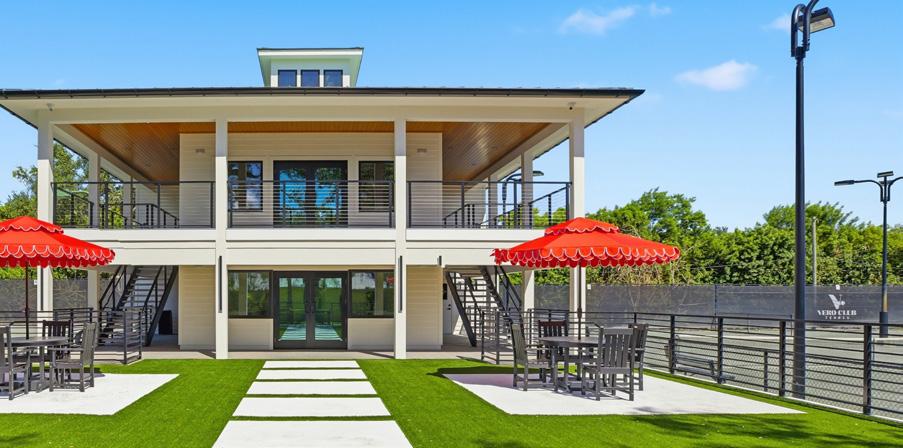

Prinsen by her side as lieutenant. “He said he would,” said Kaye,” and that’s when I told Yohann to take my idea to Alain.” Manly continued: “I knew there were other people interested in buying, but I also knew nobody else would be able to meet Alain’s specific requests. And Alain realized he’d never get a better offer.”
Manly’s background is in medicine. As a newly-graduated registered nurse she moved from her home in California to Seattle, where she worked at Seattle Children’s Hospital, caring for children requiring open heart surgery. From there she went to Harborview Medical Center, assigned to the surgical trauma unit. In 1994, she entered a master’s program to become a nurse anesthetist, her concentration for nearly ten years.
In 2005, she relocated to Dorset, Vermont, and small town close to the New York border. She had come to pursue a life-long love: renovating and remodeling early homes. This particular home—estate, actually—was a family heirloom, passed down through generations. It was also totally decayed—shockingly so. And thus began the slow, gradual, multi-year process of restoring the homestead to its former glory. Notably, across a field was a small tennis facility with clay courts. Her mother in her prime had been an accomplished player. Kaye started to play—she had dabbled as a teenager—and discovered she loved it. A seed was planted (unknowingly) for what would follow.
A few choice things are clear from speaking with Kaye at this point in her life. She moved to Vero Beach in 2021 and absolutely loves it. Alain accepted her offer. She continues to take lessons from Yohann, plays regularly, and describes herself as “a basic intermediate player.” She never intended to purchase a tennis facility—it just happened. She didn’t invest with an eye to making money, “In isolation it is a poor business decision.”
Prinsen, who excelled in international tournaments, winning back-to-back championships in Belgium, is an exceptional tennis trainer, truly passionate about the future of the club, and serves as Director of Tennis. Kaye also brought onboard

another distinguished Vero Beach tennis pro, Christophe Delavault, with 35 years of experience as a master teaching professional, known for his innovative approach to doubles strategy and stroke production.
Over nearly three years, Manly has overhauled what is now called Vero Club Tennis. Across the entirety of this large-scale work-in-progress, the facility was never closed a single day, except for rain. She has completely rebuilt all seven courts; replanted the landscaping; and constructed a highly functional and aesthetically stunning clubhouse.
To wit: The building has a two-story, stylish coastal-modern design. With



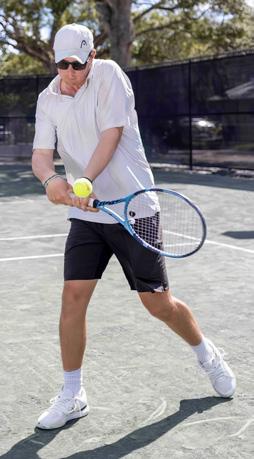
clean, contemporary lines, the white exterior has a large wrap-around balcony enclosed by sleek black metal railings with horizontal cables. The white siding is contrasted by black-framed windows. An expansive balcony displays a warm wooden finish and recessed lighting. The surrounding yard includes elevated terraces, alternating clean, concrete pads with green, artificial turf, conveying an ambiance of luxury and leisure. There is a kitchenette, long group table, flatscreens tuned to tournament tennis, pro shop, equipment room. Spotless and perfectly suited décor—by Kaye.
“The building was designed by me, the concept was mine, and everything that exists today was my creation,” she said. She has always lived by the concept, “If you dream it, you can do it.” She
emphasizes, “It’s never not without work, but you can do it.”
Most importantly—above all else—is the role that Kaye envisions for Vero Club Tennis. She acquired the facility to preserve it for the community. She felt that clubs like this were in many ways a thing of the past, and she wanted to preserve it, to keep it around for future generations to play and love.
She intends to cultivate a friendly, yet competitive environment. Great players can come to compete with peers—players at all levels can do the same. Brand new players are greeted personally by Kaye, and started on an appropriate, supervised pathway to properly learn the sport. Those with a potential interest to join are invited by Kaye for a personalized tour, and afforded an opportunity to “test drive” the club. She screens all applicants to ensure a good fit. She will intentionally limit the membership count to ensure court availability in peak season.
She hopes that players from across Vero Beach will join the community—whether as their sole tennis club or as a secondary place to play for those with other tennis or country club memberships. She offers a smaller, simpler environment. Players can effortlessly get to know one another, and new members will be easily introduced into player groups on their level. The club looks to host tournaments and players from across Florida.
Kaye’s greatest joy is to watch generations of players become exposed to the club and its ambiance and rituals, many loyal members returning in season to make tennis a regular part of their schedule. Kaye appreciates and values history, continuity, a sense of belonging, a place that feels like home. After all, those were the drivers that brought her to where she is in life today.
772-643-0818
1295 6th Avenue
Vero Beach, FL 32960
Instagram: @vero_club_tennis_official Website: veroclubtennis.com
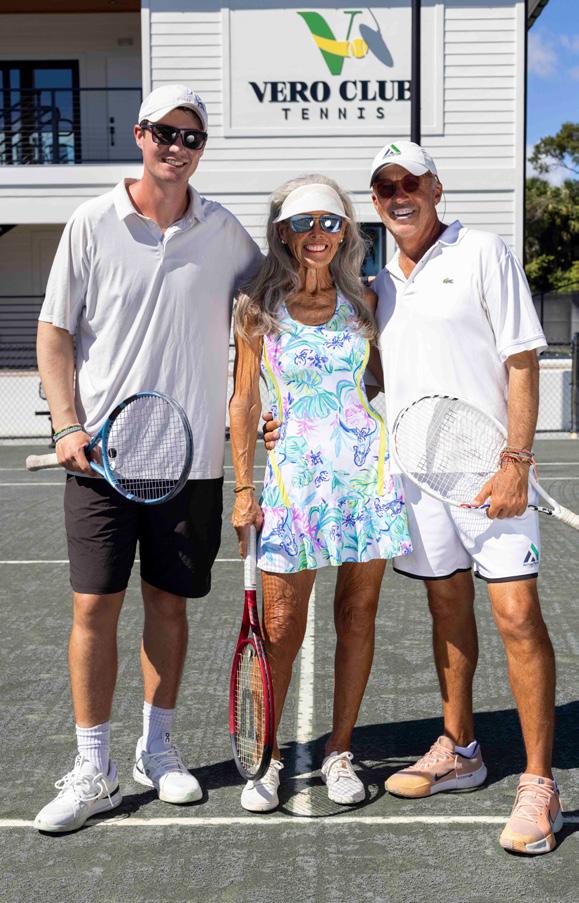







by Monica Jennings
Step into this first grade classroom and you might think you’ve entered a haunted mansion in October, a winter wonderland in December, and maybe even the hottest nightclub in town, complete with a red carpet and the school resource officer playing the doorman.
The room hums with excitement as sixyear-olds rehearse their lines (disguised vocabulary words) with the focus of seasoned performers. But behind the music and laughter is a remarkable act of teaching—one that transforms core lessons in history, culture, reading, and communication into a magical learning experience on stage.
Every year, this first-grade teacher designs an original musical play that her students both study and perform. What begins as a set of academic lessons evolves into a playful, collaborative performance that also gives a peek into Dr. Emma Puttick’s favorite cultural influences from her own growing up. The process not only deepens understanding of classroom content—it helps young learners discover their voices and bond over the power of sharing them.

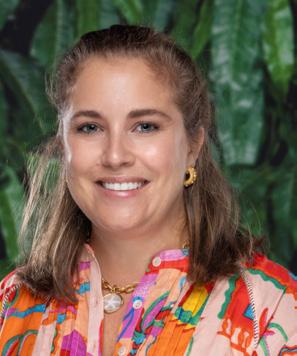

She says, “Each musical is rooted in history or pop culture. Instead of memorizing facts, they embody them—transforming the traditional desk-and-pencil lessons into vibrant storylines that spark imagination. For six-year-olds, this approach turns abstract concepts into something tangible.”
One year, Dr. Puttick’s first-graders took a deep dive into the history of legendary American guitarists. Working closely with colleagues in the art and music departments, Dr. Puttick says “We taught these budding rock stars all about historic events and how they impacted music and art across decades ranging from the 50’s to the 90’s. From Chuck Berry to Johnny Cash, Eddie Van Halen to Jack White, no stone was left unturned as first-graders became experts on legendary American guitarists and the events that helped shape the music they created.” Cross-curricular education was further incorporated as students were tasked with designing their own guitars that were depictions of the decade that they were assigned to.
When performance day arrived, they brought history and language to life by memorizing lines and studying iconic performances through time. Their hard work crescendoed in a show-stopping finale—an electrifying air guitar and lip-sync performance of Guns N Roses’ Sweet Child o’ Mine—that had the audience cheering for an encore.
She continues, “As students prepare for the play, each child works with his or her teacher to develop lines to speak. We coach them on projection, clarity, and expression— introducing the fundamentals of public speaking in a joyful, supportive way. What might feel intimidating in a traditional setting becomes exciting when part of a larger story. Over time, even the quietest students learn to stand tall, look out at an audience, and speak with confidence. The performance becomes a lesson in courage as much as communication.”
The road to opening afternoon is paved with practice. Students rehearse scenes, learn cues, and work together to refine timing and delivery. Through this process, they begin to understand the importance of preparation—the idea that success comes from dedication and teamwork.
Dr. Puttick notes, “Standing on stage under bright lights teaches something no worksheet ever could. Students learn poise, focus, and the joy of shared accomplishment. They discover that stage presence isn’t about perfection—it’s about being proud of who you are and what you’ve created. By the time the curtain rises, each student has grown not just academically, but personally.”
At the heart of it all is reading. Students practice scripts aloud, interpret characters, and connect text with emotion and meaning. Through repetition and performance, fluency blossoms naturally in speaking, writing and reading.
When the play finally debuts before an audience of parents and students, the pride in each child’s eyes says it all. A project that began as a set of classroom lessons has become an unforgettable experience in confidence, connection, and creativity.
Through our musical productions, this first-grade teacher proves that learning doesn’t just happen behind a desk—it happens under the spotlight, too.
After over 15 years in broadcasting, Monica traded deadlines for storylines. Crafting and sharing the stories of the students and adults on Saint Edward’s campus is the best job she never knew existed.
by Joshua McMiller

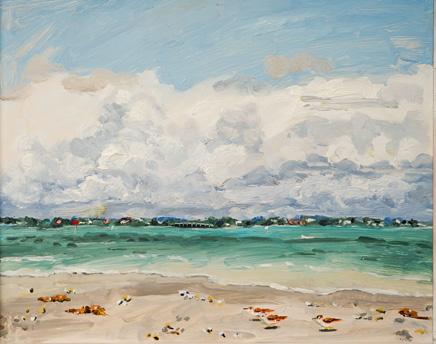
Introducing: LIV VERO Gallery
LIV VERO Gallery is a curated space within each issue dedicated to celebrating fine art and the artists who inspire us, telling stories that resonate with our community and beyond. Each showcased piece is available for purchase; inquiries please contact jim@livvero.com. Art lives here. Let it live with you.
Artist Statement
My paintings emerge from the world I know which include light, gesture, and the quiet poetry of ordinary life. I am drawn to the subtleties of Florida’s landscape: its tangled greens, the sunlight’s contrast, the warmth of people working and being within nature.
Painting for me is an act of attention. It is how I honor the beauty that exists in simple, fleeting moments like a figure reaching for fruit, the bend of a tree, the shimmer of air between leaves.
I work directly with color, letting it guide the rhythm of the brush. Thick, expressive strokes allow the emotion of the scene to surface without over-defining form. What matters is not perfection but the pulse of life that lingers within the paint.
Each canvas is a meditation on presence illuminating how we move through time, memory, and landscape. My hope is that these images invite others to pause, to feel that same quiet joy of seeing, and to remember the grace that exists in everyday moments.
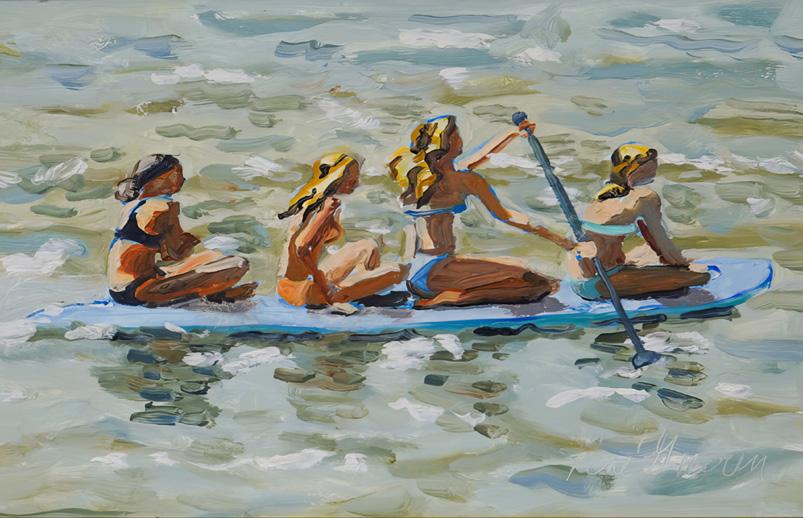
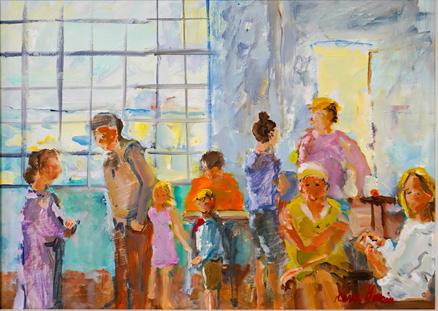
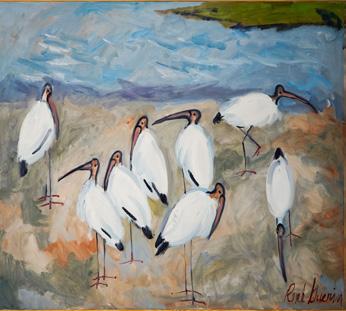
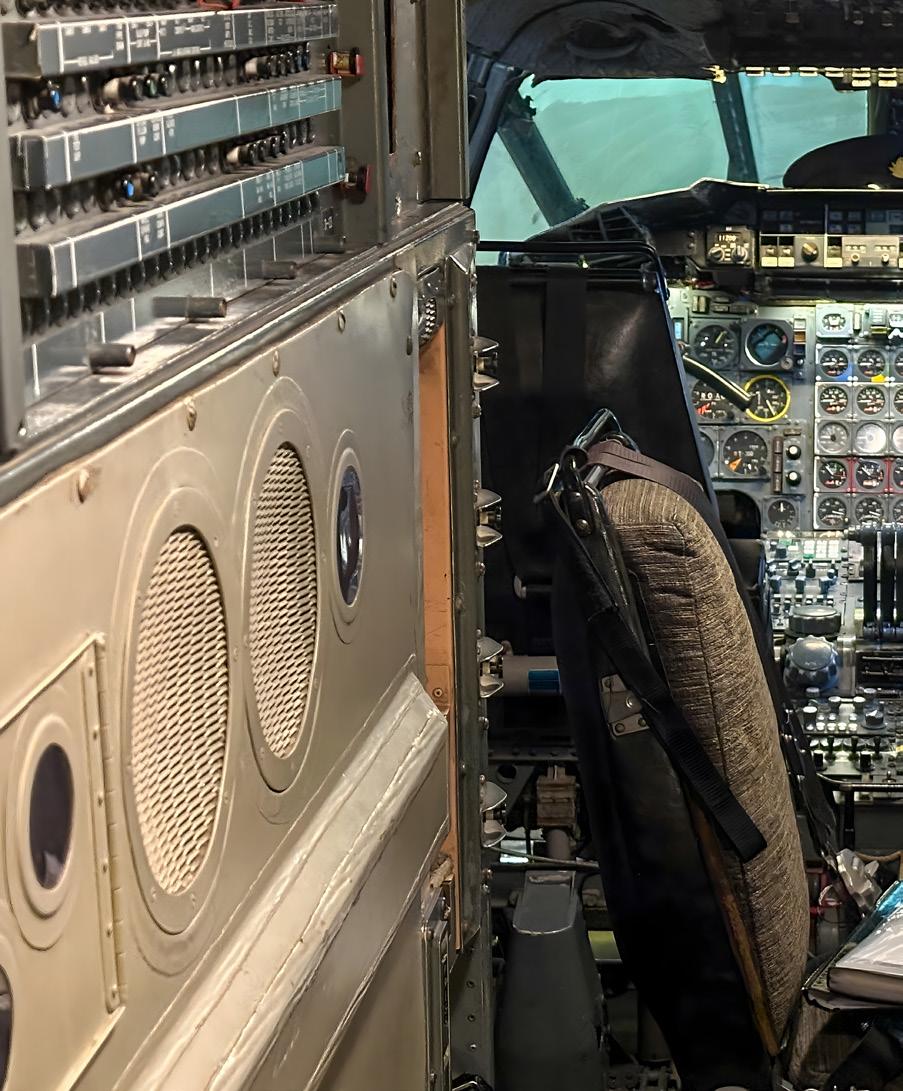

Cockpit interior of an Aerospatiale/BAC
Concorde supersonic aircraft. Concorde first flew in 1969, entered commercial service in 1976, was retired in 2003.

by Mark Wygonik photography by Mark Wygonik
Deciding to travel to Calabria, Italy, to get a better feel for my Italian roots, was the easy part. Figuring out exactly how to get there and what to see was more complex.
Direct flights from Florida to Rome are almost non-existent, with Miami Airport the only departure venue. Instead, I chose to leave through Palm Beach International with a connection in Charlotte, NC, as both airports are much easier to navigate. I was pleasantly surprised to find upgrades for the short leg between Palm Beach and Charlotte to be reasonable, and worth the extra spent for a bit of pampering in first class before that 10-hour overnight haul to Rome.
Once in Rome, with directions from friend and soon-to-be travelling companion, Liz—and my firm belief in carry-on luggage only—I was able to quickly maneuver through Fiumicino Aeroporto and hop onto the Leonardo Express for a 25-minute train ride to Roma Termini (Rome Terminal), where I was to meet up with Liz for our four-hour high-speed train ride aboard Trenitalia’s Frecciarossa (limited stops) from Rome south to Lamezia Terme Centrale, the hub of transportation into Calabria.
We could have flown down, but I wanted the experience of seeing a big city (Naples) and small towns and villages as we hurtled past. Glimpses of Vesuvius to our left; the first sight of the Tyrrhenian Sea on our right; centuries-old ruins dotting the landscape; for me, definitely more interesting than watching another movie on an airplane!
Once we arrived at Lamezia Terme Centrale, we caught a bus for a short ride to the car rental office, where the standard issue was a four-door Audi with all the bells and whistles for just under 500 euros for the week. I got my International Driving Permit, issued through AAA, before I left Vero so I could share the driving.
The winding roads up to small, hidden villages were too challenging for me, but the straight shoreline roads through seaside towns had plenty of roundabouts with clear signage for the most part. And we had a GPS that directed us with a very British accent.
Our first night in Calabria was spent at a beautifully modern, newly renovated

Airbnb in a centuries-old building in the center of Amantea, a small tourist town on the Tyrrhenian Coast. Although it was a peaceful Sunday evening, we enjoyed margherita pizza and spaghetti aglio e olio al fresco at a small trattoria a few blocks away.
The next morning, sunlight streamed through the third-floor windows to wake us. Sitting on the Juliet balcony, we were entertained by the sights and sounds of morning routines below. Cappuccino and cornetti from the corner cafeteria were enough fuel to send us to our next destination, Lago, high in the hills above Amantea, where my Italian grandfather was born, raised, and eventually left to start a new life in America.
Lago greeted us with a city sign in Italian, but with two English words: art and food—words that beautifully capture my passions and hint at the spirit of this charming little haven. Wandering around the town, where art and sculpture are
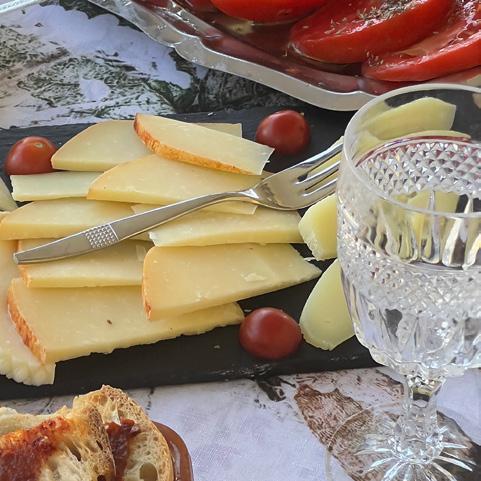



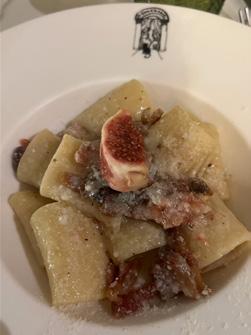
plentiful, we quickly noticed my mother’s father’s family name everywhere: carved in marble on monuments, inscribed in bronze on church donor plaques, and beautifully calligraphied on tombstones.
After a very productive morning with new information and connections, we kept driving east toward the Ionian Coast of Calabria. We visited Monasterace, Gerace, and Locri—ancient Greek towns where my grandmother’s family roots lie. Along the superstrada (expressway), we found service areas filled with fresh pizza, panini, arancini, and more. This is fast food in Italy—and they take it seriously.
We reached the shore of the Ionian Sea mid-afternoon, had a late lunch in Soverato, a resort town now empty since tourist season had just ended. Our next Airbnb awaited us just down the coast in Locri.
Much better priced than impersonal hotels, we chose Airbnbs for the convenience of multiple bedrooms in one unit and proximity to town centers, and were not disappointed throughout our trip.
Locri has a rich cultural history dating back to the 7th century BC. The ruins of the original walled Greek settlement, known as Locri Epizephiri, are impressive and worth visiting. High above the seaside towns are two incredible walled sites I visited because of my grandmother’s heritage. Monasterace and Gerace both feature fortress-like castles, stunning cathedrals, small churches, and expansive views of the towns below and the Ionian Sea beyond. You can see a mixture of Greek, Romanesque, Gothic, and Byzantine elements in the architecture and art. Walking down twisting alleys gives a glimpse into how people lived centuries ago, surrounded by history.
Back on the superstrada, we headed west toward the Tyrrhenian Sea coast for our next two-night stop, Capo Vaticano, just south of Tropea. The small boutique apartment-hotel we chose had all the amenities of a large hotel, yet the intimacy of an Airbnb. It was conveniently located near restaurants, shops, and the beautiful beach, where private chairs and umbrellas awaited us.
We took a day trip south to Scilla, a small seaside town with a history rooted in Greek mythology and Odysseus, where swordfishing is a key part of its nautical heritage. The majestic 11th century Ruffo Castle, with its stunning views of Calabria’s Costa Viola, stands watch over this small but historically important town.
Our next Airbnb in Parghelia, located next to Tropea, was our final two-day stop in Calabria. That week, Tropea hosted its International Film Festival, filling the town with tourists from across Europe and Asia. The atmosphere of this “Pearl of the Tyrrhenian Sea” combines modern energy with a rich history and culture dating back thousands of years.
Tropea Cathedral’s Romanesque architecture reflects its Norman origins. The town’s cliffside position, with golden sand beaches and crystal clear waters below, offers some of the most stunning views in Calabria. The local cuisine is especially notable, with restaurants using the Tropea red onion, known for its unique sweet flavor and vivid red color, which has become a staple in traditional dishes.


On our final full day in Calabria, we drove 30 minutes north along the coast to Pizzo, one of the most scenic cliff-top towns in the Vibo Valentia district. It is home to the impressive Aragonis Castle and the historically important St. George Church. Pizzo is also known for creating tartufo, a multi-layered, truffle-shaped frozen dessert that combines several flavors of gelato with a fruit, nut, or syrup center, all coated in chocolate, pistachio cream, cookie crumbs, nuts, or cocoa powder.
Sunday morning found us heading back to Lamezia Terme to catch the four-hour high-speed Trenitalia train back to Rome. But first, we had booked a three-hour pasta-making class in the hills above Pizzo with Nonna Caterina, where we learned to make traditional local pasta and enjoyed a meal featuring treasures from her garden and kitchen: homemade cheeses, squash blossom fritters, freshly baked bread, newly picked fruits and vegetables and, of course, the pasta we made. Dessert included Nonna’s watermelon granita and her strong limoncello. A very fitting ending to our Calabrian adventure.
Back in Rome for three days, we took advantage of the many galleries and museums scattered around the Eternal City—especially the Borghese Palace Museum, which houses some of Rome’s most iconic paintings and sculptures. Rome also introduced me to the best single pasta dish I’ve ever had the good fortune to taste: paccheri ala gricia with fresh figs, a culinary revelation.
My Italian skills are limited, but I found it helpful to learn and practice common words and phrases during the trip. Saying “Good morning” (Buongiorno!) when entering a business is common courtesy, and being able to say that my Italian heritage was Calabrian (“Sugo Calabrese”) always brought a smile or chuckle from locals. As with any foreign country I visit, it’s worth the effort to meet and talk with locals and learn about their customs and way of life—and for me, to experience their art and food firsthand.
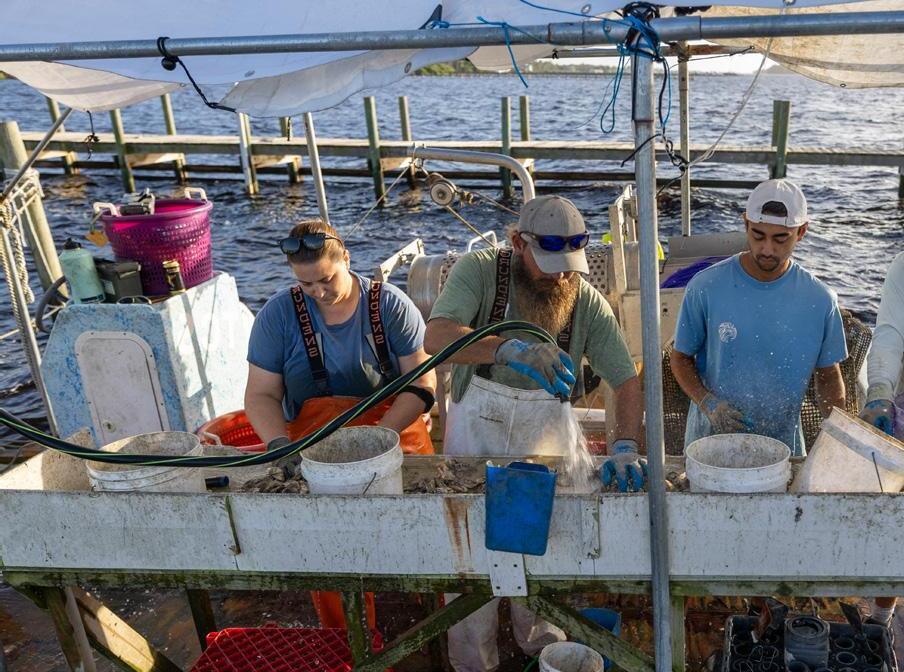
interview with Nicolette Mariano conducted by Jim Field photography by Victoriya Knapp
Editors’ Note: This article brings us through a complete cycle of artisanal farming of Eastern oysters in the Indian River Lagoon for the premium half-shell market. Our July/ August issue showcased the introduction of roughly over a million oyster seeds into the dockside nursery. In September, we profiled husbandry practices at the open water farm in the lagoon—the labor-intensive, meticulous, ongoing care steps taken to maturate their oyster crop into a divine seafood delicacy: clean outer shells, deep cupped, luxurious liquor, sumptuous flesh. Today we celebrated one oyster harvest, of many to follow, of approximately 8,500
oysters for sale and distribution—retail and wholesale—locally in Vero Beach, and more broadly, from St. Augustine to the Florida Keys. Victoriya and I arrived dockside at about 8:00 a.m.; the team was already processing oysters in full swing, having gone out to the farm to load designated bags into the skiff at sunrise.
JF: Harvest Day! So exciting—to reap the benefits of your investment and bring your product to market. Having observed your aquaculture practices, I am deeply impressed by how much work goes into this, how much love you and your team have for what you do.
NM: Turns out, Mother Nature was kind to us over the past few months. The balance of rainfall, air and water temperatures, and abundant food produced ideal growing conditions. As you know, farming is a risky business; it doesn’t always turn out this way. So we’re pleased to be the beneficiaries of good fortune. As you chronicled in the magazine, we worked this crop over many months, chipping their growth edge to get a nice deep cup, desiccating them to mitigate biofouling, grading and inspecting, over and over again. It is wonderful to see what hard work can bring.
JF: Just doing the rough math, you’ve got seven acres of farm, 36 lines of

150 foot length, each line holding 14 floating cages, each cage holding four bags, totaling 2,016 bags, say, about 250 staged market oysters per bag, yielding 504,000 individual oysters. That’s a lot of product. How do you know which oysters you wanted to harvest this morning?
NM: We pre-stage everything. Over the entire growing period we’re constantly grading by size and grouping and regrouping like-sized oysters. I have a map and keep track of bags and where they’re located and how many are in a bag. Having this level of detail allows me to project what I’ve got—and when—for fulfilling orders from this crop.

Keep in mind that we don’t harvest to generate inventory for sale, retail or wholesale. We do the exact opposite: we take in orders and harvest to fill those orders, meaning you’re going to receive oysters that are directly out of the water— the freshest, alive and straight out of the water, most naturally tasting oyster you’re ever going to experience. I can project, when a customer asks for 50 oysters or, perhaps 7,000 for a large family reunion or corporate event, precisely what sizes I’ll have on that calendar date, and we can go ahead and lock in their order and harvest to meet that order. So by having control over every one of your bags, you know exactly where they are, what size they are, and which ones to harvest and when.
A finer point that’s worth mentioning about our husbandry practices—which speaks to our craft and what we do to make our oysters special to us—is that after we size grade the upcoming harvest for the last time—Silver Petites, Sebastian Silvers, and Gold Doubloons—we like to resubmerge them for at least two weeks, giving them a window to re-heal after we handle them— building up their growth lip, ensuring the two shells close tightly with no leaking, just putting finishing touches on them, making them as perfect as we can get them. That’s our equivalent of producing a fine wine.
JF: Watching your production line, I did notice that each team member was tapping the shells of two oysters together. What’s the significance of this?
NM: Sure, we call that clacking. The muscle of an oyster is called the abductor muscle. It holds the two shells together and allows the oyster to open and close. When you eat a raw oyster, the abductor muscle is the small, round, slightly firmer part—often described as the sweet, chewy core of the oyster’s flesh—that was cut when the oyster was shucked. When you clack two oysters together, you’re testing to ensure the oyster is watertight, alive, and full of liquor. If the clack produces a hollow sound, you know the oyster is dead.
JF: And then more formally, you offer three products. Tell me how they are differentiated.
NM: The Sebastian Silver Petites are your 2.0 inch oysters. The Sebastian Silvers are 2.5-2.75 inches in length. And then the Gold
Doubloons are 3.0 inches and longer. They all have a nice uniform shape and a nice deep cup.
JF: Do people tend to prefer one over the other?
NM: Well, people are all different, as you’d expect. Still, I’ve noticed that where we live, people tend to like the larger oyster. Once you go south to Jupiter and Palm Beach, however, it’s more like half and half between our Silvers and Golds. And finally, going further south still to Fort Lauderdale and Miami, they gravitate to Silvers and Silver Petites. I’m just generalizing, of course, but I think that’s a fair observation.
And it will also depend on how you are consuming the oyster. If you’re eating them raw, you may prefer a slightly more delicate size. But for cooking—for example, preparing Oysters Rockefeller—you’ll want more meat, because they’ll cook down a bit and you want a nicely sized fresh oyster
base on a half shell to accommodate and compete with all the tasty fixings—maybe a rich, savory green sauce made with butter, herbs, spinach or other greens.
JF: I know salinity is another important variable that you manage and brings a unique taste to an oyster. Tell me about how this works—and what you prefer.
NM: Yes, so where we’re located in Sebastian in the lagoon, we experience tidal flushing twice a day, water moving in and out of the Sebastian Inlet. Actually, we’re very fortunate to be located exactly where we are, because this movement of water is such a beautiful, vital, valuable phenomenon. Our salinity averages about 28 parts per thousand (ppt) year round. Wednesday, when we harvested, it was 25 ppt. This is the first time all year I’ve seen it in the 20s. In June, we were in the mid30s, because we weren’t getting any rain. Once the rain started, the salinity dropped




steadily. So rain is a major factor. Keep in mind, high temperatures and high salinity stress oysters.
Now, the strength of your tidal action also changes, meaning the amount of sea water flushing will also change across the calendar. Because the farm is in the wider part of the lagoon, we see a lot of good movement of water going in and out, which is consistently moving and healthy. Your food source—algae, an aquatic plant—is primarily in the lagoon because it’s a brackish water estuary—brackish meaning water with a mix of salt and fresh water— it’s less salty than the ocean, but saltier than freshwater—perfect for oysters and other aquatic species.
For me, I like our salinity around 28-30 ppt—if I could select my perfect numbers. The liquid in the shell—the liquor, as it is referred to—has just a faint bite to the taste—that perfect hint by taste and smell of the ocean. And that’s the essence of the perfect oyster—you are eating the flesh and liquor of a true aquatic delicacy, a gourmet shellfish prized across the globe.
JF: You’ve worked up north with oyster farms, do they prefer a different salinity up there?
NM: Well, it’s interesting. When I worked in Cape Cod, on oyster farms near the peat marshes, some farmers would grow their oysters in one specific area, especially in winter, where the ice melt comes slowly through the peat marshes and there’d be these freshwater upwellings, and then they’d move the oysters to another area to finish the oysters off, where there’d be higher salinity. So each farm has its preference—their ideal salinity number— maybe the way vintners tweak their alcohol levels.
JF: Okay, you were going to tell me about pea crabs. I don’t know anything about them. Why don’t we close our conversation with this new piece of learning to add to my rather thin veneer of aquaculture knowledge. NM: So pea crabs are usually found on the gills of the oyster, and they can’t live outside the oyster. They’re called pea crabs—you guessed it—because they’re roughly the size of a pea. Pea crabs are a sign of good luck and indicative of a healthy growing area where the oyster

lives. They’re a soft-shell crab that has a little crunch to it and similar flavor profile to the oyster. So when you open an oyster, you might find a delicious pea crab in there. Simply take your oyster knife and lift the small flap of flesh blanketing the gills, and see if there’s one there. It’s a little morsel of extra luck.
Retail customers can order directly online and pick up that week. All dates, prices, and details are on the website.

Treasure Coast Shellfish
735 Commerce Center Drive Suite A Sebastian, FL
Phone: 772-918-8753
Email: info@treasurecoastshellfish.com
Website: treasurecoastshellfish.com
Kiwanis Presents: Jazz Through the Ages
Saturday, 12 pm
Join the Vero Beach Yacht Club on a musical journey that takes you through a world of jazz. Tickets are available on their website: verobeachyachtclub.com, 772.231.2211
Marine Wildlife Art & Craft Festival and Treasure Coast Seafood Festival
Saturday and Sunday, 9 am to 5 pm
Hosted annually at the Indian River Country Fairgrounds, enjoy Marine Wildlife Art showcases and displays, photography, paintings, drawings, and crafts, along with fresh seafood provided by the festival’s co-host: Treasure Coast Seafood Festival. This collaborative festival event is a great opportunity to engage with Vero’s community coastal culture with family and friends. treasurecoastseafoodfest. com, 954.205.7813
Treasure Coast Monster Car Swap Meet & Car Show
Saturday and Sunday, 9 am to 2 pm
Indian River Country Fairground’s third and fourth festival events to compliment this jam-packed family fun weekend to start the month. With 129 acres of classic cars, trucks, vendors, car swap meet, music, raffles, and prizes, this weekend long event adds even more of a variety of fun to the co-hosted festival weekend. flcarswapmeets.com, 954.205.7813
Art in the Park
Sunday, 10 am to 4 pm
It’s that time of the season for the 44th year in a row, when Vero Beach Art Club debuts its Fine Arts & Crafts Exhibit to Ocean Drive, Humiston Park in Vero Beach, Florida. A culturally immersive opportunity for visitors and residents to appreciate the visual, creative, and original displays by local artists and craft artisans. Various work is available for viewing and purchasing such as oil, acrylic, watercolor, pastel paintings, collage wall art, photography, digital art, pottery, ceramics, jewelry, glass work, sculpture, mixed media, wood, and other select crafts. verobeachartclub.org, 772.231.0303
TED x Vero Beach
Sunday, 2 to 6 pm
Hosted at the Emerson Center, engage in a days’ worth of ideas and conversations with 12 visionary speakers during Ted x Vero Beach’s 2025 theme: “Breaking Barriers: Systems That Challenge the Status Quo”. Speeches from worldrenowned champions, educators, and pioneering minds at the forefront of AI technology. Guests will be provided with gourmet hors d’oeuvres, fine wine and beverages, and live performances from the talented students of Indian River Charter High School. This event is an insightful opportunity to educate yourself on new topics and groundbreaking ideas, or to entertain curiosity and further thinking. To learn more about topics and this event’s speaker roster, visit their website below. tedxvero.com, 772.766.6510
Vero Beach Museum Babies and Toddlers
Tuesday, 9:30 to 10:30 am
Caregivers and their children are offered a playfully filled sensory experience at the Vero Beach Museum of Art. Museum toddlers and babies have the opportunity to participate in the museum’s galleries and include an art activity. A creative and fulfilling bonding experience for children and caregivers to connect with art. vbmuseum.org, 772.231.0707
Vero Vintage VW Night: Walking Tree Brewery
Tuesday, 5 to 8 pm
Grab a brew and enjoy a display of vintage Volkswagens at Walking Tree Brewery. Connect with other Volkswagen lovers within your community and the surrounding area this first Tuesday of the month. More information can be found on their website. walkingtreebrewery.com, 772.217.3502
Riverside Theatre: Little Shop of Horrors
Tuesday, 7:30 to 9:30 pm
A delightfully funny science fiction and pop/rock themed musical by Alan Menken and Howard Ashman. Centered around a flower shop assistant, Seymour, who discovers a strange plant on his way home. Realizing the plant’s potential for fame and fortune, Seymour names the plant after the woman he fancies at the flower shop. Only to soon discover the plant’s developing and unquenchable thirst for human blood, Seymour must find a way to get the girl and satisfy the plant with a unique and deadly agenda of its own. riversidetheatre.com, 772.231.6990
Painted Sky Farms: Flower U-Pick and Full Moon Yoga
Wednesday, 6:30 pm
Touch grass and connect with nature with a Flower U-Pick at Painted Sky Farms. This scheduled event also offers a full moon yoga class. A very grounding yet liberating experience that allows guests to unwind under the full moon but also take home a hand-picked personalized bouquet. Tickets are available on their website: paintedskyvero.com, 772.766.3391
The Heritage Center: 33rd Annual Soup Bowl- Pick a Bowl, Help a Family
Thursday, 9 am to 7 pm
Contribute to homeless families with the affordable purchase of uniquely and authentically handcrafted soup bowls and servings of a variety of home-made soups from renowned country club chefs. From 1,000 soup bowls to choose from that are hand crafted by local potters with love, artists from Indian River Clay offer a charitable opportunity to accentuate your at-home plate collection, while also helping support families in need in Indian River Country, and transitional housing. Proceeds benefit the Samaritan Center. ccdpb.org, 772.770.3039
Gallery Stroll: Vero Beach Art Club
Friday, 5 to 8 pm
Join the Vero Beach Art Club this first Friday of the month for 2025, with participating galleries in our historic downtown art district. The Vero Beach Historic Downtown Art District opens their doors to the public during this event to witness visual art displays. This is a great opportunity for members who have their pieces in the gallery or marketplace to share their art pieces with the community. verobeachartclub.org, 772.231.0303
40th Annual Navy SEAL Museum
Muster & Music Festival: November 7-8.
Friday 2 to 9 pm, Saturday 8 am to 4 pm
Experience a celebration of gratitude for the men that trained on the beaches in Fort Pierce that contributed to our American history. Friday’s event offers live music, Mission BBQ and USMI Low Country Boil, and a full mobile bar provided by Little Jim. Which translates into Saturday’s 5k Beach Challenge event, Muster Ceremony, guest speakers, food trucks, face-painting, and much more. navysealmuseum.org, 772.595.5845
6TH through 15TH 7 TH through 9TH
The Vero Beach Theatre Guild’s ‘Blackbox After Dark’: The Last Five Years
Thursday Friday Saturday 8 pm
The Vero Beach Theatre Guild’s series ‘Blackbox After Dark’, returns debuting the theatre performance that follows an emotional journey of love in: The Last Five Years. A perfect event for date night, this intimate musical follows the highs and lows of a relationship with hope and heartache, in a language of powerful music and touching performances. Times and ticket information are available on their website: verobeachtheatreguild. com, 772.562.8300
Fest
Friday through Sunday
Join the community of Vero Beach in the historic Downtown Main Street location as artists transform blank walls into vibrant storytelling landmarks right in front of your eyes. This weekend long event celebrates the culture, history and spirit of our community. With pop-up murals, live music, food and drink specials from local restaurants, and raffles, there is a variety of entertainment throughout this event. mainstreetverobeach. org, 772.643.6782
Playtime in the Park: Theatre Edition
Saturday 11 am
Riverside Theatre hosts free dance and theatre offerings at this event for ages 2-5 and entertainment for the whole family. Throughout the shows, young audience members will be encouraged to join the stories in creative and immersive ways. riversidetheatre.com, 772.231.6990
Beachside Bonfire Fest
Saturday, 5 to 9 pm
Connect with our community as the cooler weather approaches at Vero Beach’s Annual Beachside Bonfire Fest held on Ocean Drive. Five establishments that locals know and love, will be hosting their own bonfires on their beaches and offer music, themed parties, food and drinks, as well as a raffle. Visit all five bonfires for the selected businesses listed on their website below. verobeach.com, 772.231.8441
Vero Beach Elks Lodge: Veterans Day Dinner Dance
Tuesday (Veterans Day) 4 pm
Join the Elks Lodge in their traditionally hosted free ceremony and dinner dance for local veterans this Veterans Day. With traditionally 250 attendees, this is a great opportunity to connect with those in your community and celebrate the dedication of your fellow soldiers that so bravely served our country. veroelks.com
Alzheimer & Parkinson
Association of IRC: Walk to Remember
Saturday, 7:30 am
Hosted at Riverside Park, support your community and local programs that assist families affected by memory and movement disorders while getting your steps outdoors. Registration begins at 7:30 am before the walk at 9 am. alzpark.org, 772.563.0505
Vero Beach Museum of Art Fall Collaboration: Reflections
Saturday, 12 and 3 pm
Witness art come to life and experience an unforgettable performance by Ballet Vero Beach and the Vero Beach Museum of Art in this year’s Fall Collaboration event: Reflections. Featuring original choreography of interpretive dance where movement meets imagery that shows themes of identity and expression that will be found in the museum’s Fall Exhibition: Double Portraits. More information can be found on their website: balletverobeach.org, 772.269.10655
Vero Beach Chamber: Sunset Saturdays: Beachside Saturdays, 5 to 8 pm Sunset Saturdays Oceanside Concert Series is here starting in November and continuing into December for the second Saturday of each month until May. Enjoy live music, food vendors, and a laidback family-friendly vibe with your own lawn chair or blanket, along with the sounds of our community by the beach. verochamber.com, 772.226.5459
22TH through 23TH
Saturday 10 am to 5 pm, Sunday 10 am to 4 pm
Hosted at the Indian River Country Fairgrounds, enjoy hundreds of booths along with live music areas, food vendors, beverages, and a kids zone. Support handmade artists and crafters with the wide selection of beautifully and carefully curated and crafted pieces. artandcraftexpo.com, 772.492.6105
22TH 23TH
Art in the Park
Sunday, 10 am to 4 pm
It’s that time of the season for the 44th year in a row, when Vero Beach Art Club debuts its Fine Arts & Crafts Exhibit to Ocean Drive, Humiston Park in Vero Beach, Florida. A culturally immersive opportunity for visitors and residents to appreciate the visual, creative, and original displays by local artists and craft artisans. Various work is available for viewing and purchasing such as oil, acrylic, watercolor, pastel paintings, collage wall art, photography, digital art, pottery, ceramics, jewelry, glass work, sculpture, mixed media, wood, and other select crafts. verobeachartclub.org, 772.231.0303
5TH
5TH through 21TH 15TH
Gallery Stroll: Vero Beach Art Club
Friday, 5 to 8 pm
Join the Vero Beach Art Club this last first Friday of the month for 2025, with participating galleries in our historic downtown art district. The Vero Beach Historic Downtown Art District opens their doors to the public during this event to witness visual art displays. This is a great opportunity for members who have their pieces in the gallery or marketplace to share their art pieces with the community. verobeachartclub.org, 772.231.0303
Tree Lighting Festival: Pocahontas Park
Saturday, 2 to 6 pm
Kick off the community Christmas festivities with Indian River County’s Chamber of Commerce in their 3rd annual Tree Lighting Festival in Downtown Vero Beach. Including live local performances, food trucks, Holiday craft vendors, children’s activities, pictures with Santa, and a magical bubble show. More information is available on their website: indianriverchamber. com, 772.567.3491
A Christmas Carol: The Musical 2 pm and 7:30 pm
Enjoy a musical version of this traditional Christmas tale where Ebenezer Scrooge is taken on a magical journey of redemption through a series of musical numbers. This performance at the Vero Beach Theatre Guild of the beloved Christmas classic, is a perfect weekend evening event for the whole family. Calendar dates for showings are listed on their website: verobeachtheatreguild.com, 772.562.8300
27 TH 6TH
18th Annual Trot Against Poverty
Thursday (Thanksgiving), 7:30 am
Start your Thanksgiving morning this year on the right foot alongside your community in support of United Against Poverty. This 5k welcomes all skill levels and ages. Join 2,000+ trotters and Turkey
Tom in a good workout at our beloved Riverside Park, before your dinner plans this Thanksgiving. Registration information is available on their website: trotagainstpoverty. org, 772.564.9365
Peterson Groves: First Annual Christmas Market
Saturday, 10 am to 3 pm
Visit local vendors, eat delicious treats and goodies, and shop local products at Peterson Groves’ First Annual Christmas Market. This Christmas themed holiday event is a great opportunity to bring your family outdoors. More information and details will be available soon on their website: petersongroves.com 772.562.6900
Vero Beach Christmas Parade: Ocean Drive
Saturday, 6 pm
The holiday spirit rolls around with this annual Vero Beach community holiday event held Beachside on Ocean Drive. Hosted by the Sunrise Rotary of Vero Beach, local businesses and sponsors display their colorfully decorative floats. Bring your lawn chair, blankets, friends and family, and support local businesses and sponsors and this festively fun event. verobeachchristmasparade.org, Chair, Kristin Jewell 803.381.8355
9th Annual Winter Bazaar:
Walking Tree Brewery
Sunday, 12 pm
Walking Tree Brewery’s Annual Winter Bazaar hosts a collection of independent artisans and creatives for all your holiday gift giving necessities. This event offers festive holiday products, food, live music, the Treasure Coasts largest Christmas Tree, and Santa Claus. More information can be found on their website: walkingtreebrewery.com, 772.217.3502
Atlantic Classical Orchestra: Home for the Holidays
Sunday, 4 to 7 pm
The Atlantic Classical Orchestra is coming to Vero Beach and invites you this holiday to their 3rd annual ‘Home for the Holidays’ concert event. Held at St. Edwards School Waxlax Center, enjoy the warmth of live holiday music such as orchestral performances and holiday carols. atlanticclassicalorchestra.com, 772.460.0851
Ballet Vero Beach: Nutcracker on the Indian River
Thursday Friday and Saturday
December 11th and 12th 7:30 pm
December 13th 2 pm
View the whimsical performance of the classic holiday tale: ‘The Nutcracker’, with a twist, by Ballet Vero Beach. Hosted at Riverside Theatre, join Marie in this Florida themed version of the Nutcracker, on her holiday journey from New York to Florida. Featuring numbers in Fifth Avenue Mansions, Grand Central Station, and characters inspired by the Indian River Lagoon such as manatees, land crabs, florals, river otters, and bougainvillea. This unique performance draws from the classical holiday tale and inspires audiences with themes so familiar to Florida that residents and visitors love and appreciate. balletverobeach.org, 772.269.2065
Trans-Siberian Orchestra: The Prophecy Show. December 11. Thursday, 7 to 9 pm Hosted at the Emerson Center, experience a lively performance tribute to the world renowned Trans-Siberian Orchestra (TSO). The Prophecy Show brings the excitement and electricity of the TSP’s iconic holiday rock opera to Vero Beach. Featuring classically trained musicians, dazzling costumes, synchronized choreography and colorful stage effects such as lasers and fog, that deliver an immersive experience for audience members throughout this musical journey. theemersoncenter. com, 772.778.5249
Holidays at the Museum: Vero Beach Museum of Art
Saturday, 10 am to 3 pm
Celebrate with the whole family at the Vero Beach Museum of Art during this holiday event. Enjoy and participate in art-making activities led by museum instructors and local art teachers, music and dance live performances, food trucks and vendors, and free admission to the museum’s current exhibitions. vbmuseum.org, 772.231.0707
Vero Beach Outlets 2nd Annual Holiday Bazaar
Saturday 10 am to 5 pm, Sunday 10 am to 4 pm
Enjoy a selection of 120 booths of festive and holiday themed handcrafted products and art & crafts in the Vero Beach Outlets shopping center. Featuring live music, shopping, adult beverages, and food vendors. verobeachoutlets.com, 772.770.6097
Candlelight: Christmas Carols on Strings
Friday, 6:30 pm and 8:30 pm
Hosted at the Community Church of Vero Beach, this live series comes to town with an absolutely stunning display of an intimately candle-lit stage. With string quartet performances of traditional and popular Christmas carols that your family can enjoy. Tickets and more information are provided on their website: feverup.com, 772.562.3633
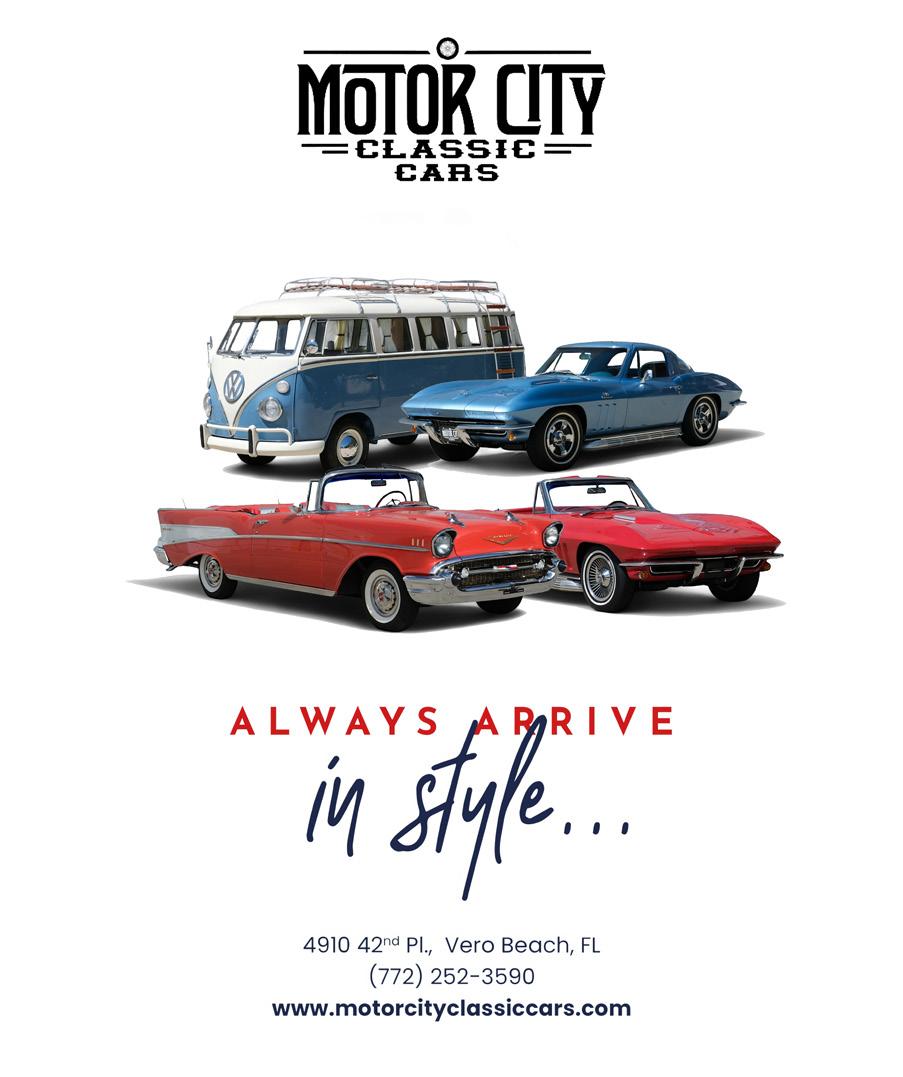

A Moment’s Notice Health Care amnhc.com
THANK YOU FOR SUPPORTING OUR LOCAL PARTNERS
Aiello Landscape aiellolandscape.com
Alexandra Nuttall Design alexandranuttall.com
We would like to express our heartfelt thanks to our advertisers and subscribers for their incredible support. We’re excited to continue sharing unique stories and providing a platform where you can proudly advertise. Here’s to growth and collaboration!
AR Homes arhomesverobeach.com
Coastal Interiors coastal.net
Dale Sorensen Real Estate Inc. Lori Davis Loritdavis.com
We would like to express our heartfelt thanks to our advertisers and subscribers for their incredible support in 2024. As we step into 2025, we’re excited to continue sharing unique stories and providing a platform where you can proudly advertise. Here’s to another year of growth and collaboration!
Design Collaborative 772-999-2155
Decor Accents decoraccentsvero.com
Distinctive Cabinetry Designs distinctivecabdesign.com
Premier Estate Properties Brown Talley Group browntalleygroup.info
Prism Capital 772-200-3973
Reilly Construction building2last.com
Melanie Bock Studios melaniebockstudios.com
REsistance Cycle & Strength resistancevb.com
Audiohouse, The theaudiohouse.com
A Moment’s Notice Health Care amnhc.com
Alexandra Nuttall Design alexandranuttall.com
Coastal Illumination Landscape Lighting coastalillumination.com
Align Aesthetics & Wellness alignmedicalaesthetics.com
Coastal Interiors coastal.net
AR Homes arhomesverobeach.com
Compass, The Reynolds Team Scott Reynolds, Team Leader myreynoldsteam.com
Berkshire Hathaway HomeServices
Sherry Goff, Luxury Coastal Specialist sherrysellsvero@gmail.com
CrossCountry Mortgage The Denton-McCrae Group crosscountrymortgage.com
Caldwell Trust Company ctrust.com
Capritta Appliance & Air Conditioning caprittafinelines.com
Design Collaborative 772-999-2155
Engel & Völkers
Vero Beach, Hutchinson Island Claire Higgins, Broker verobeach.evrealestate.com
Engel & Völkers Vero Beach Claire Higgins, Broker verobeach.evrealestate.com
Engel & Völkers Vero Beach
Halle Dold halle.dold@evrealestate.com
Engel & Völkers Vero Beach Halle Dold halle.dold@evrealestate.com
Engel & Völkers Vero Beach Diane Field dianefieldrealtor.com
Engel & Völkers Vero Beach Diane Field dianefieldrealtor.com
Florida Shutters floridashuttersinc.com
HBS - Impact Windows & Doors hbsglass.com
Engel & Völkers Meadowood Thomas Panos thomas.panos@evrealestate.com
Hudson Advisors hudsonadvisors.com
Florida Shutters floridashuttersinc.com
Jennifer D. Peshke, Law Offices of peshkelaw.com
GFM Handyman 772-633-2976
KMK Builders kmkbuildersllc.com
HBS - Impact Windows & Doors hbsglass.com
Louden Bonded Pools loudenpools.com
Inspired Closets inspiredclosetstc.com
LPL Creations lplcreations.com
M Bakeri mbakerillc.com
Joey & Kimmy’s Seafood Market & Restaurant joeyandkimmys.com
O’Dare Boga Dobson Group odareboga.com
O’Dare Boga Dobson Group odareboga.com
Rise Modern Wellness risemodernwellness.com
Saint Edward’s School steds.org
Moorings Real Estate Co. Marsha Sherry, Broker themoorings.com
Sassy Boutique sassyboutique.com
Premier Estate Properties Allison Ritter browntalleygroup.info
Scott Tree Services scotttreeservices.com
Reilly Construction building2last.com
Sew Easy seweasyvero.com
Scott Tree Services scotttreeservices.com
Tocqueville Asset Management tocqueville.com
Tocqueville Asset Management tocqueville.com
Varietals and More varietalsandmore.com
VB Private Jewelers vbprivatejewelers.com
Varietals & More varietalsandmore.com
Vero Beach Pavers vbpavers.com
Vero Beach Pavers vbpavers.com
Vero Fitness verofitness.fit
Vero Custom Cabinets verocustomcabinetry.com
Vero Glass veroglass.com
Vero Glass veroglass.com
Vino Vero vinoverobeach.com
Collaboration thrives through genuine friendships

It’s a wrap! The dinner party breaks before it even begins at 906 Seagrape Lane.


